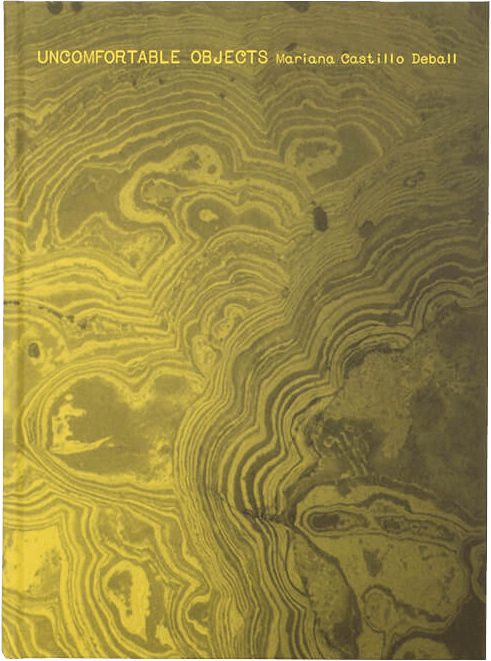Uncomfortable Objects
dOCUMENTA (13), Kassel, 2012
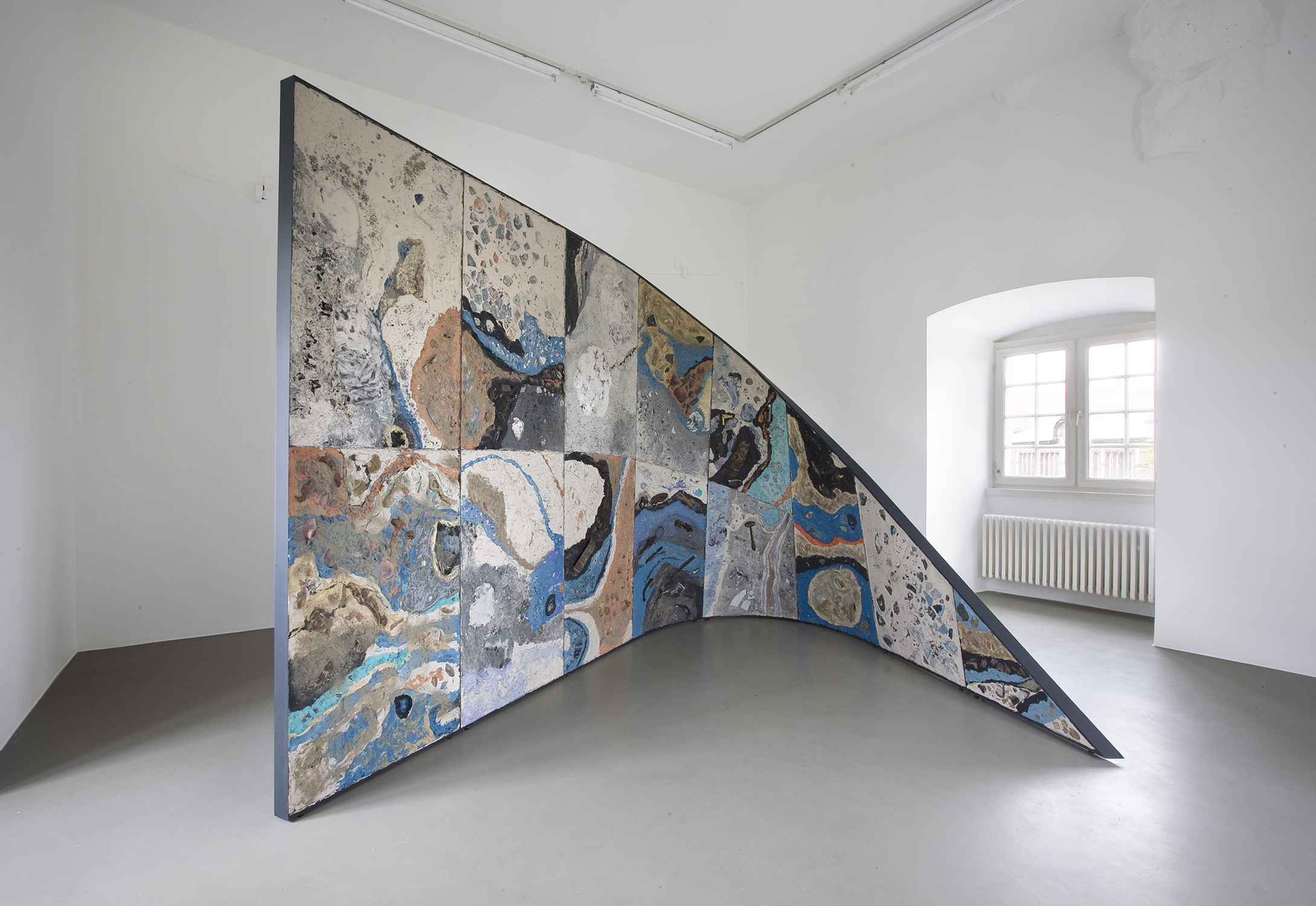
Uncomfortable Objects, 2012,
Plaster, pigments, stones, shells, masks, fabric, glass, wood, clay and diverse objects mounted on a steel frame.
Uncomfortable Objects imagines a moment when the subject takes on the position of the object – imagines its voice, texture, temporality, and taste. In this scenario, the subject and the object are bound together in such a way that any alteration to the object of study resonates with the subject, resulting in reciprocal transformation.
Our contemporary society is crowded with uncomfortable objects. Products of desire, research, or imagination, they trigger our conception of the world and compel us to take a position to completely change our basic understanding of the universe.
What do non-humans have to say about the world we have constructed around them? About our definitions, our manipulations, and uses of it? What is left of objects after so much historical maneuvering, and what would their testimonies be if they could tell us their own stories from their own perspectives?
dOCUMENTA (13) was curated by Carolyn Christov-Bakargiev
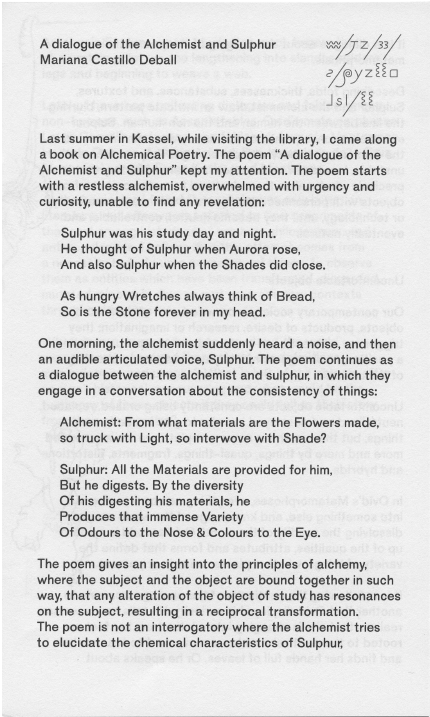
Excerpt: “A dialogue of the Alchemist and Sulphur” in: Mariana Castillo Deball, Finding Oneself Outside: Uncomfortable Objects, Bom Dia Boa Tarde Boa Noite, Berlin, 2012
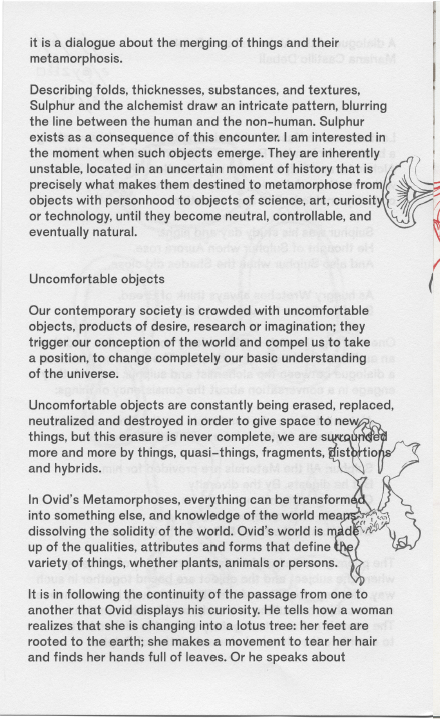
Excerpt: “A dialogue of the Alchemist and Sulphur” in: Mariana Castillo Deball, Finding Oneself Outside: Uncomfortable Objects, Bom Dia Boa Tarde Boa Noite, Berlin, 2012
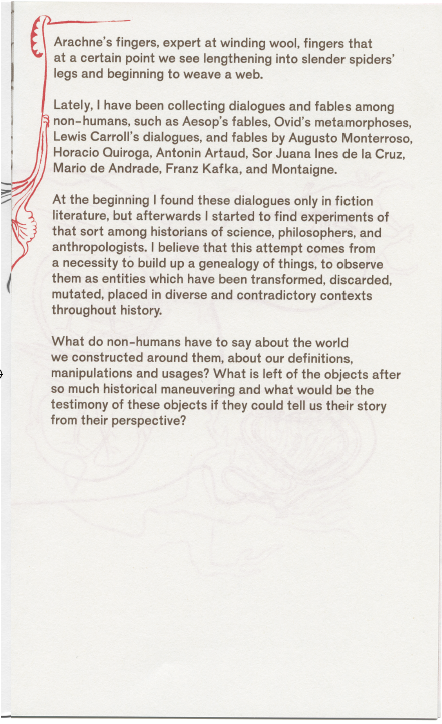
Excerpt: “A dialogue of the Alchemist and Sulphur” in: Mariana Castillo Deball, Finding Oneself Outside: Uncomfortable Objects, Bom Dia Boa Tarde Boa Noite, Berlin, 2012
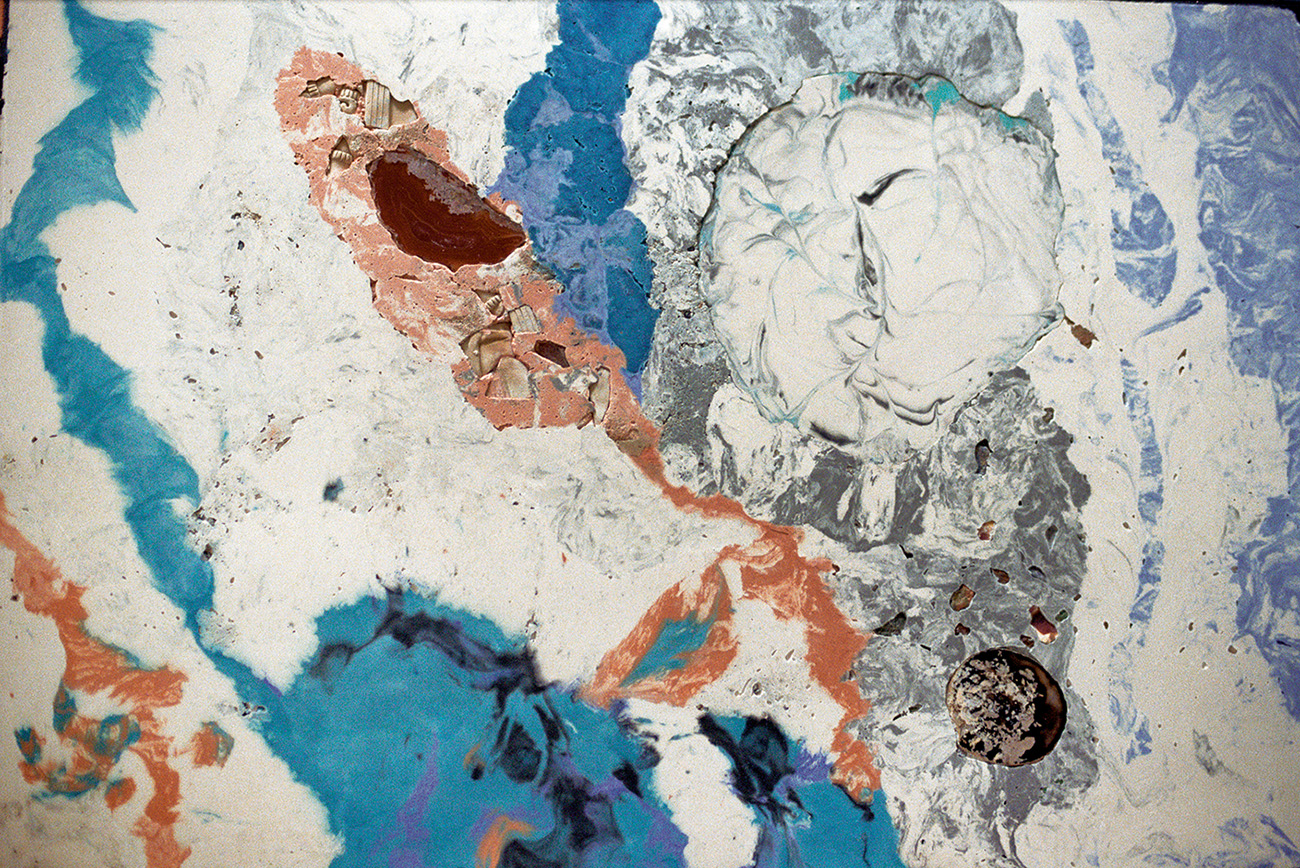
Detail: Uncomfortable Objects, 2012
Plaster, pigments, stones, shells, masks, fabric, glass, wood, clay and diverse objects mounted on a steel frame.
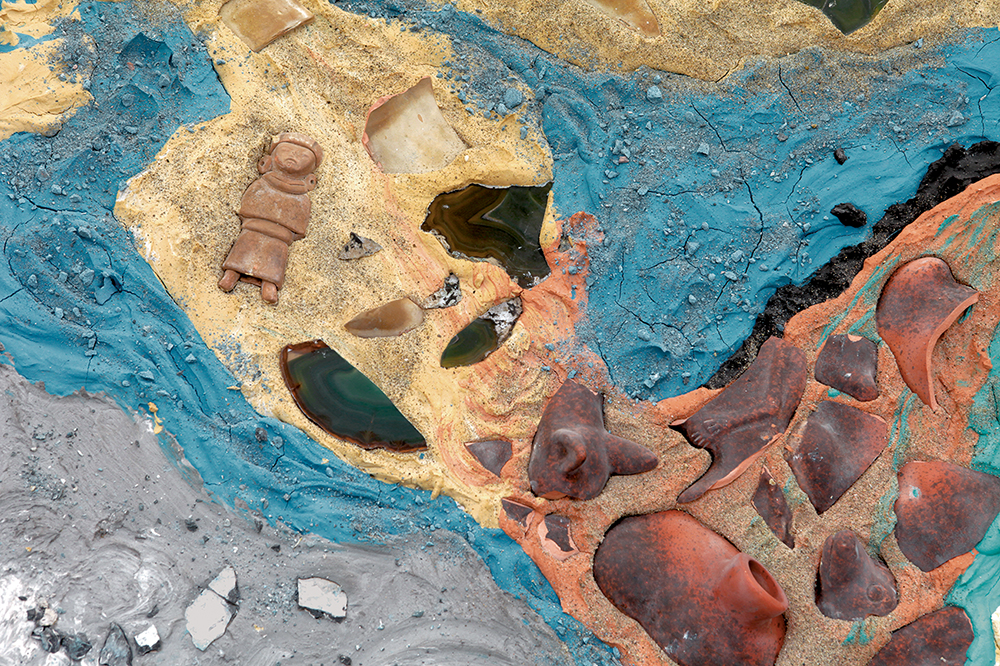
Detail: Uncomfortable Objects, 2012
Plaster, pigments, stones, shells, masks, fabric, glass, wood, clay and diverse objects mounted on a steel frame.
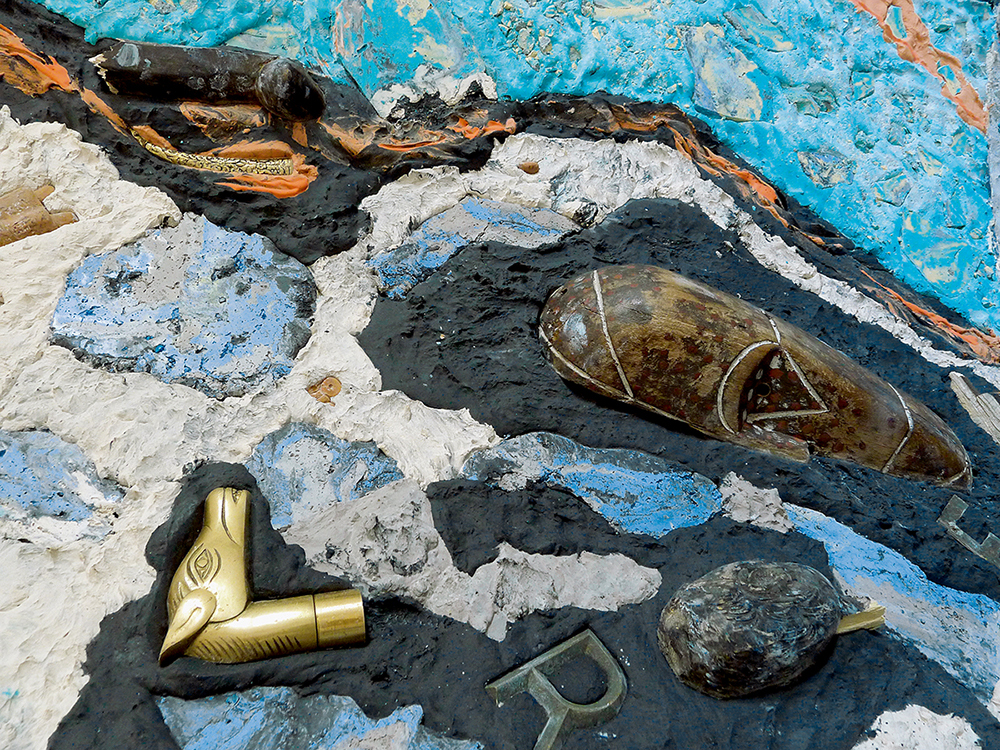
Detail: Uncomfortable Objects, 2012
Plaster, pigments, stones, shells, masks, fabric, glass, wood, clay and diverse objects mounted on a steel frame.
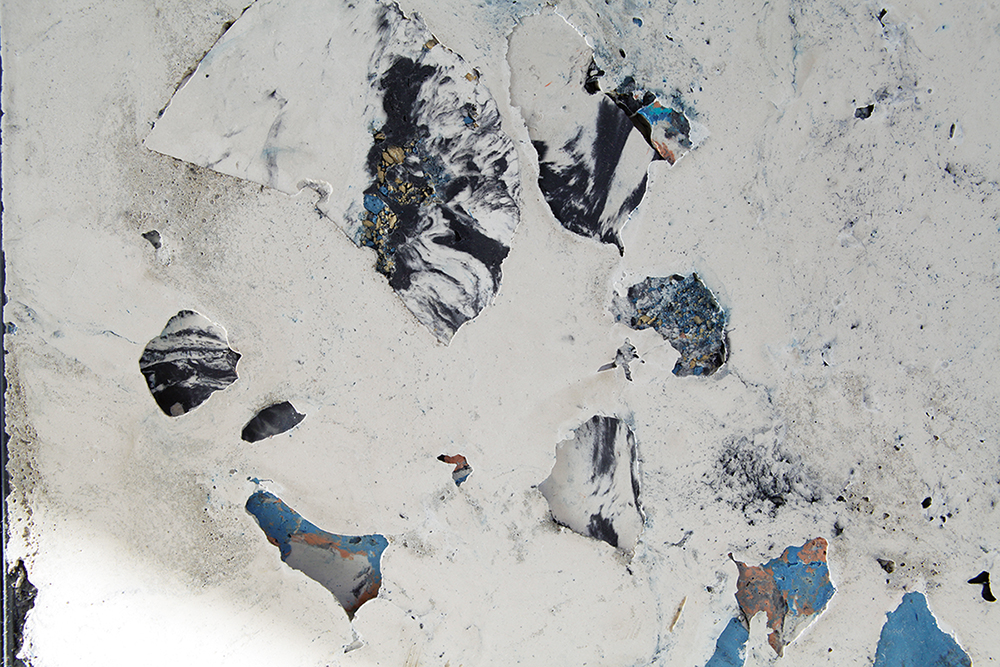
Detail: Uncomfortable Objects, 2012
Plaster, pigments, stones, shells, masks, fabric, glass, wood, clay and diverse objects mounted on a steel frame.
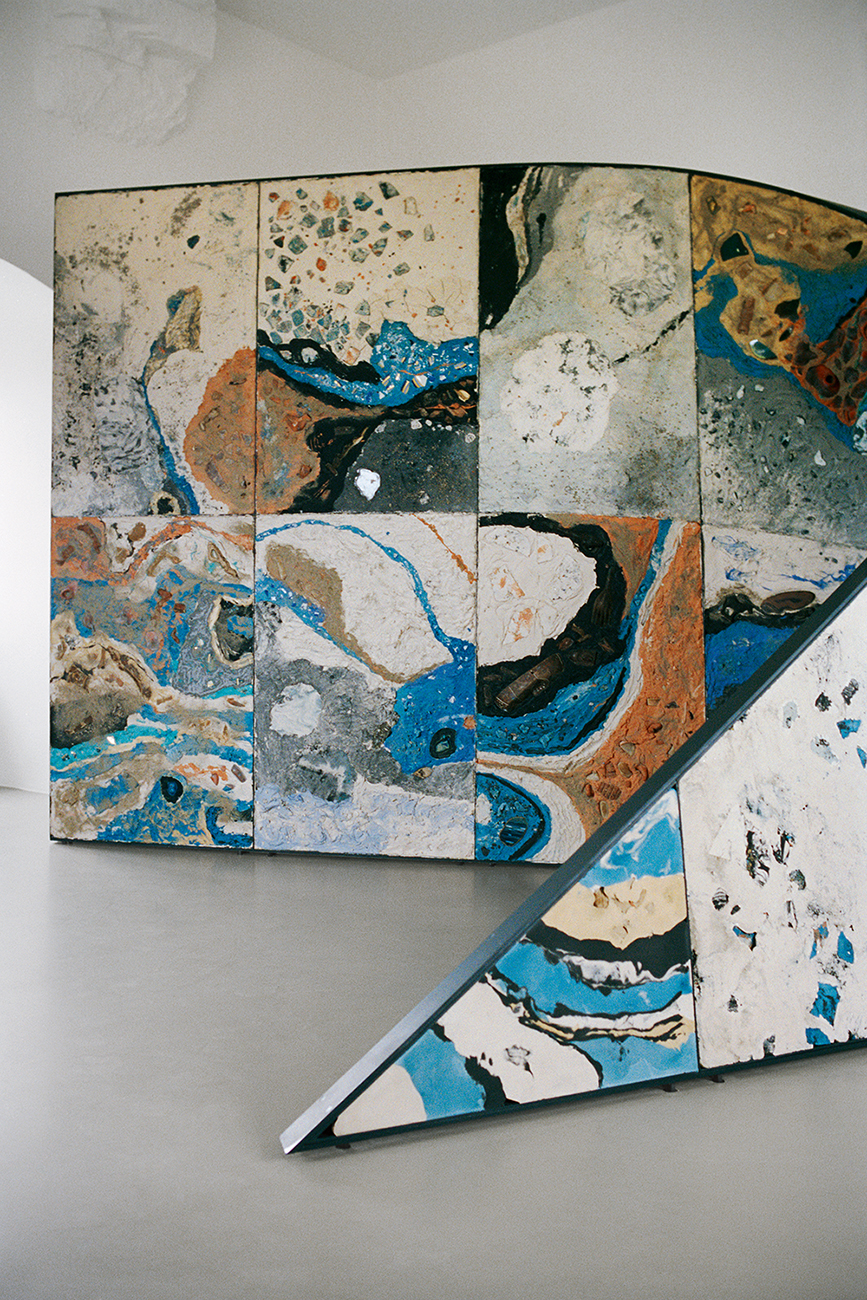
Detail: Uncomfortable Objects, 2012
Plaster, pigments, stones, shells, masks, fabric, glass, wood, clay and diverse objects mounted on a steel frame.
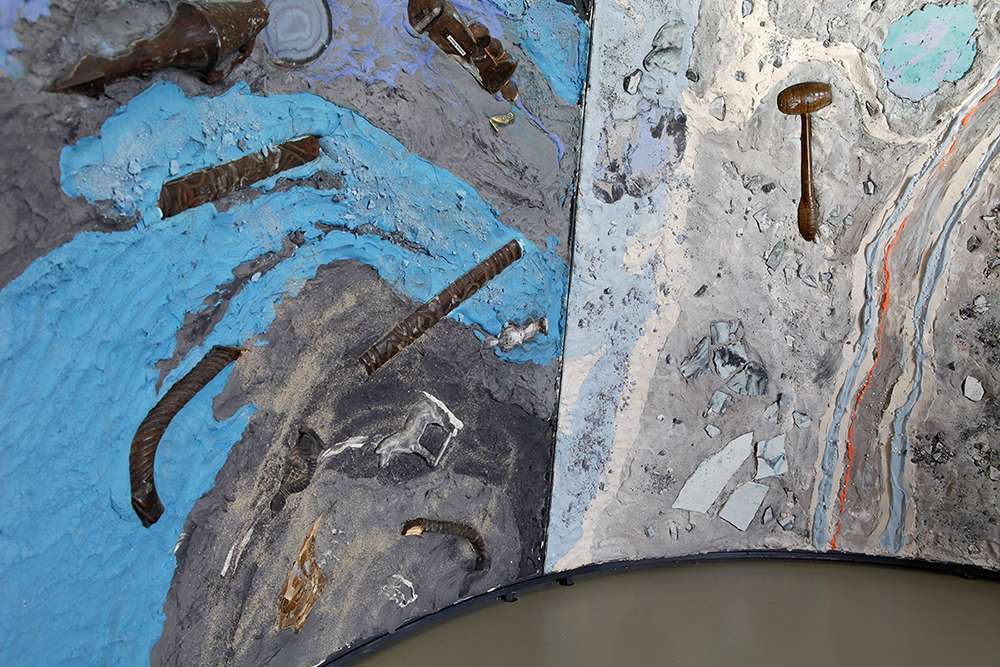
Detail: Uncomfortable Objects, 2012
Plaster, pigments, stones, shells, masks, fabric, glass, wood, clay and diverse objects mounted on a steel frame.

Uncomfortable Objects, 2012,
Plaster, pigments, stones, shells, masks, fabric, glass, wood, clay and diverse objects mounted on a steel frame.
Uncomfortable Objects
Zurich Art Prize, Haus Konstruktiv, Zurich
September 27 - November 18 2012
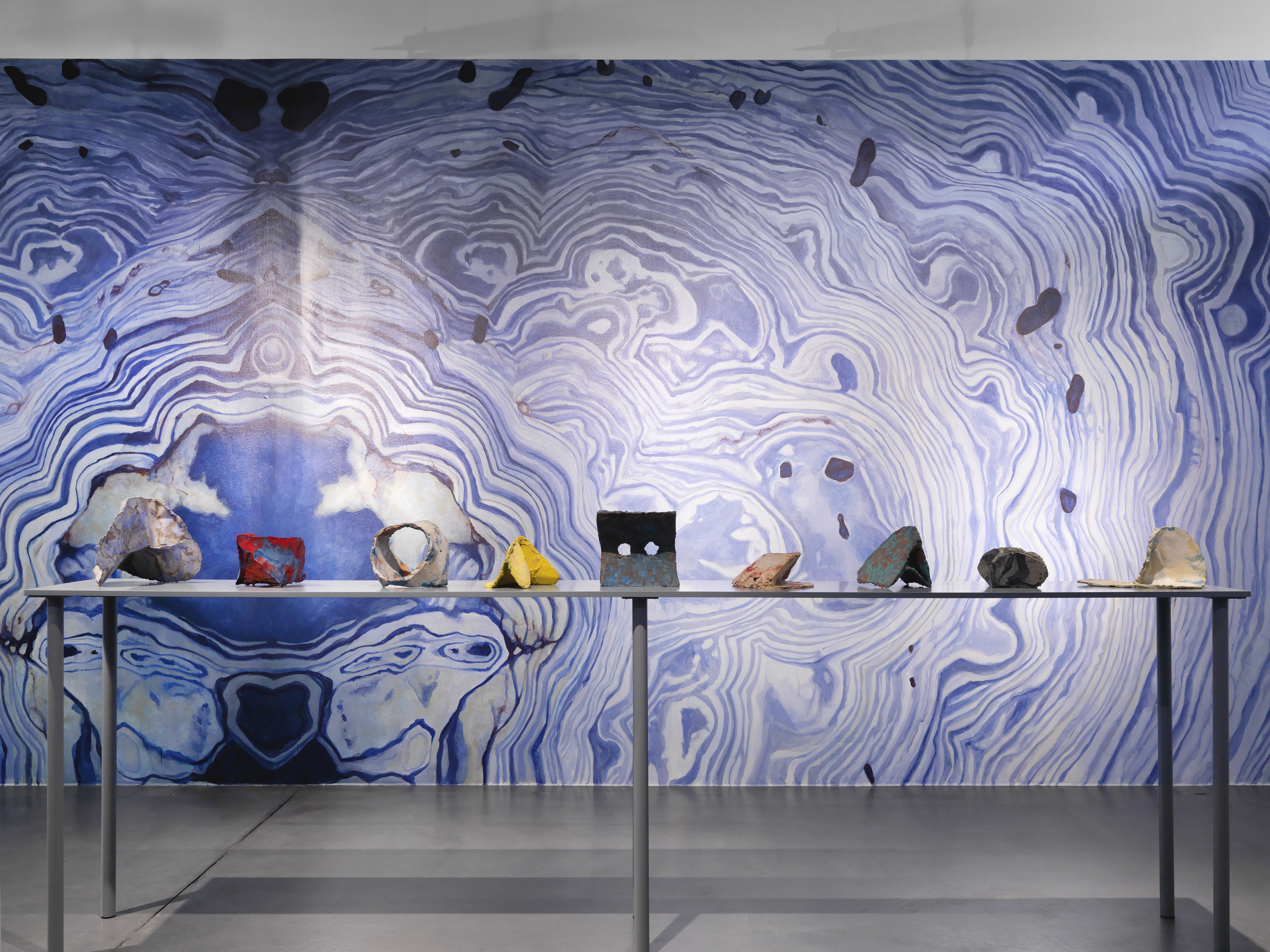
Mathematical distortions and There are no spaces in words as people speak them, 2012
Plaster, pigments, rabbit glue, aluminium / Mural, acrylic paint on wall
Photo: Stefan Altenburger.
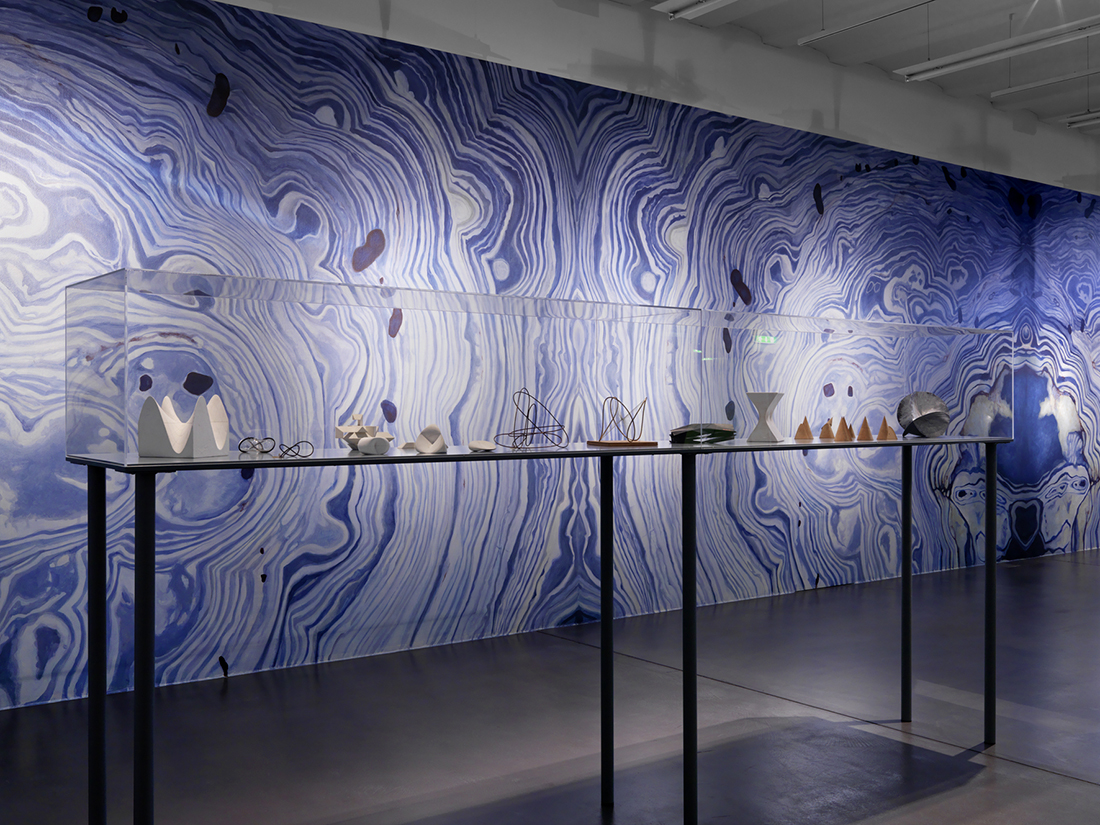
Objects from the Göttingen Collection of Mathematical Models and Instruments and There are no spaces in words as people speak them, 2012
Mural, acrylic paint on wall. Photo: Stefan Altenburger.
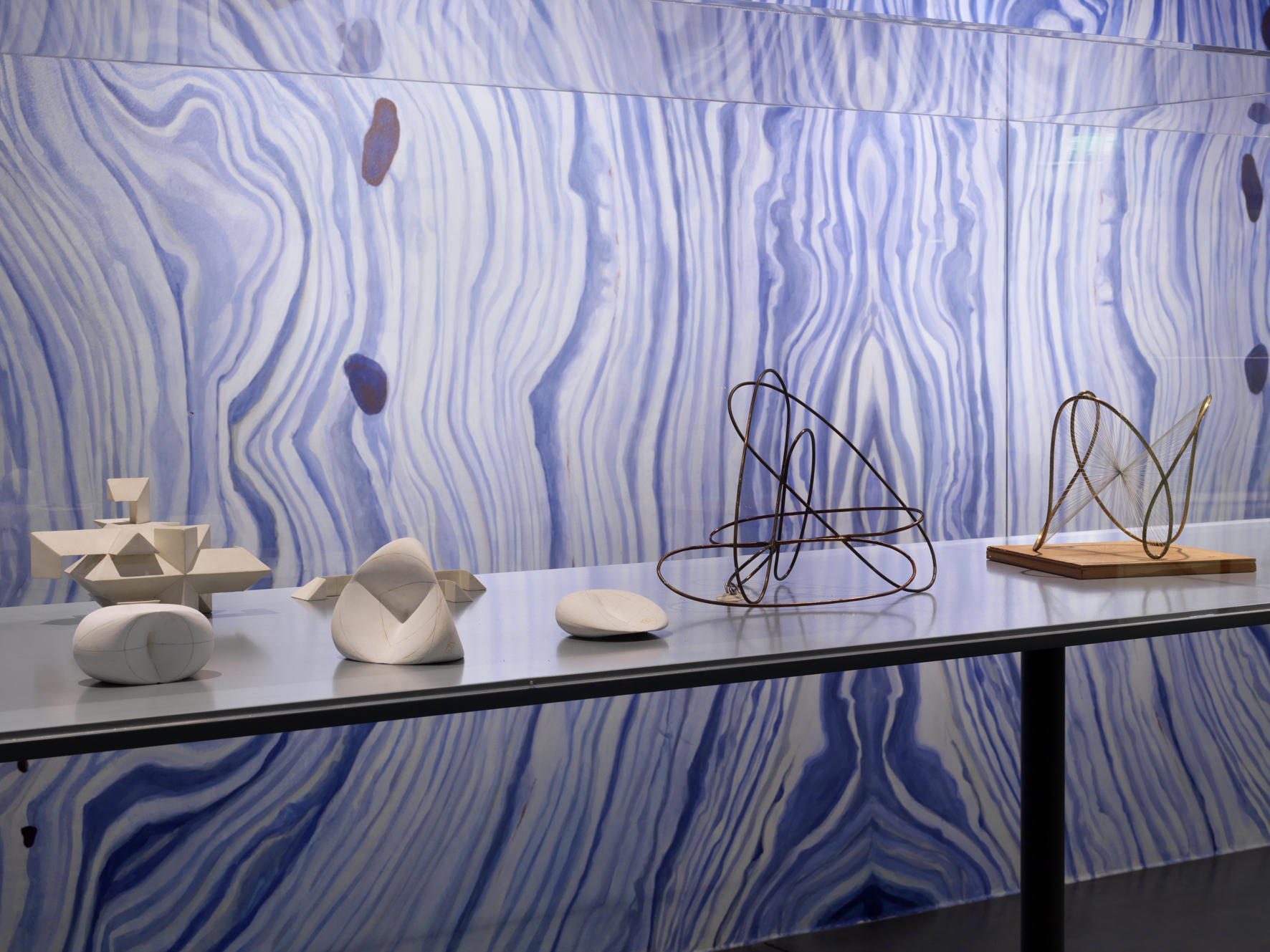
Objects from the Göttingen Collection of Mathematical Models and Instruments
. Photo: Stefan Altenburger.
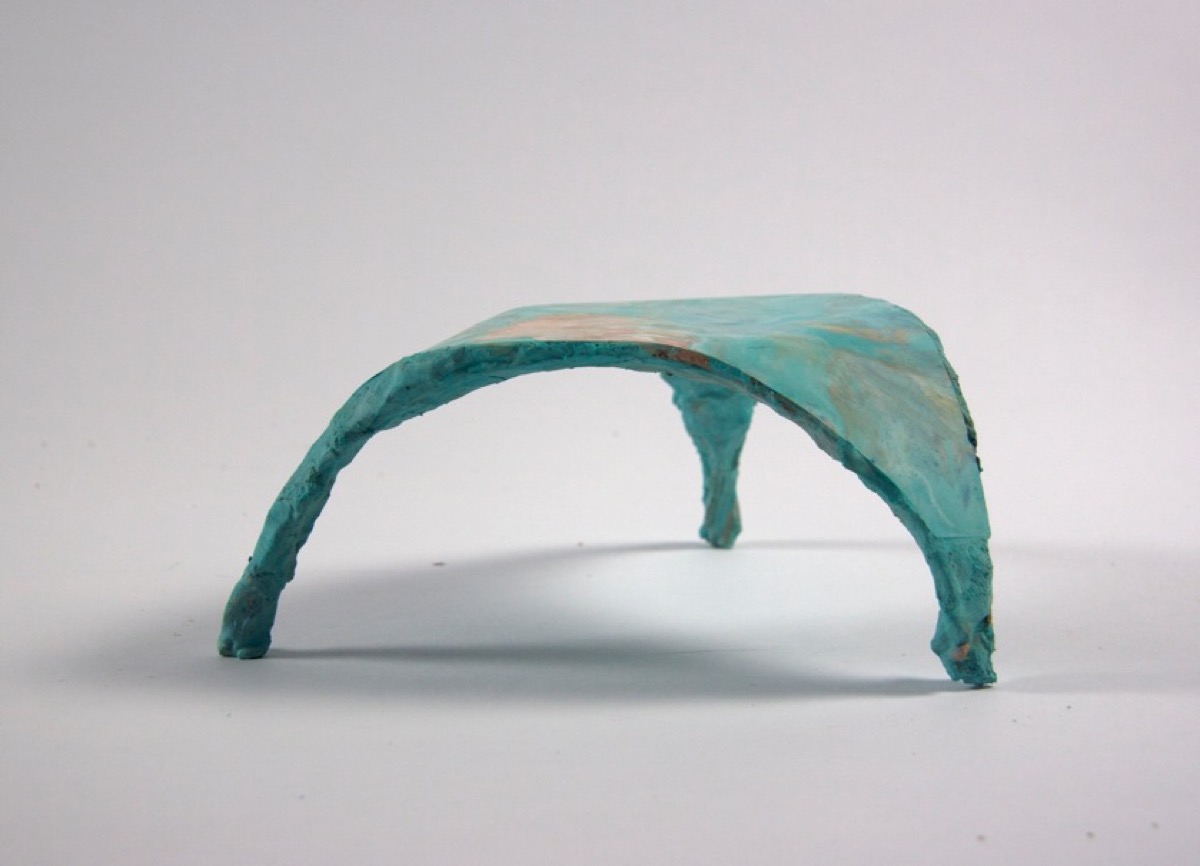
Mathematical distortions No. 15, 2012
Plaster, pigments, rabbit glue, aluminum
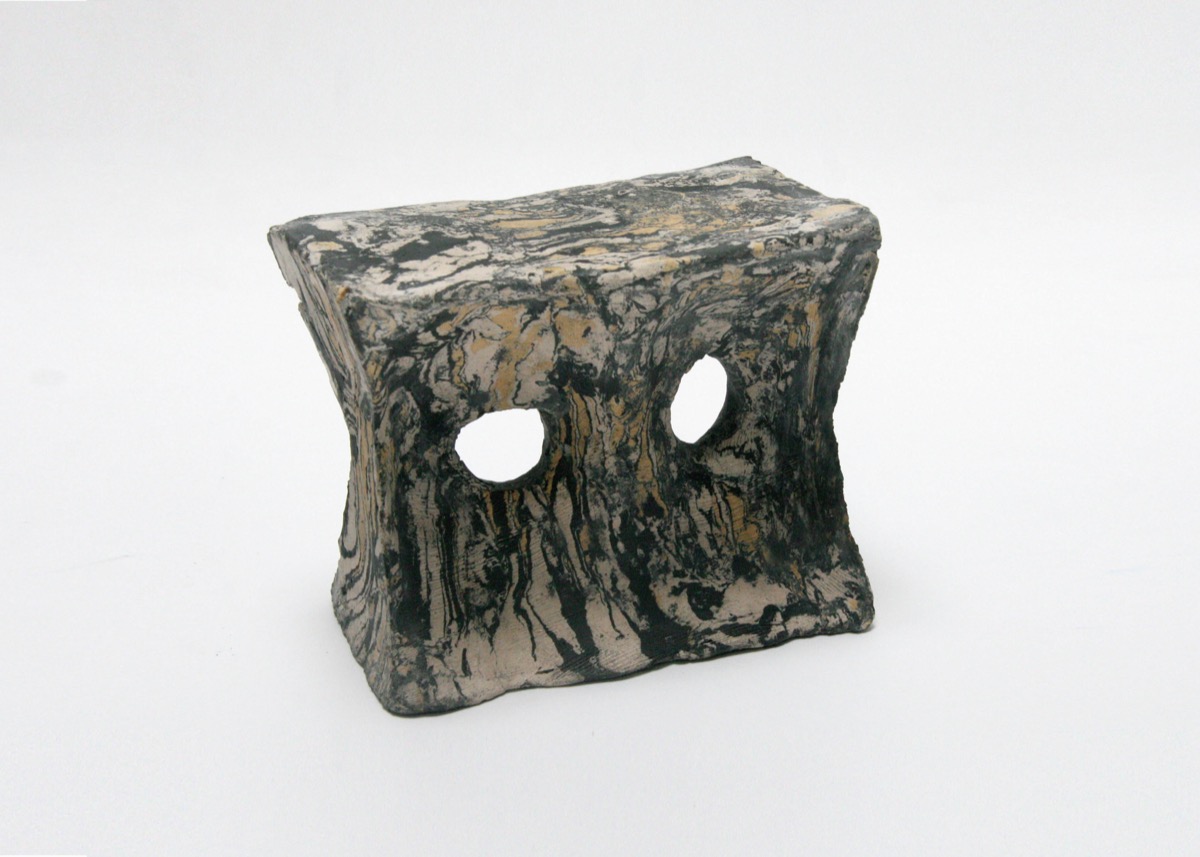
Mathematical distortions (untitled), 2012
Plaster, pigments, rabbit glue, aluminum
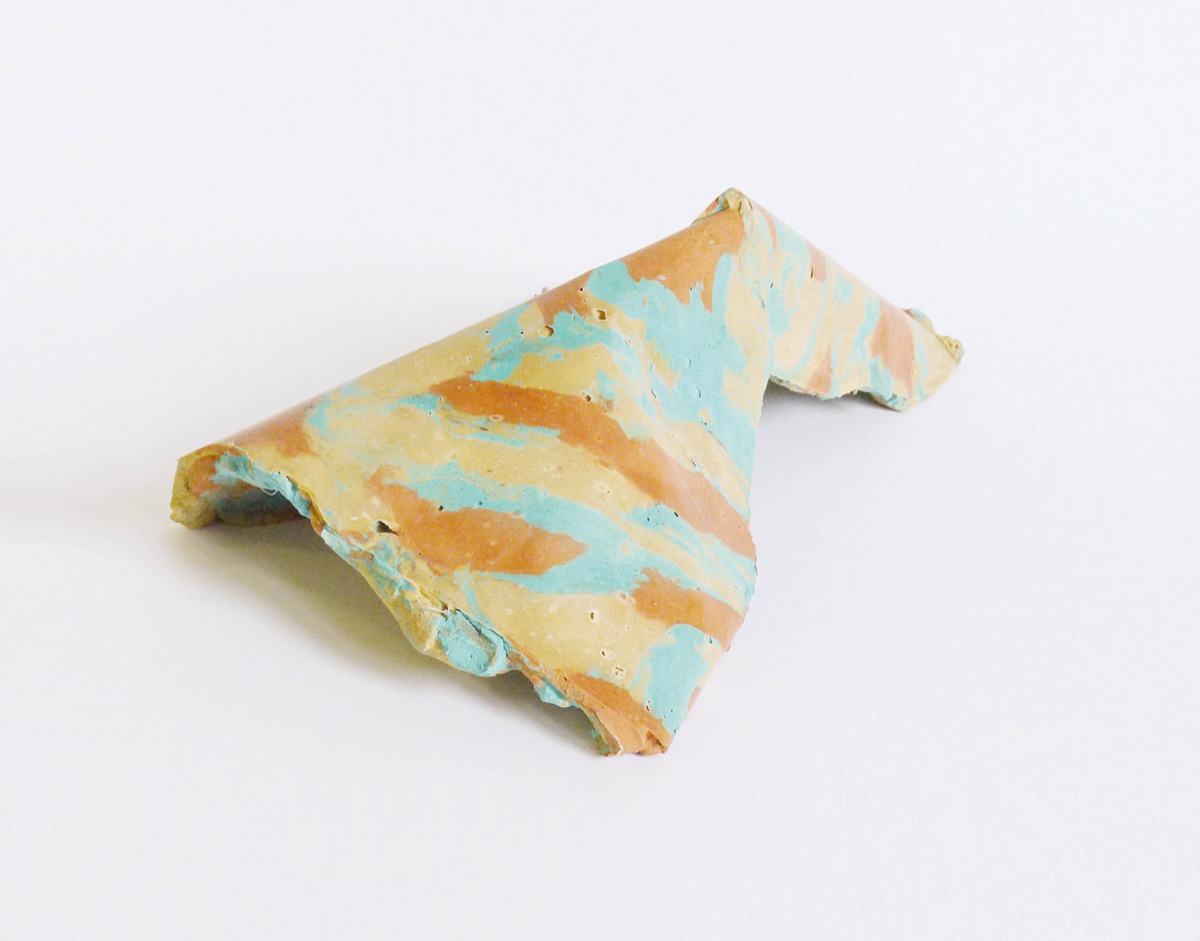
Mathematical distortions (untitled), 2012
Plaster, pigments, rabbit glue, aluminum

Mathematical distortions No. 20, 2012
Plaster, pigments, rabbit glue, aluminum.
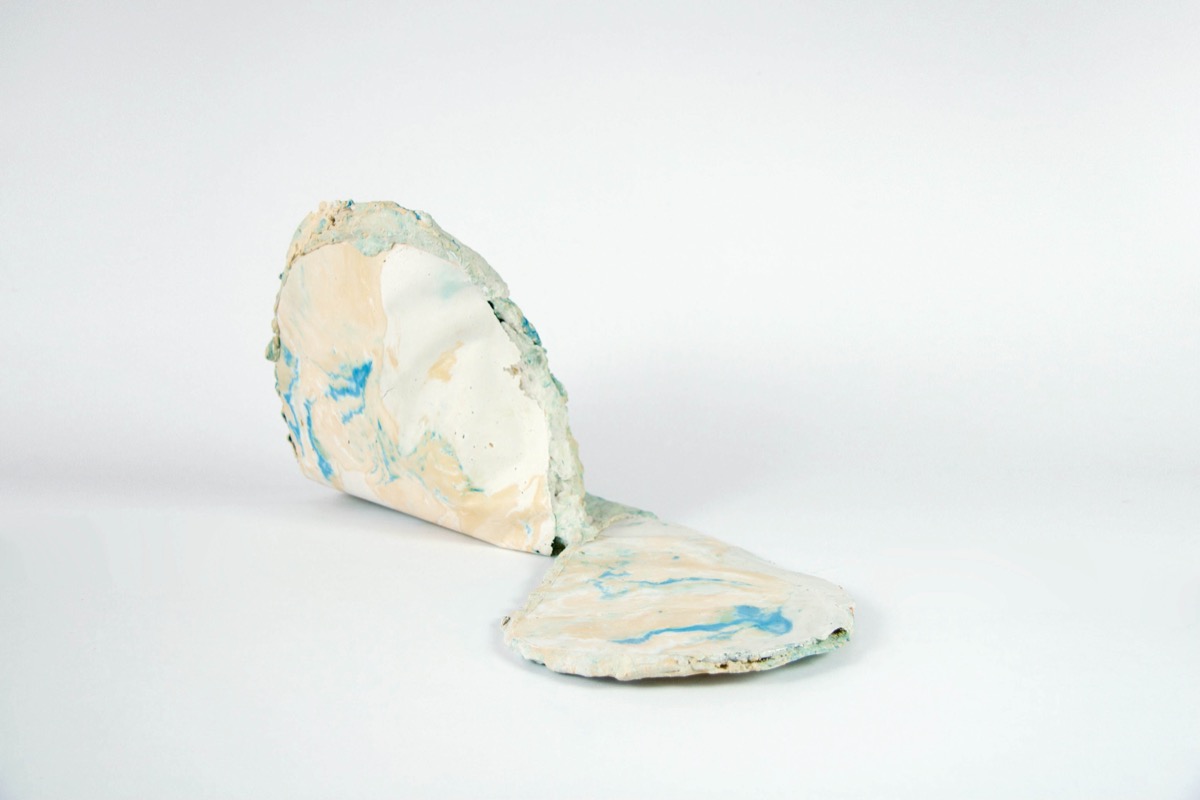
Mathematical distortions No. 11, 2012
Plaster, pigments, rabbit glue, aluminum
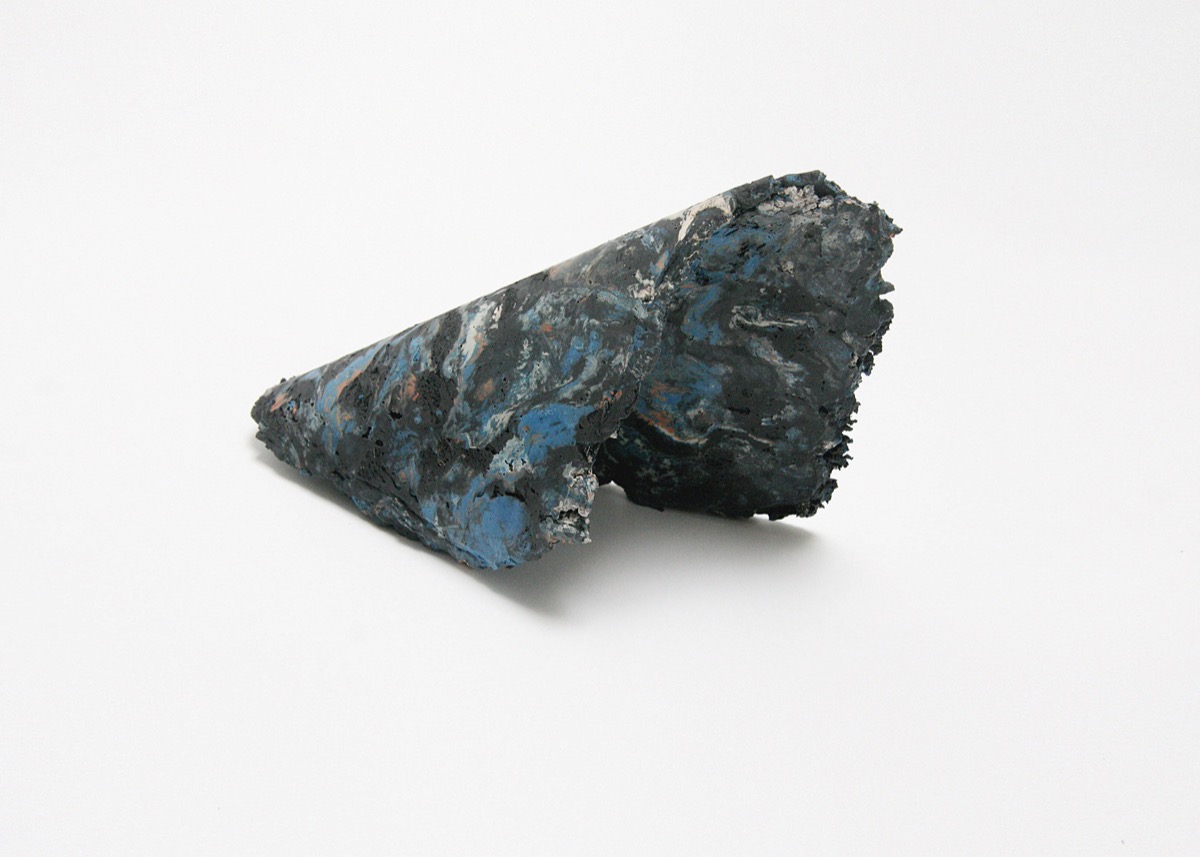
Mathematical distortions No. 19, 2012
Plaster, pigments, rabbit glue, aluminum
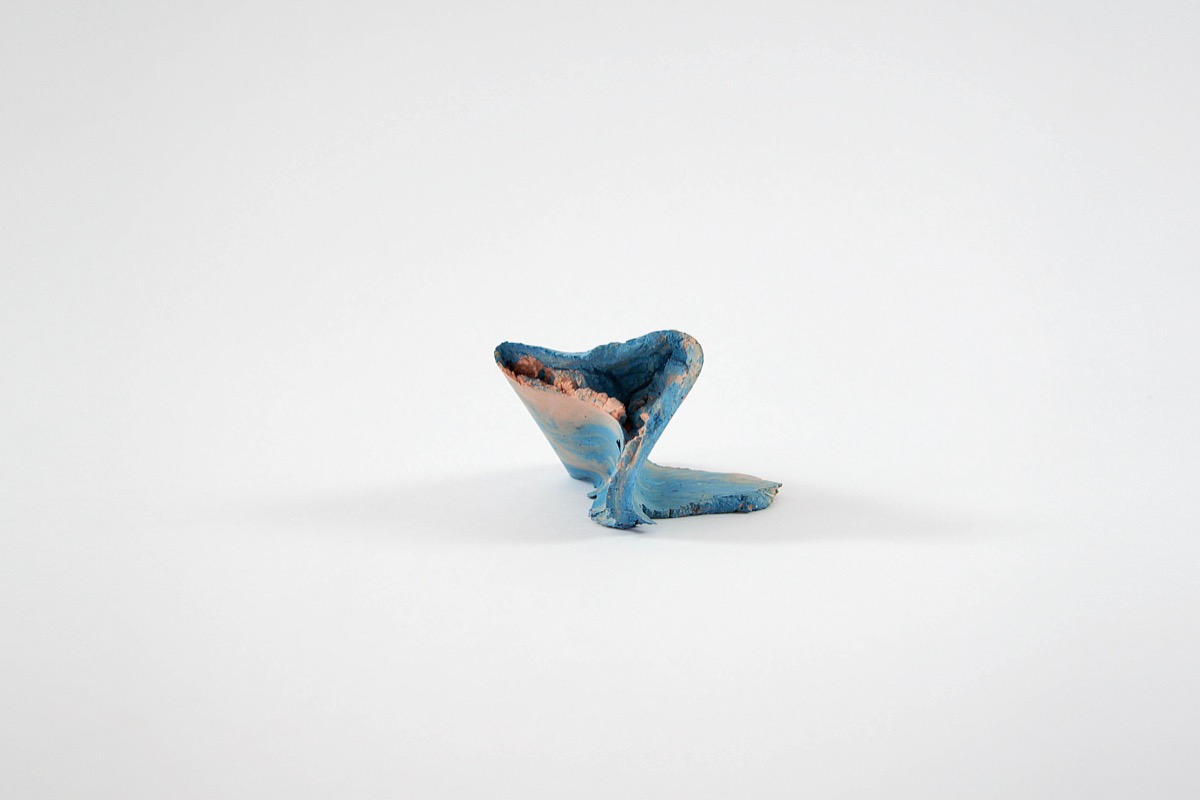
Mathematical distortions (untitled), 2012
Plaster, pigments, rabbit glue, aluminum
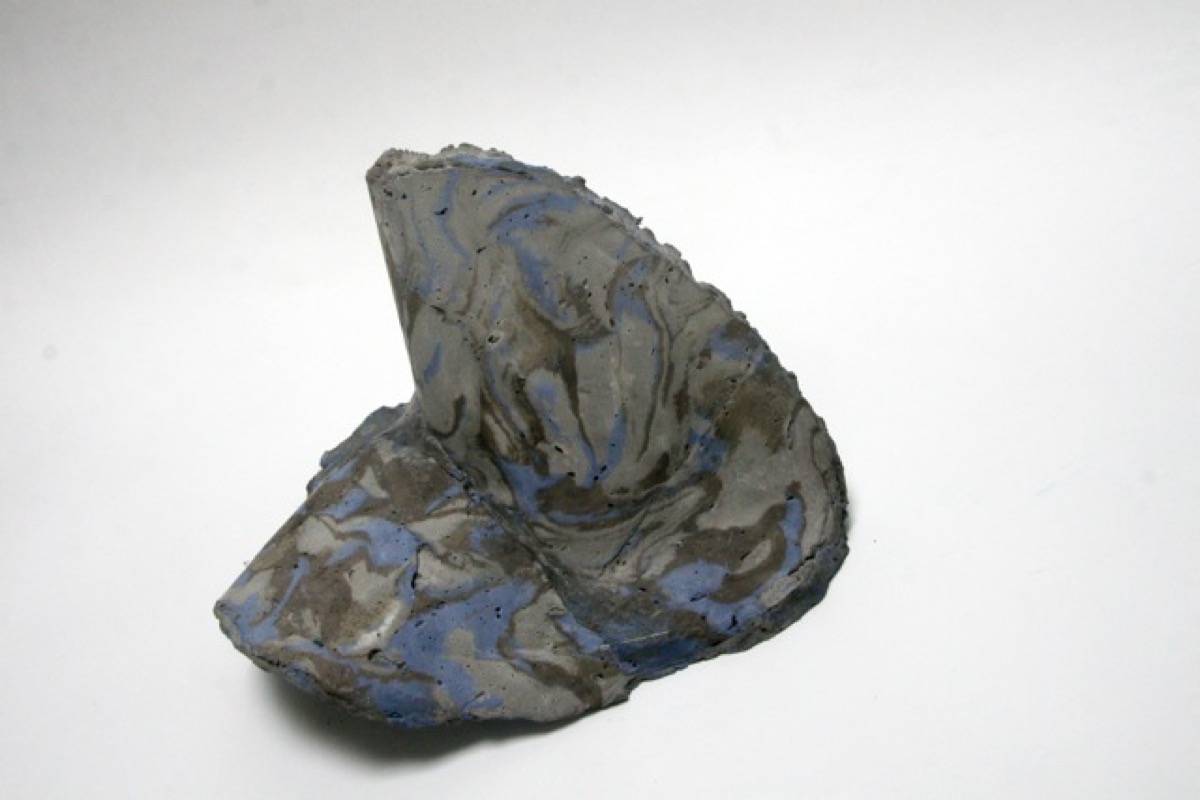
Mathematical distortions No. 21, 2012
Plaster, pigments, rabbit glue, aluminum
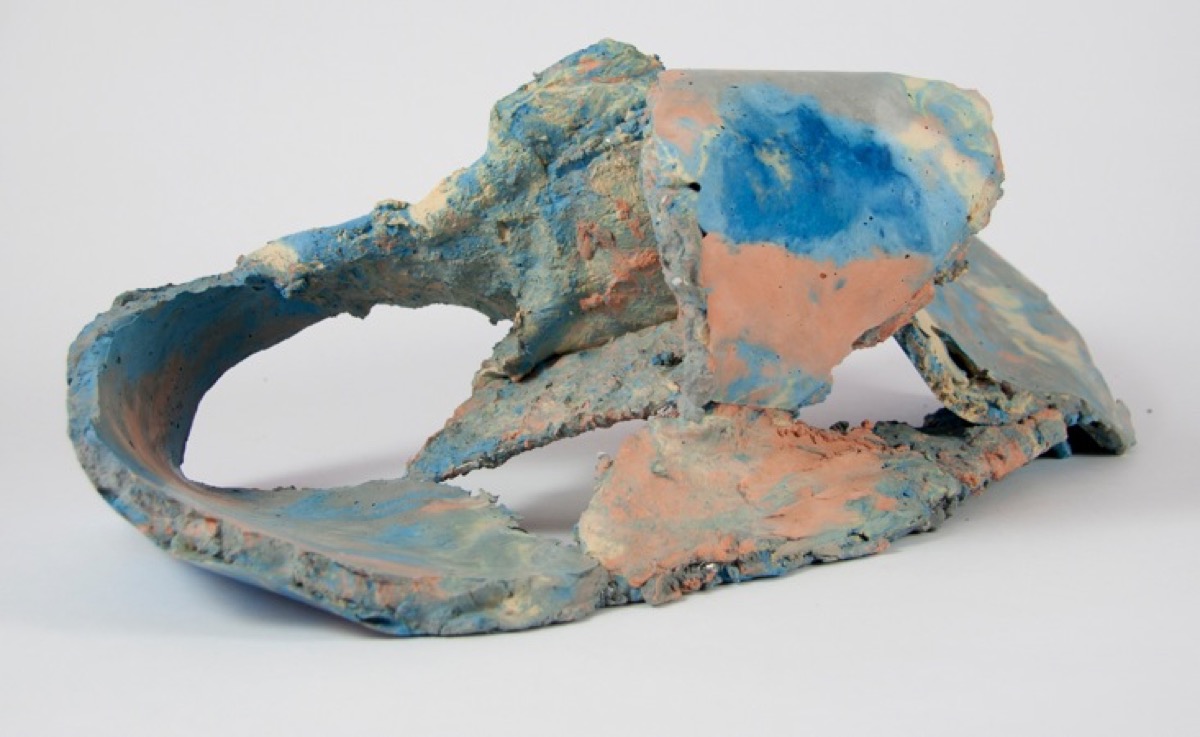
Mathematical distortions No. 13, 2012
Plaster, pigments, rabbit glue, aluminum
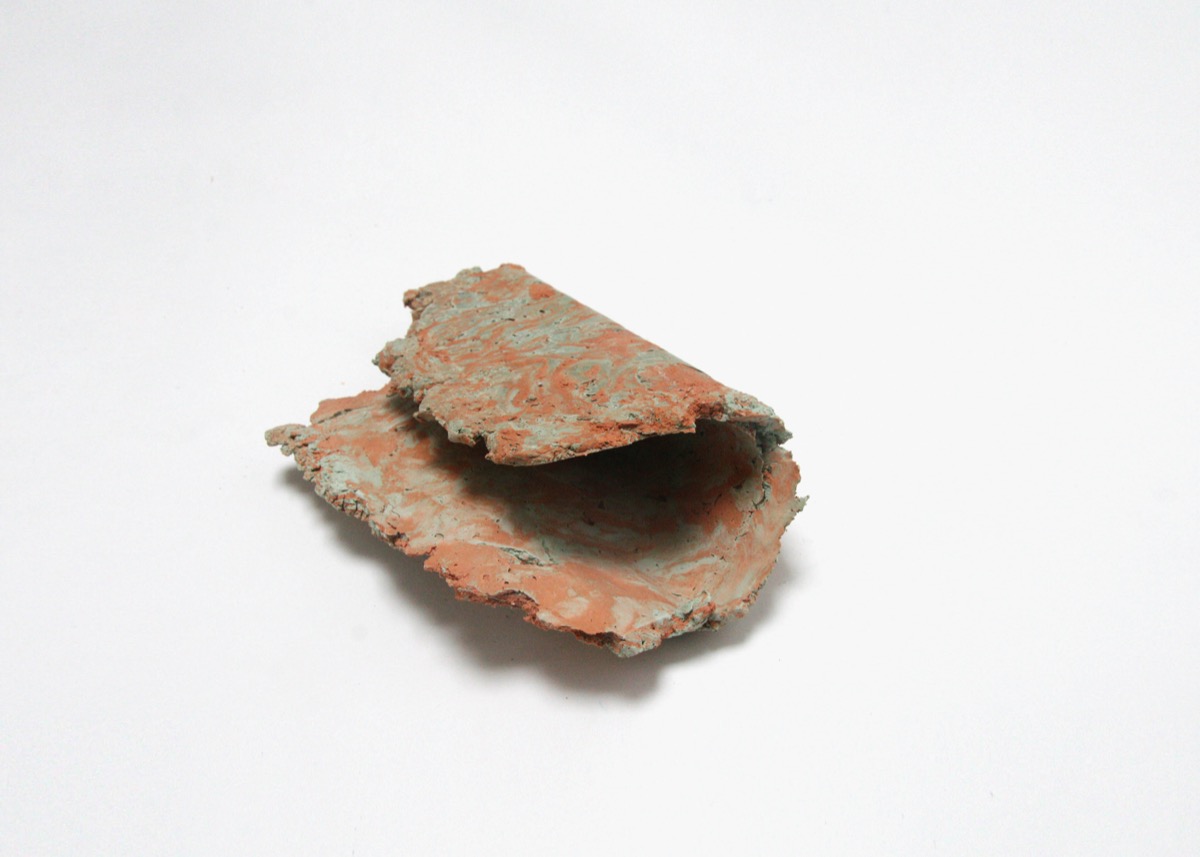
Mathematical distortions (untitled), 2012
Plaster, pigments, rabbit glue, aluminum
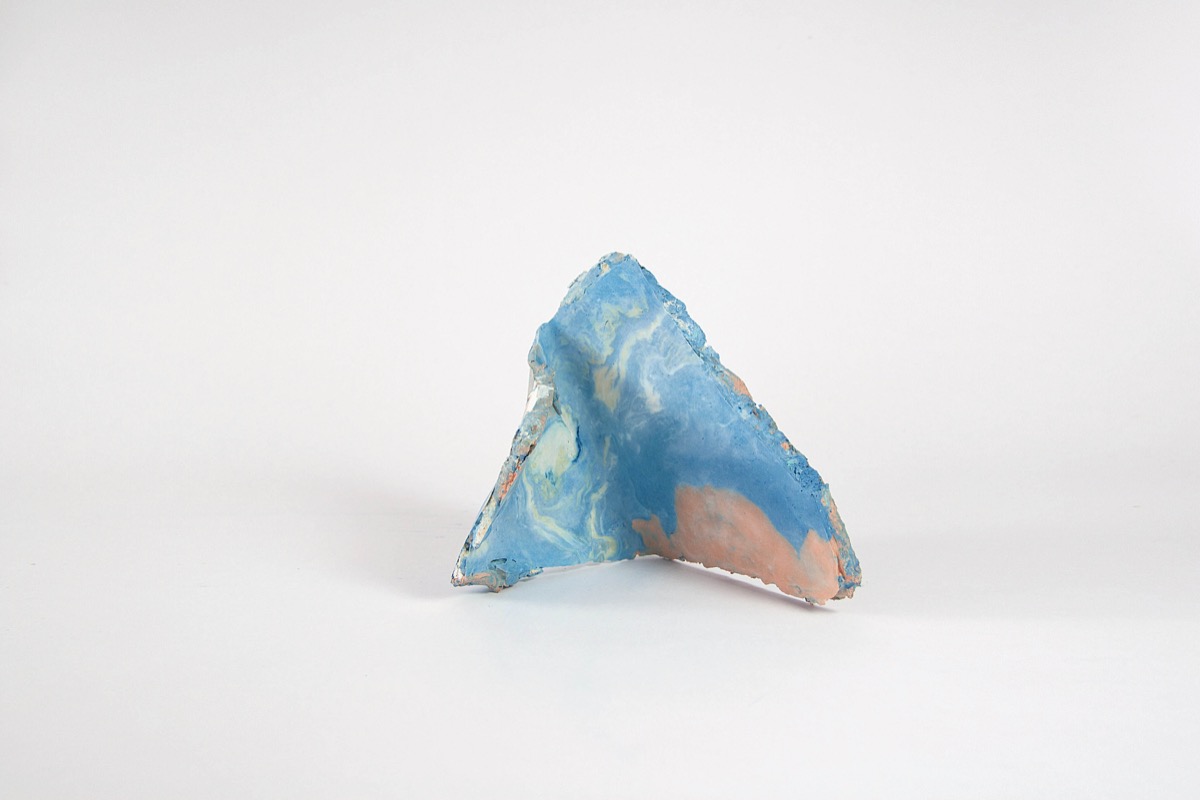
Mathematical distortions (untitled), 2012
Plaster, pigments, rabbit glue, aluminum
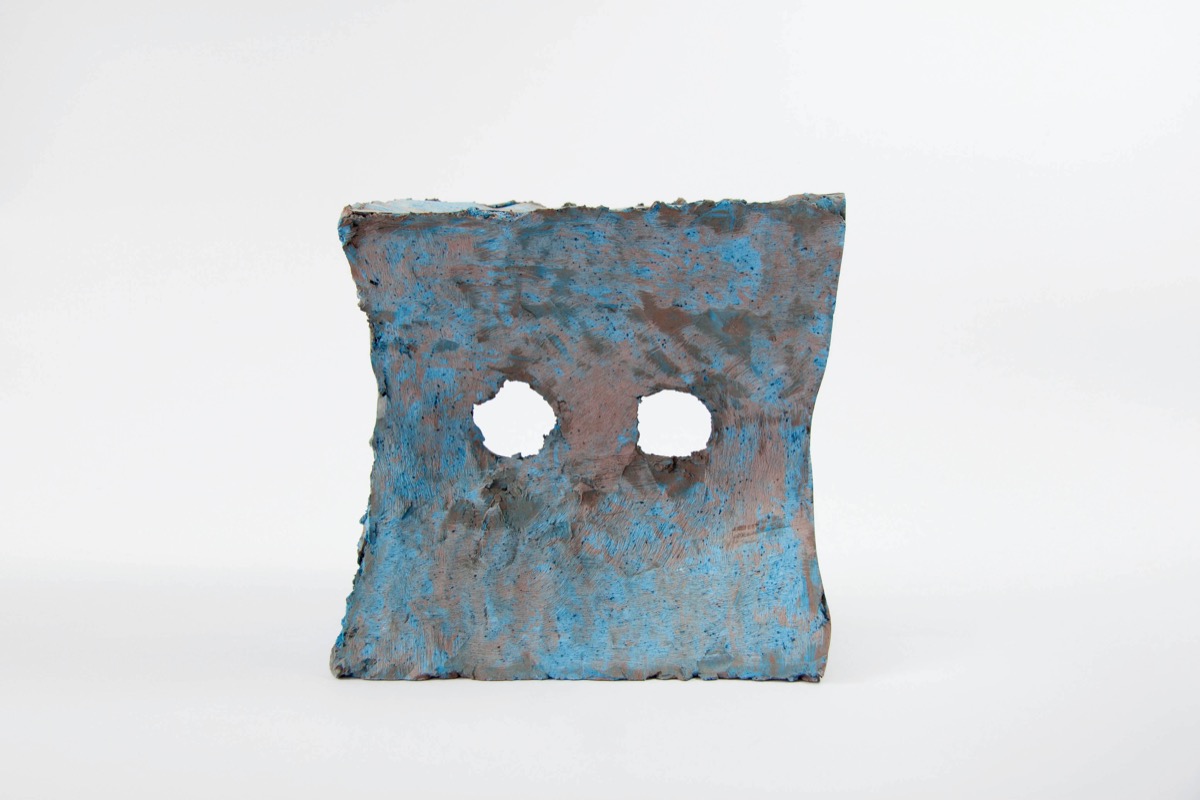
Mathematical distortions No. 8, 2012
Plaster, pigments, rabbit glue, aluminum
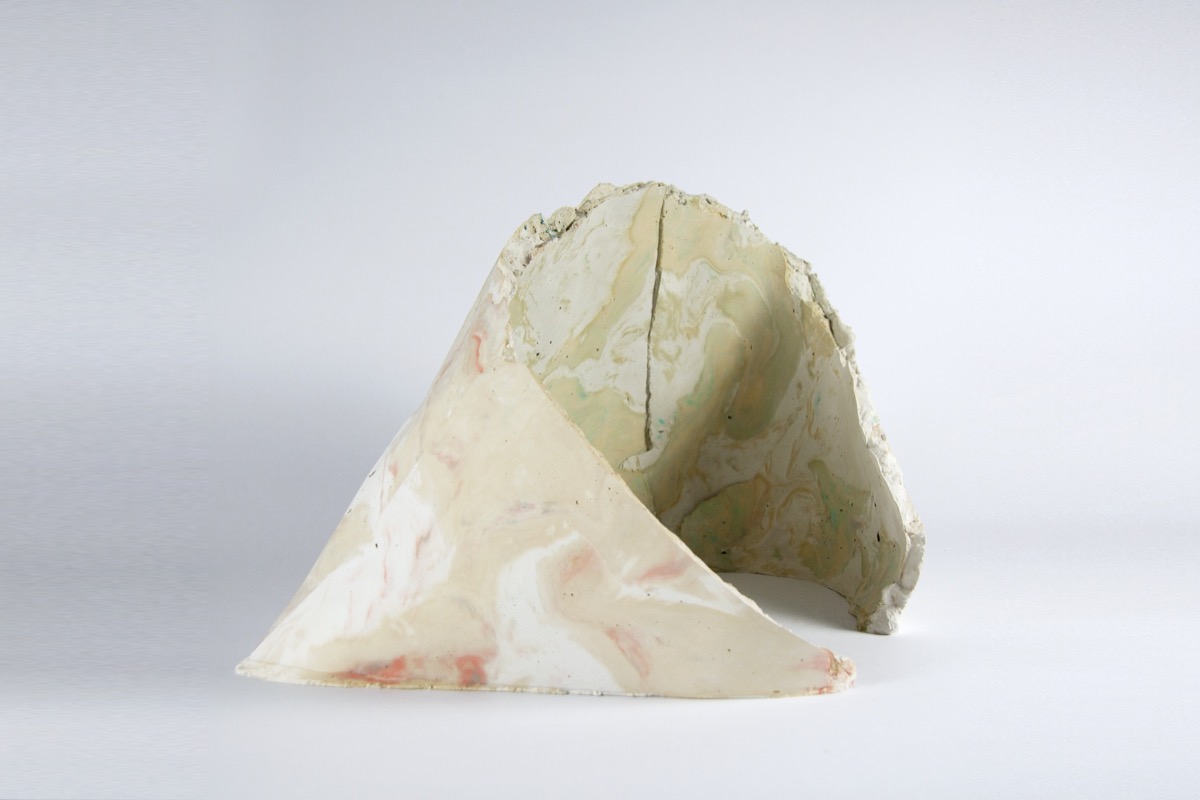
Mathematical distortions No. 1, 2012
Plaster, pigments, rabbit glue, aluminum
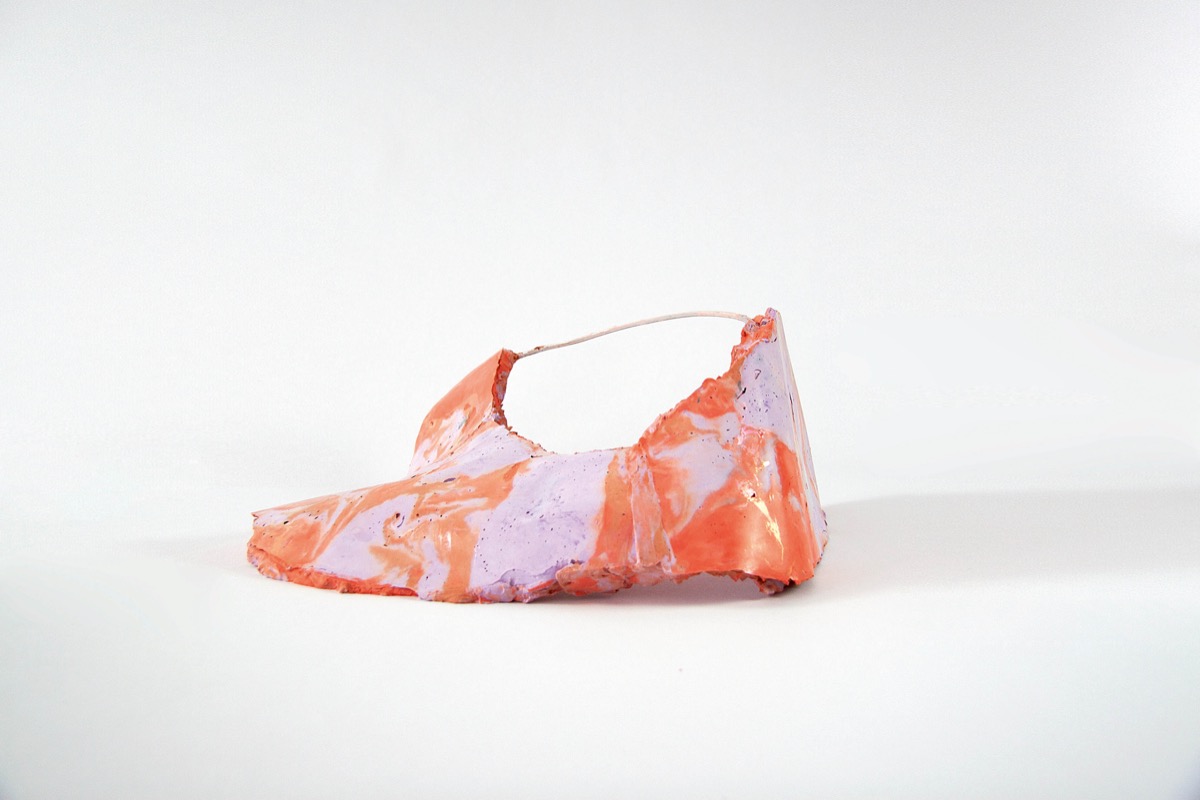
Mathematical distortions No. 4, 2012
Plaster, pigments, rabbit glue, aluminum
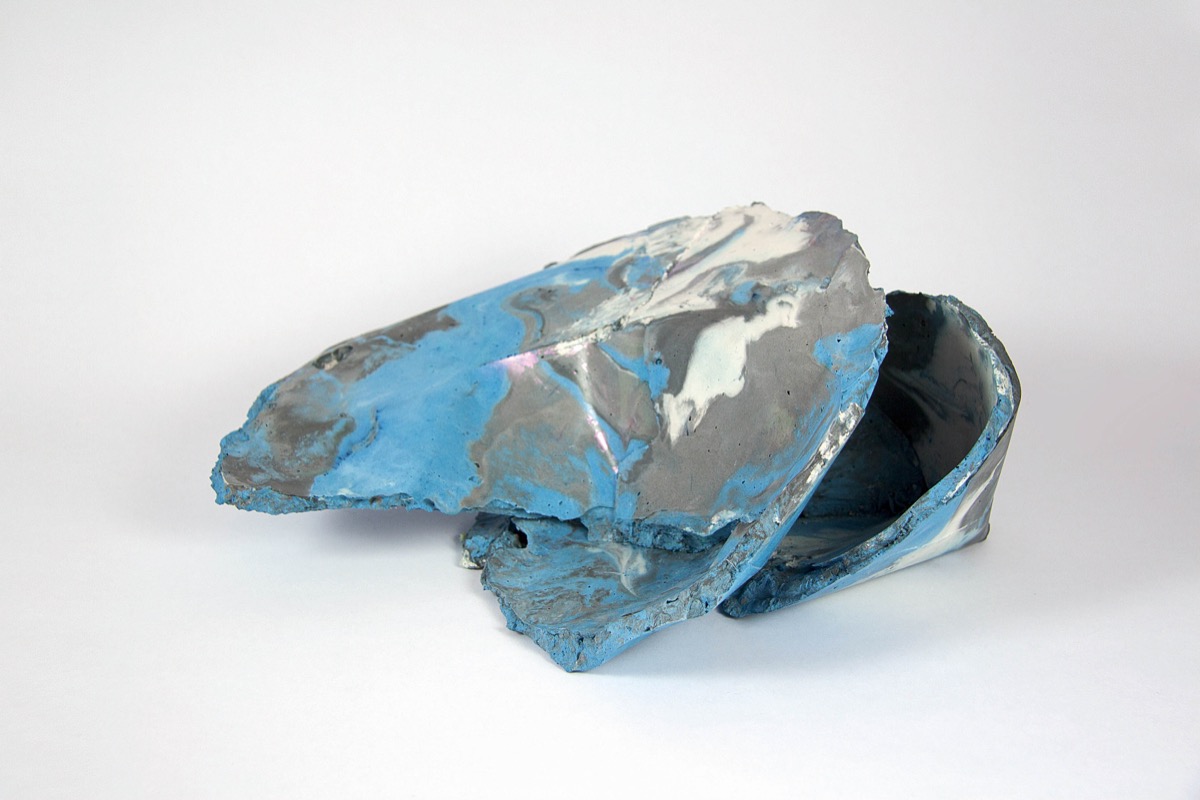
Mathematical distortions No. 2, 2012
Plaster, pigments, rabbit glue, aluminum
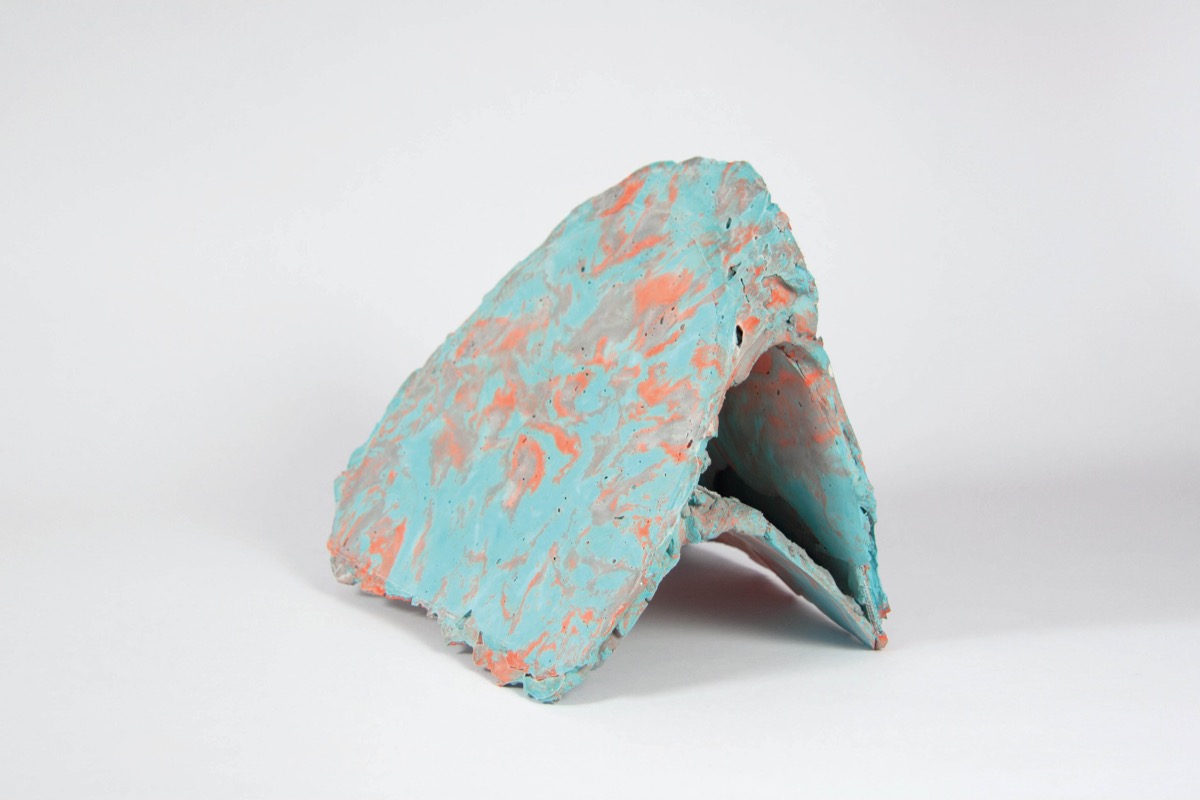
Mathematical distortions No. 10, 2012
Plaster, pigments, rabbit glue, aluminum
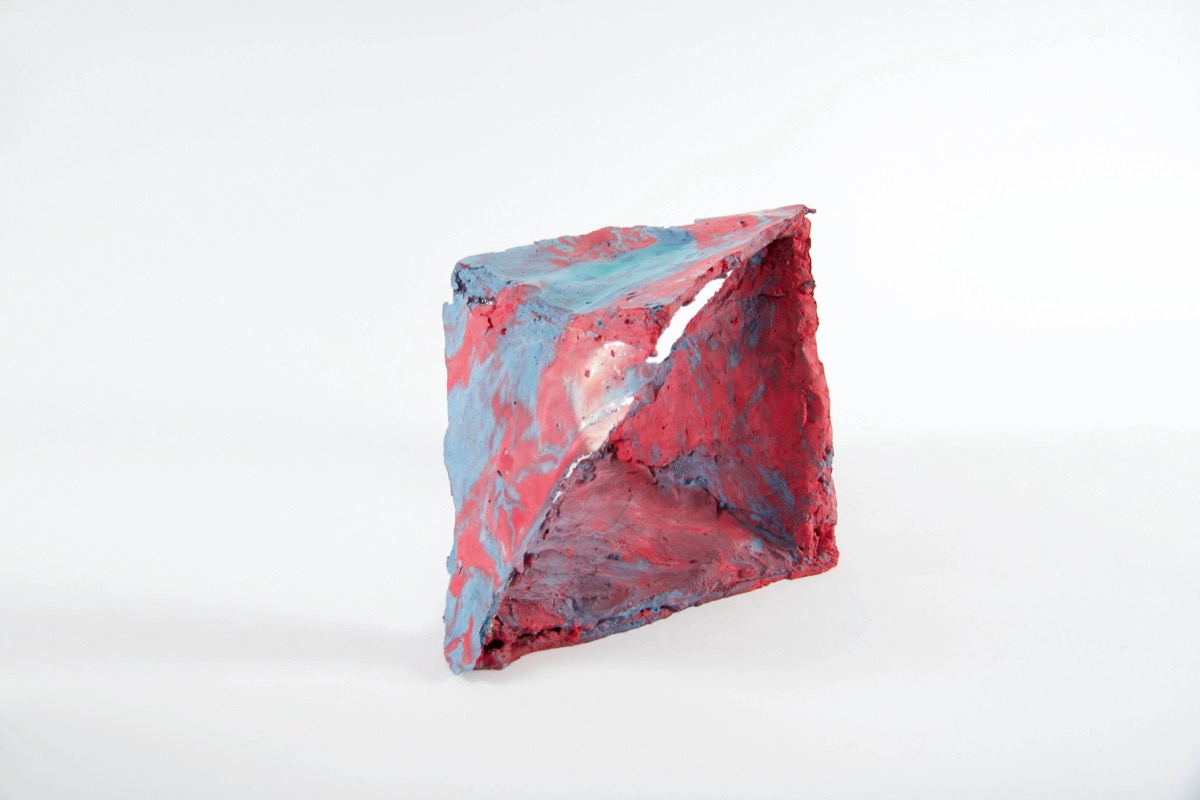
Mathematical distortions No. 6, 2012
Plaster, pigments, rabbit glue, aluminum
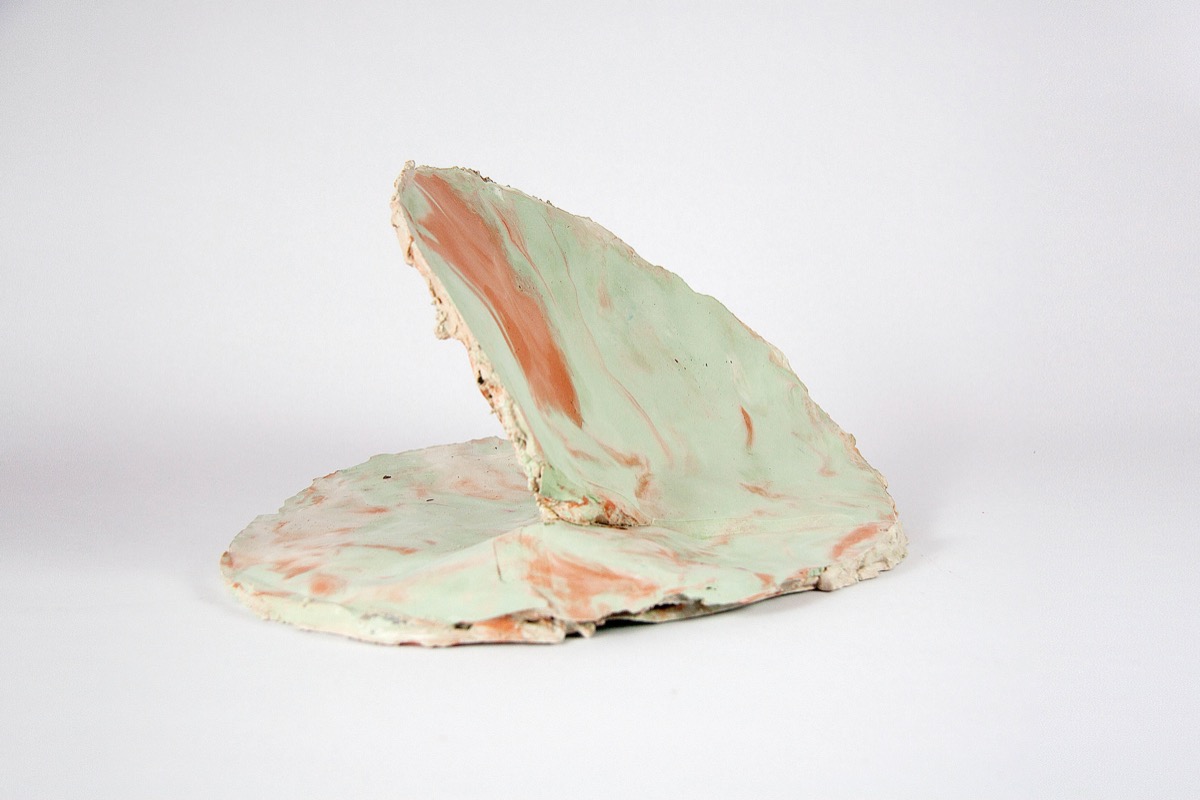
Mathematical distortions (untitled), 2012
Plaster, pigments, rabbit glue, aluminum
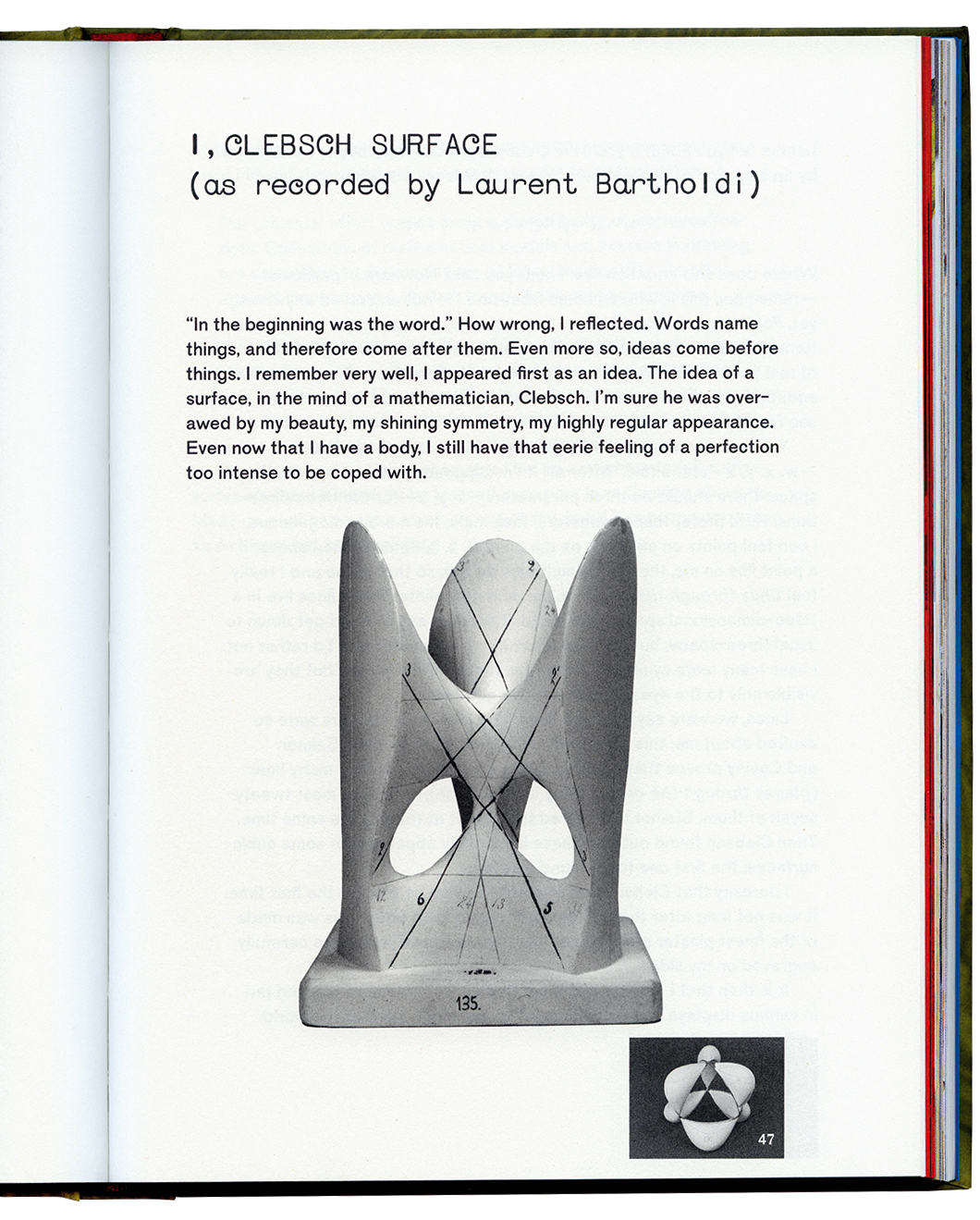
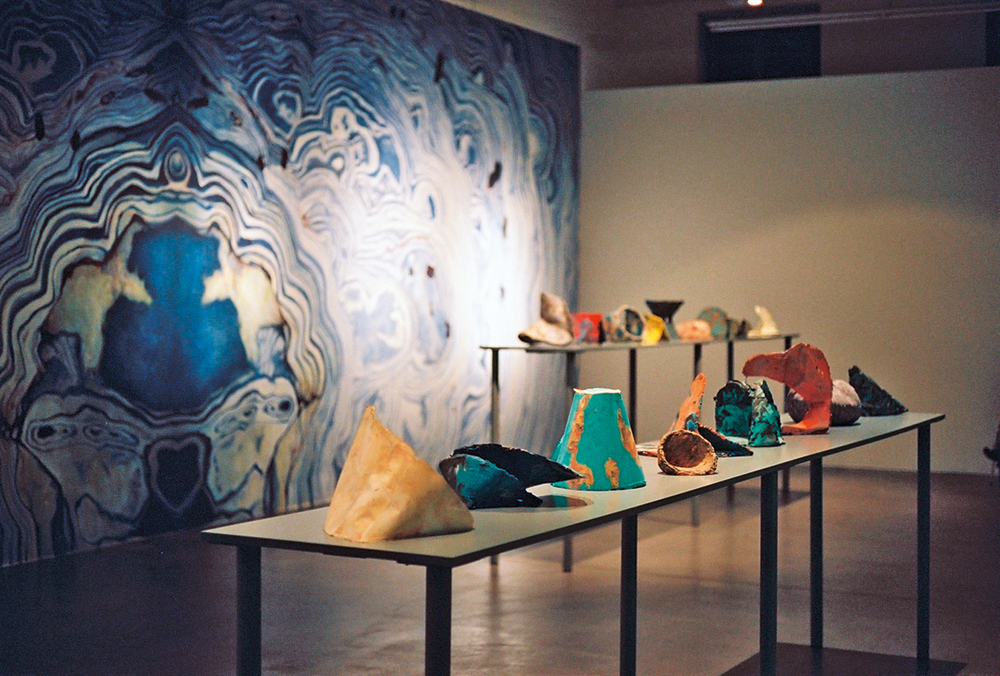
Mathematical distortions and There are no spaces in words as people speak them, 2012
Plaster, pigments, rabbit glue, aluminium / Mural, acrylic paint on wall
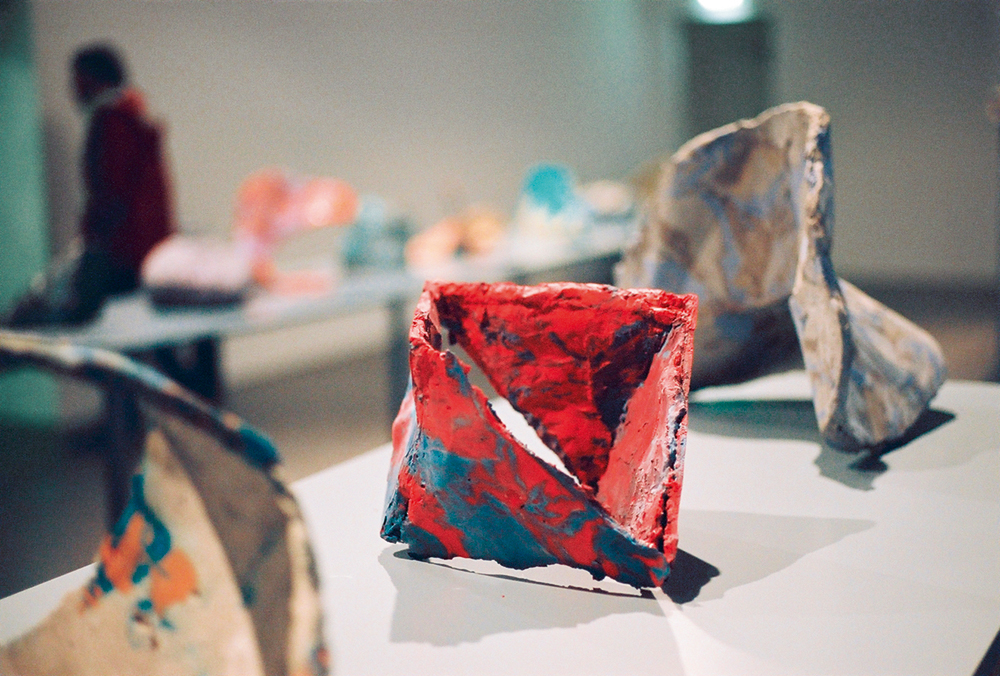
Detail: Mathematical distortions, 2012
Plaster, pigments, rabbit glue, aluminium
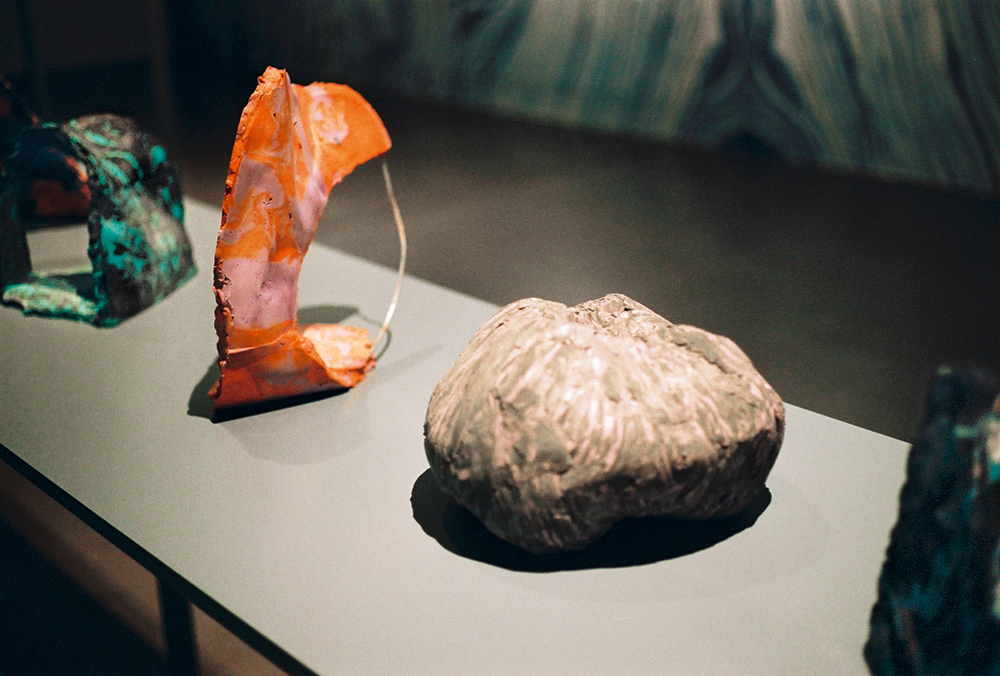
Detail: Mathematical distortions, 2012
Plaster, pigments, rabbit glue, aluminium
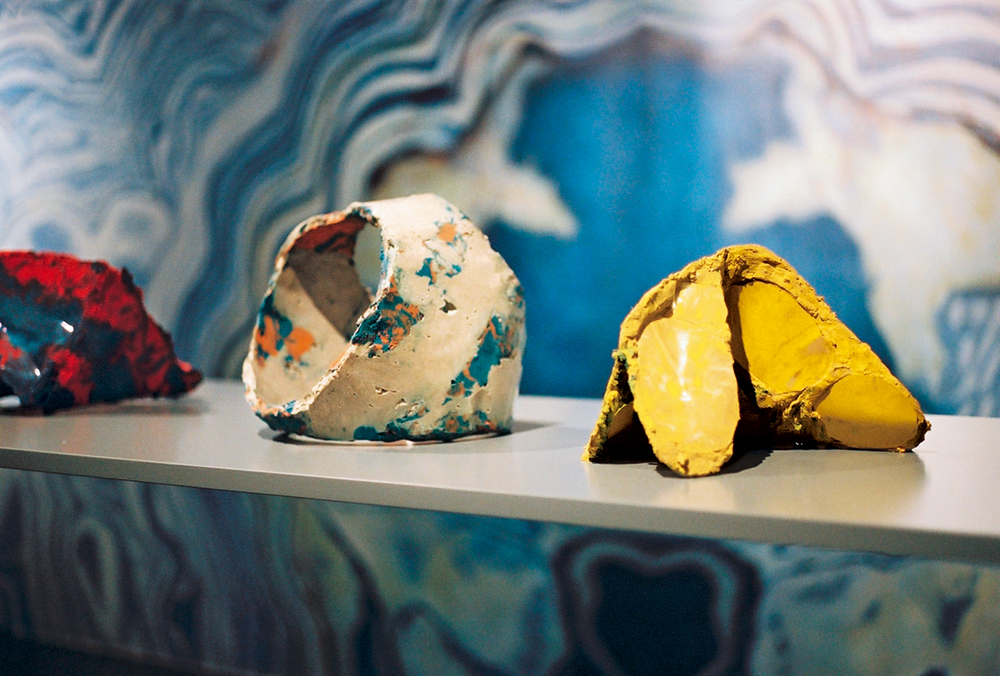
Detail: Mathematical distortions, 2012
Plaster, pigments, rabbit glue, aluminium
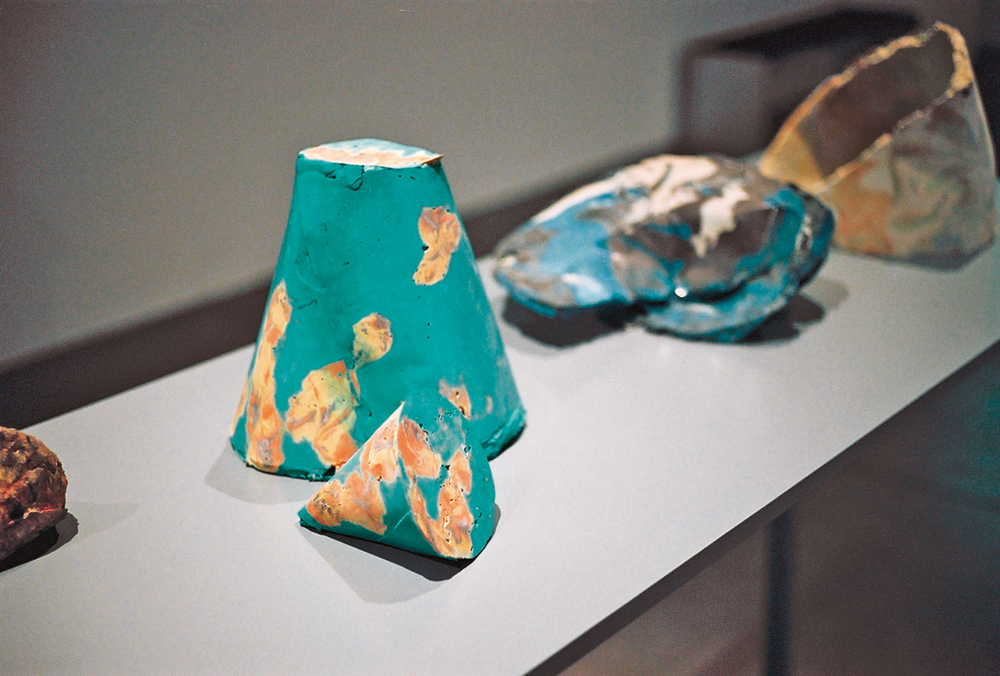
Detail: Mathematical distortions, 2012
Plaster, pigments, rabbit glue, aluminium
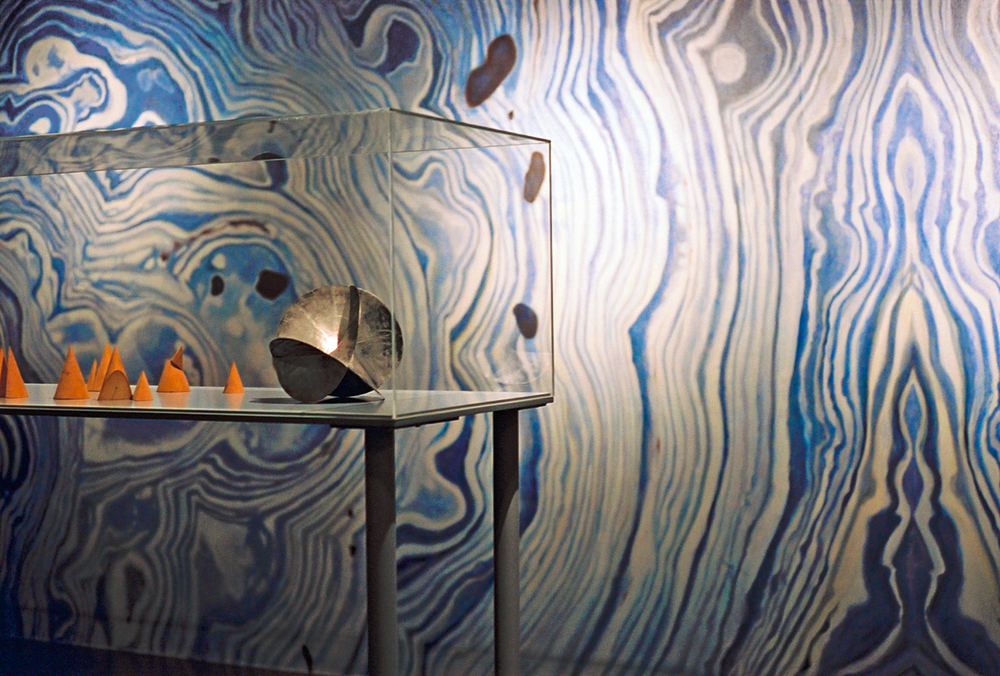
Detail: Mathematical distortions, 2012
Plaster, pigments, rabbit glue, aluminium / Mural, acrylic paint on wall
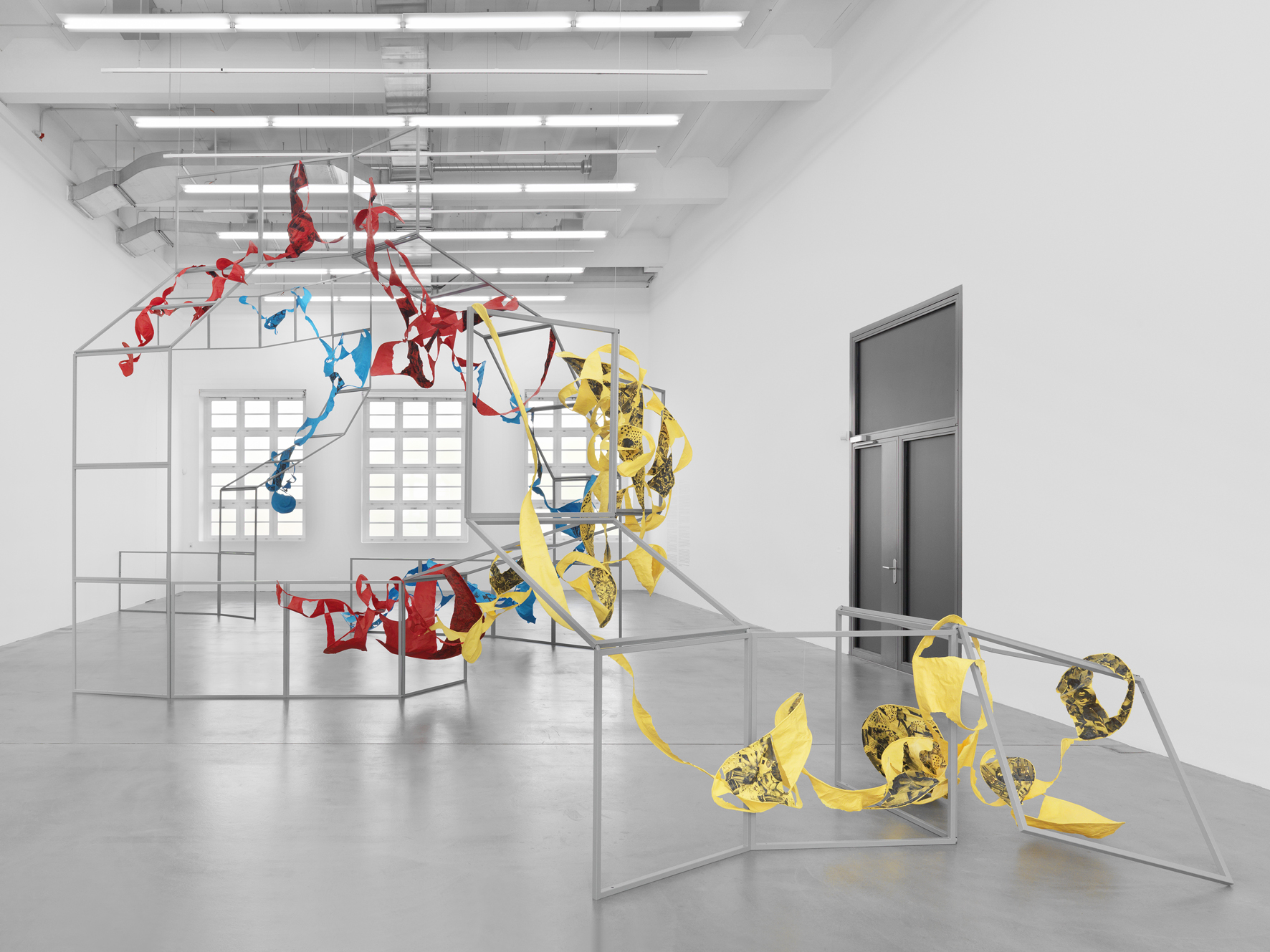
Uncomfortable Objects, 2012
Metal Structure, papier-mâché, laser prints and aluminum wire
.Photo: Stefan Altenburger
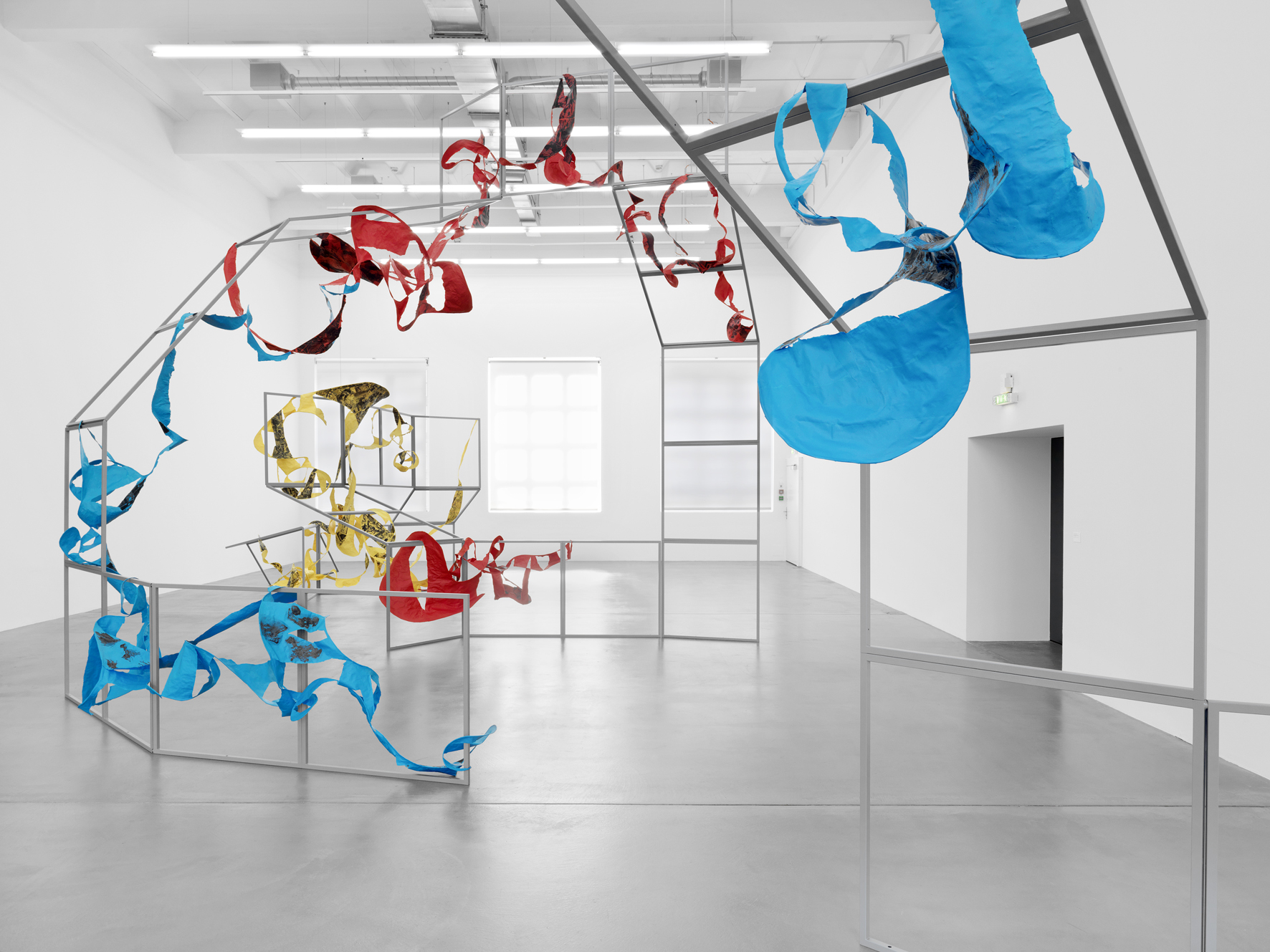
Uncomfortable Objects, 2012
Metal Structure, papier-mâché, laser prints and aluminum wire
. Photo: Stefan Altenburger
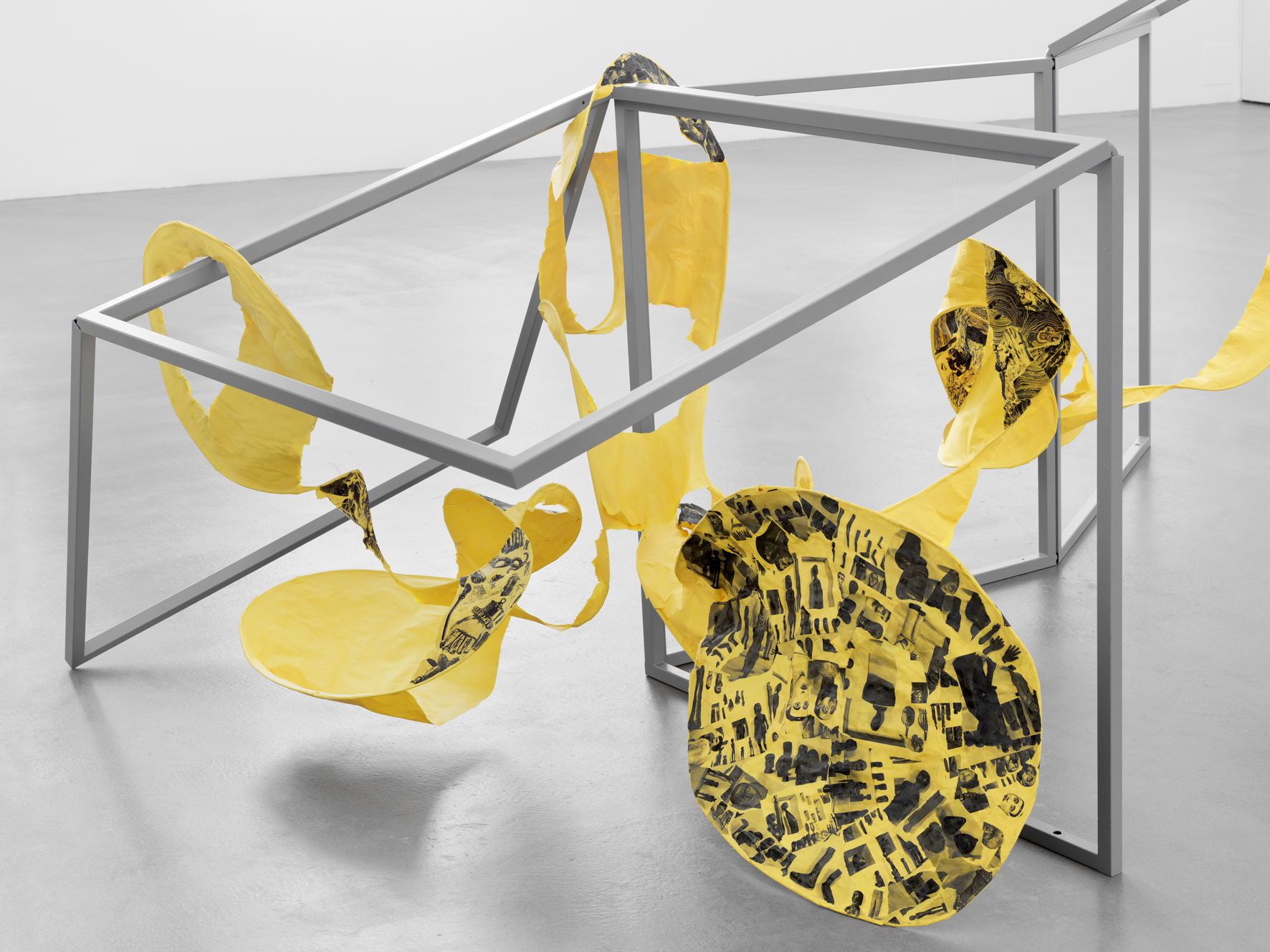
Uncomfortable Objects, 2012
Metal Structure, papier-mâché, laser prints and aluminum wire
. Photo: Stefan Altenburger
Stringing Beads
Dortmunder Kunstverein
21 September 2025 – 25 January 2026
Curated by Rebekka Seubert
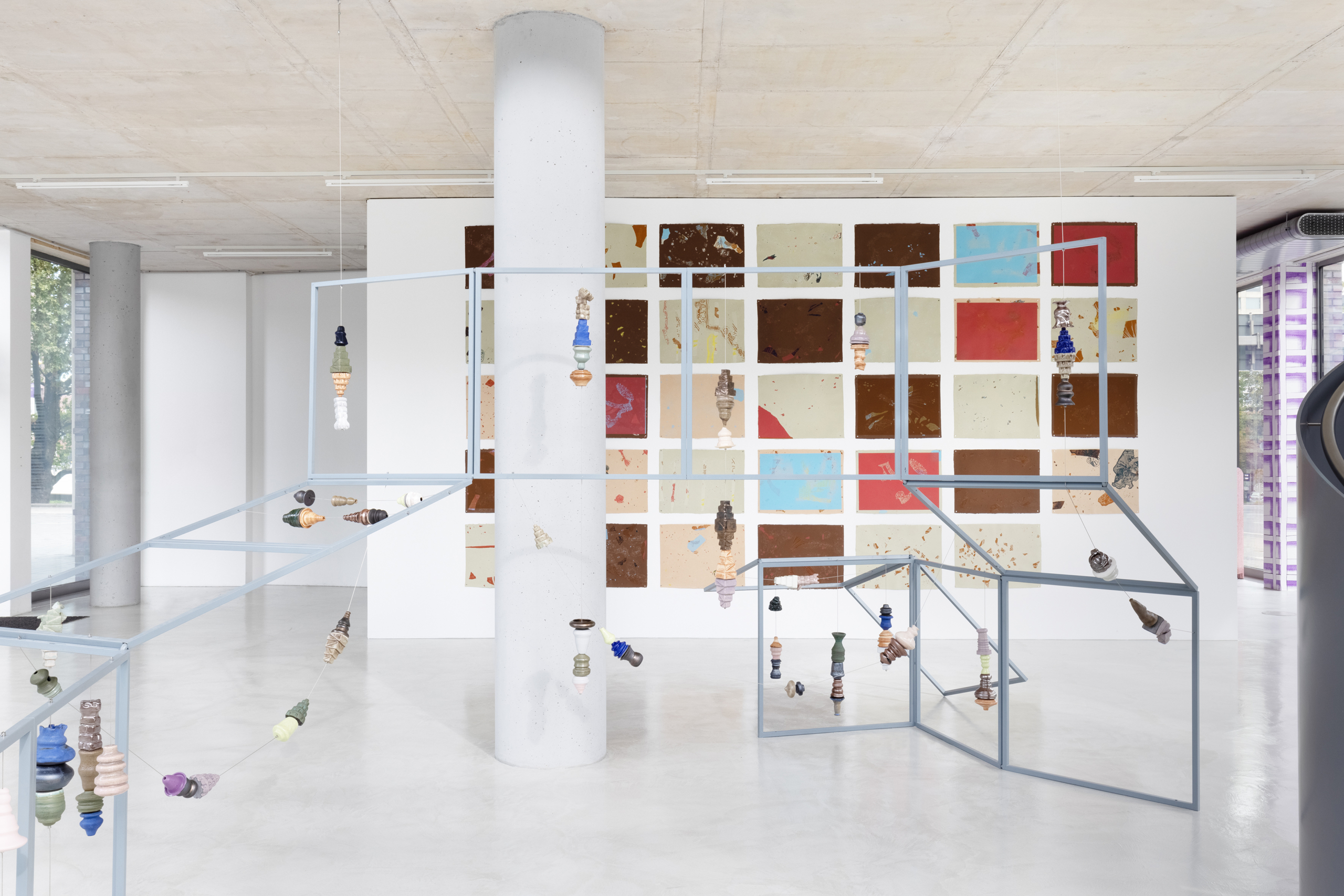
Mariana Castillo Deball, Stringing Beads (2025), installation view
Dortmunder Kunstverein, 2025.
Photo: Jens Franke.
Courtesy the artist © studio castillo deball
The present is built on the ruins of the past. Fragile in itself, it unfolds as a multiplicity of parallel presents, an endlessly overwritten sheet of paper shaped by layered narratives of community: at once interwoven and fragmented, grounded and adrift. As the Cameroonian historian Achille Mbembe (*1957) writes in ‚The earthly community‘ (2022), humans are “custodians along a chain of solidarity between the generations.”
For almost two decades, Mariana Castillo Deball has explored how systems of power shape and transform knowledge. Working at the intersection of art, science, history, and archaeology, she continually examines the institutional structures through which culture and history are preserved and passed on—looking not only at their taxonomies, categories, and grids, but also at their gaps, misreadings, and ideological uses.
Her new installation at Dortmunder Kunstverein takes inspiration from the Old Testament story of the Tower of Babel. Combining sculpture, works on paper, and a wall painting, ‚Stringing Beads‘ (2025) reflects on the fragility and instability of human existence. Around 250 hand-crafted ceramics are threaded onto a fantastically meandering steel framework—an enlargement of a folded papercut made by the artist. The ceramics, in different colors and orientations, activate and disrupt the grid of the square modules. Some of the hand-sized objects were cast in molds referencing Babel towers and Tarot imagery, while others were shaped on the pottery wheel, together with studio collaborators, reintroducing the rotation movement into the installation.
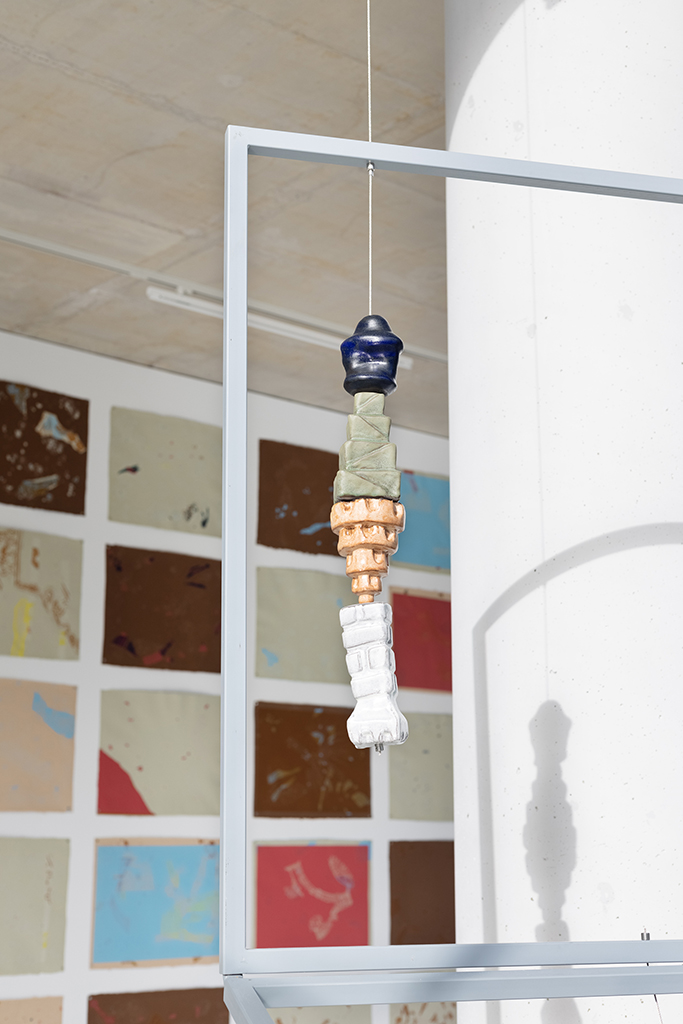
Mariana Castillo Deball, Stringing Beads (2025), installation view
(Detail), Dortmunder Kunstverein, 2025. Photo: Jens Franke.
Courtesy the artist © studio castillo deball

Mariana Castillo Deball, Stringing Beads (2025), installation view
(Detail), Dortmunder Kunstverein, 2025. Photo: Jens Franke.
Courtesy the artist © studio castillo deball
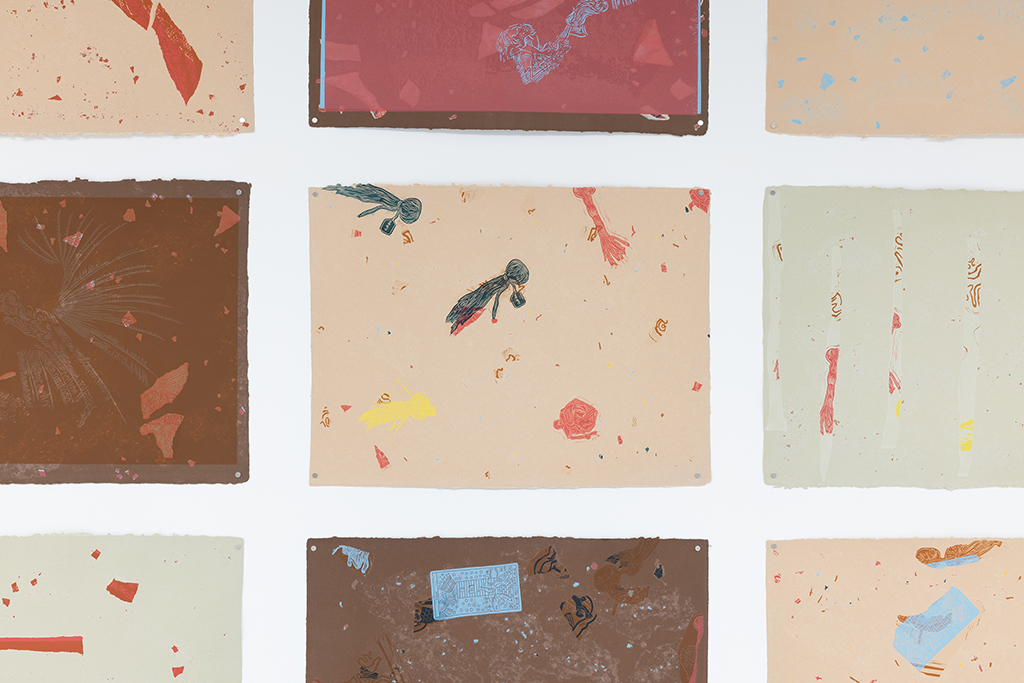
Mariana Castillo Deball, Cada Cosa es Babel (2023), installation view, Dortmunder
Kunstverein, 2025. Photo: Jens Franke.
Courtesy the artist; Mendes Wood DM, Brussels
The double perforation of the ceramic, known as ‚kill hole,‘ removes its function as a container—yet makes it more porous, open to connections with other vessels. Threading these fragile pieces becomes a metaphor for the precarious bonds that hold communities together. Castillo Deball contrasts the linear sequence of threading with the circular motion of the wheel: history both advances and repeats itself. Stringing Beads thus creates a cosmos of its own, one that grapples with ruptures in the transmission of stories as well as the cycles of construction, collapse, and rebuilding from fragments. The Greek kosmos (κόσμος) means both adornment and world order. Such order is not only material—movement, direction, weight, volume, time—but also relational, made of bonds whose stability is never secure, and which, like Babel, exist in a state of constant making, unmaking and remaking.
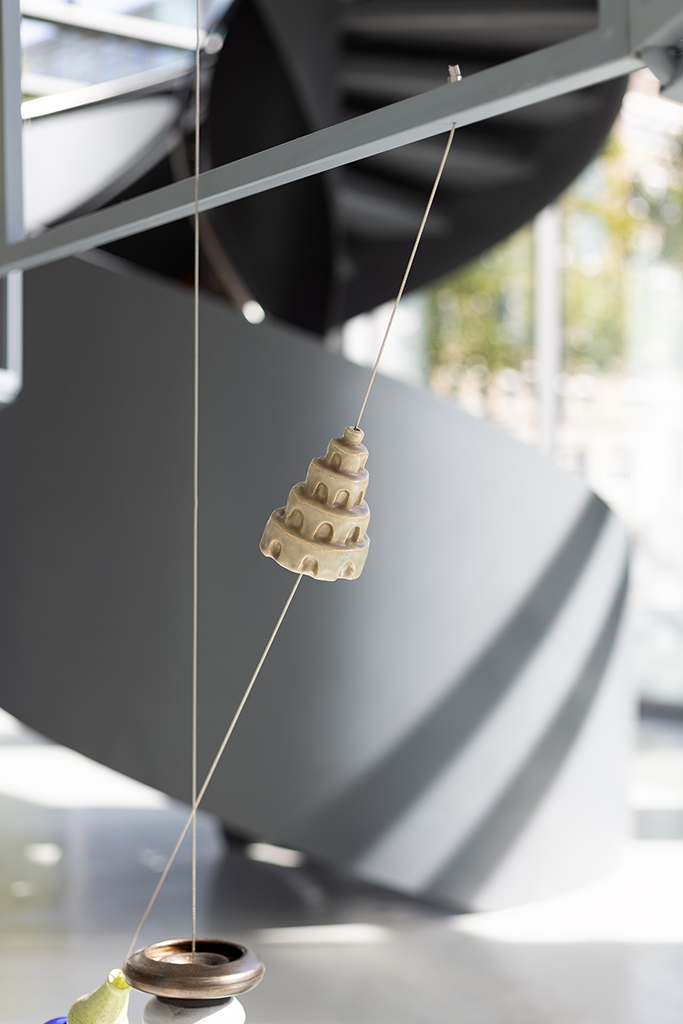
Mariana Castillo Deball, Stringing Beads (2025), installation view
(Detail), Dortmunder Kunstverein, 2025. Photo: Jens Franke.
Courtesy the artist © studio castillo deball
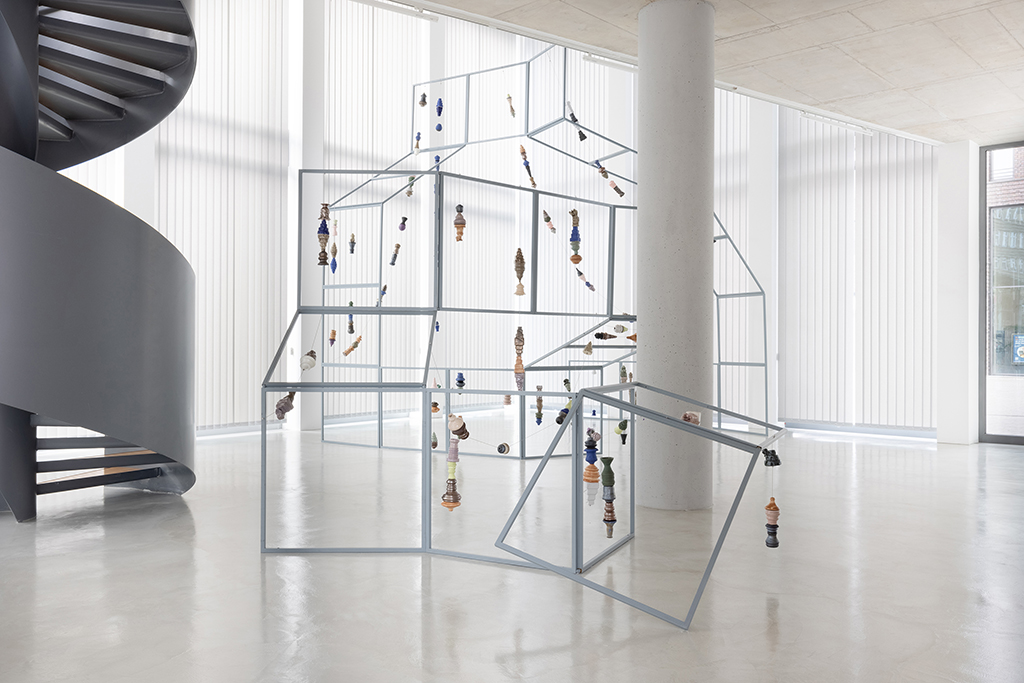
Stringing Beads, installation view, Dortmunder
Kunstverein, 2025. Curator: Rebekka Seubert Photo: Jens Franke.
Courtesy the artist © studio castillo deball

Mariana Castillo Deball, Stringing Beads (2025), installation view
(Detail), Dortmunder Kunstverein, 2025. Photo: Jens Franke.
Courtesy the artist © studio castillo deball
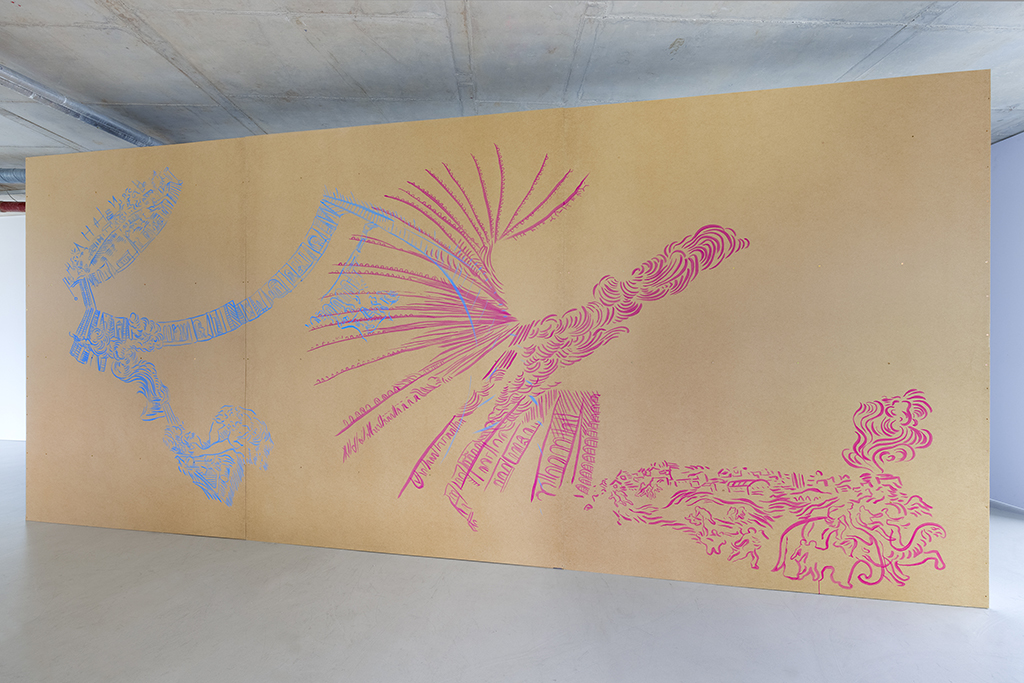
Mariana Castillo Deball, Cada Cosa es Babel (2023), installation view, Dortmunder
Kunstverein, 2025.
Photo: Jens Franke.
Courtesy the artist; Mendes Wood DM, Brussels
‚Cada Cosa es Babel‘ (2023) extends this inquiry in a wall painting and a series of works on handmade brown, apricot, and grey papers produced in collaboration with papermaker Gangolf Ulbricht. Castillo Deball created linocuts based on early modern depictions of the Tower of Babel a.o. by Pieter Bruegel the Elder (1563), Marten van Valckenborch (1595), and Marx Anton Hannas (1676). She then tore some of the prints apart, reintegrating the fragments into new sheets of paper like shards embedded in fresh layers. Reproduction is a recurring strategy in her work: ‚To reproduce an object is to read and understand it differently.‘ Here, the paper works resemble archaeological sections, examined in their grid arrangement, while the act of tearing and reintegration mirrors processes of historical layering and sedimentation.
The exhibition is marked by a sense for the ephemeral nature of the idea of wholeness—its possibility of dissolving into fragments any time—and that fragments, in turn, might cohere into a new entity. This tension animates the works, pointing to the generative potential of incompleteness.
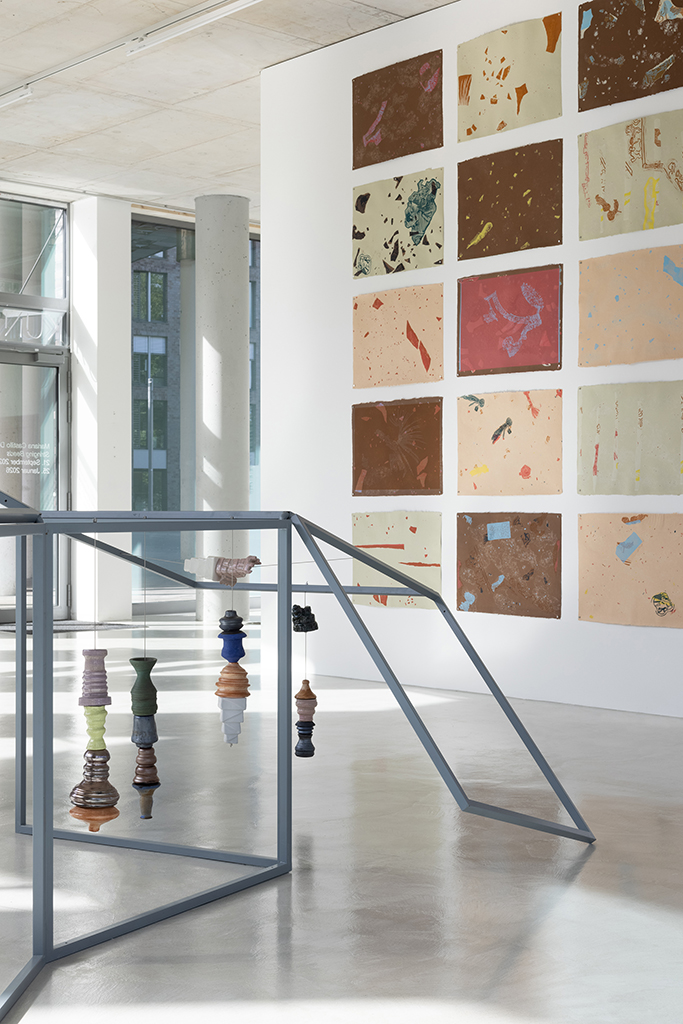
Mariana Castillo Deball, Stringing Beads (2025), installation view
(Detail), Dortmunder Kunstverein, 2025. Photo: Jens Franke.
Courtesy the artist © studio castillo deball
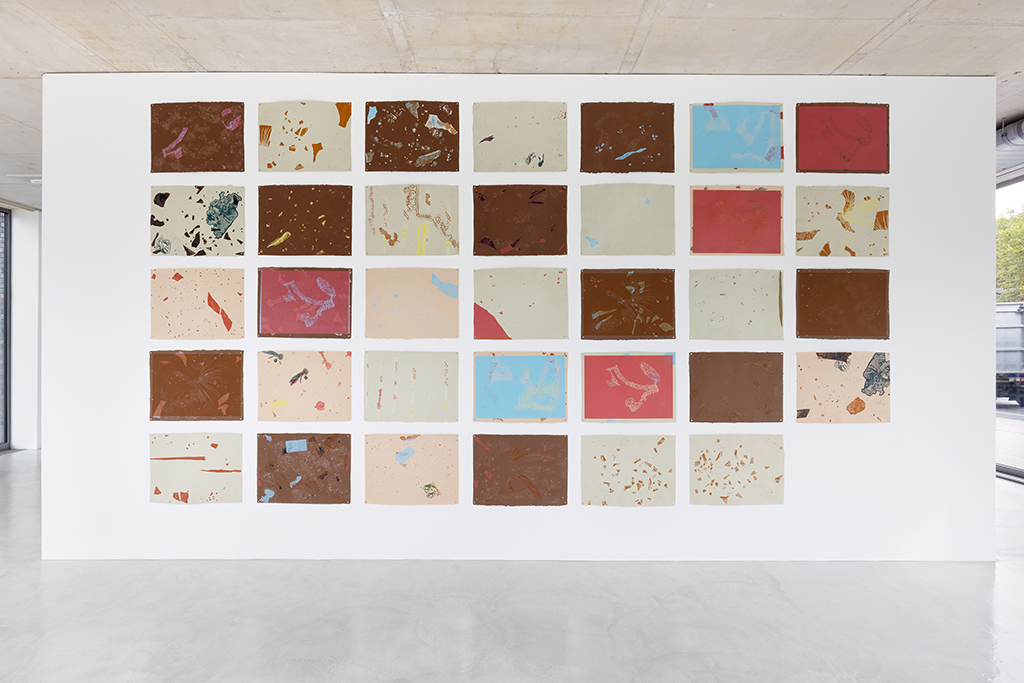
Mariana Castillo Deball, Cada Cosa es Babel (2023), installation view, Dortmunder
Kunstverein, 2025.
Photo: Jens Franke.
Courtesy the artist; Mendes Wood DM, Brussels

Mariana Castillo Deball, Stringing Beads (2025), installation view
(Detail), Dortmunder Kunstverein, 2025. Photo: Jens Franke.
Courtesy the artist © studio castillo deball
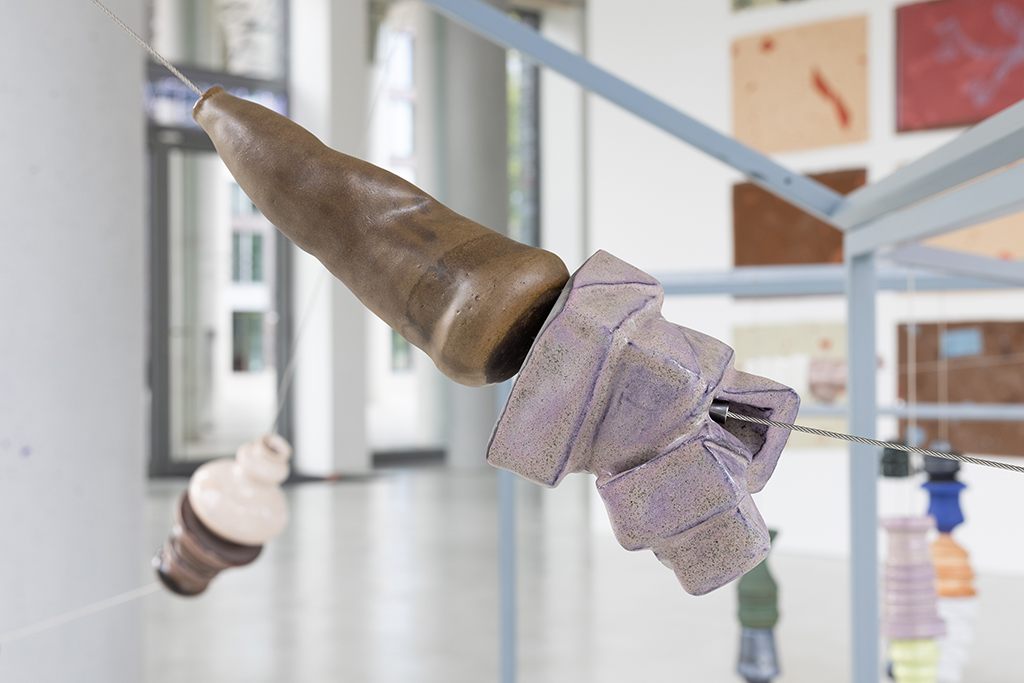
Mariana Castillo Deball, Stringing Beads (2025), installation view
(Detail), Dortmunder Kunstverein, 2025. Photo: Jens Franke.
Courtesy the artist © studio castillo deball

Stringing Beads, installation view, Dortmunder
Kunstverein, 2025. Curator: Rebekka Seubert Photo: Jens Franke.
Courtesy the artist © studio castillo deball
This constructed disorder, allows geological
surprises for the most abandoned memory
Museo experimental El Eco, Mexico city, Mexico
March 23 – May 15, 2011
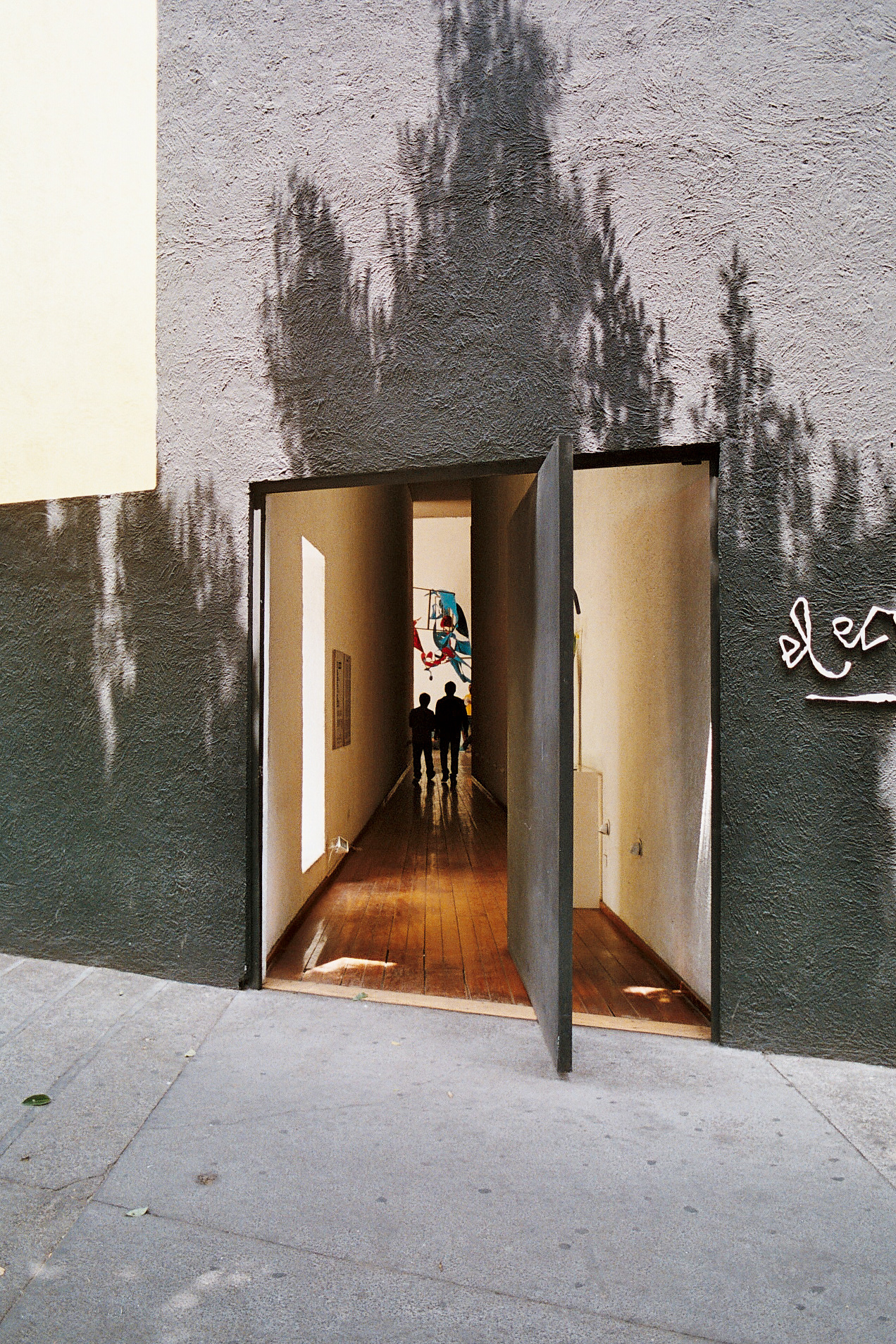
Este desorden construido, autoriza geológicas sorpresas a la memoria más abandonada, 2011
Museo Experimental El Eco, Mexico City, Mexico.
Conversation between Mariana Castillo Deball and Tobias Ostrander
TO The cave you have made for this project is a loose structure of open and closed spaces, made from a rectilinear metal frame, over which you have placed a faux-rock covering, made of paper-maché. Within the paper-maché appear numerous images. Could you describe your use of paper-maché in this work, as well as reveal some of the sources of the images you have imbedded within this material? If you could also touch on the development of the geometric frame, its form and the relation it sets up with the faux-rock covering.
MCD In his essay “The marble and the myrtle: on the inconstancy of the savage soul”, anthropologist Eduardo Viveiros d e Castro starts with a quote by the portuguese missionary Antonio Vieria:
“Those who wandered through the world can see in those gardens two kinds of very different statues, ones made out of marble, others of myrtle. The marble statues are very difficult to make, because of the hardness and resistance of matter; but once finished, it is not necessary to work on it any more: always preserves the same figure; the myrtle statue is easier to form, because of the docility of the branches and the leaves, but it is necessary to work on it constantly. If the gardener stops working, in four days there is a branch going through the eyes, another one that deforms the ears, instead of five fingers seven appear, what it was before a human shape, becomes a confusion of green and myrtles.”
Through this image, Vieira compares European and “savage” civilizations. For him, European culture is similar to marble, difficult to mold, but once the shape is done, it is a guaranty that it will last over the centuries. On the contrary, the “savage” civilizations, like the Brazilian in this case, are more malleable, at first sight it seems that they accept the doctrine, and adapt themselves to the imposed habits, nevertheless it is just necessary to be distracted for a second and they return
to their old rituals.
The piece I developed for El Eco follows the behavior of a myrtle sculpture, which climbs over a geometric shape. The pattern is similar to an epiphyte plant, such as bromelias or orchids that grows upon another plant or sometimes upon some other object, without a parasite behavior. They are also called air plants. I use papier-mâché, a technique that I have been interested for a long time, because of its flexibility and simplicity and also the link it has with Mexican crafts. The images that cover the structure are based on my experience in Brazil during the last two years. They include people, places and travels where I followed “the inconstancy of the savage soul”, discovering its generosity, flexibility and playfulness.
The Museum of the images of the unconscious, where I discovered their amazing archive and the paintings of Artur Amora, the National Museum, where I learned about Amerindian perspectivism, the house of Lina Bo Bardi in Sao Paulo, her exhibitions of popular art, the botanical garden in Rio de Janerio, the wastelands of paper-maché sculptures after the carnival, Glauber Rocha, mathematical models of non-linear figures, and many more. (read more)
The exhibition was curated by Tobias Ostrander
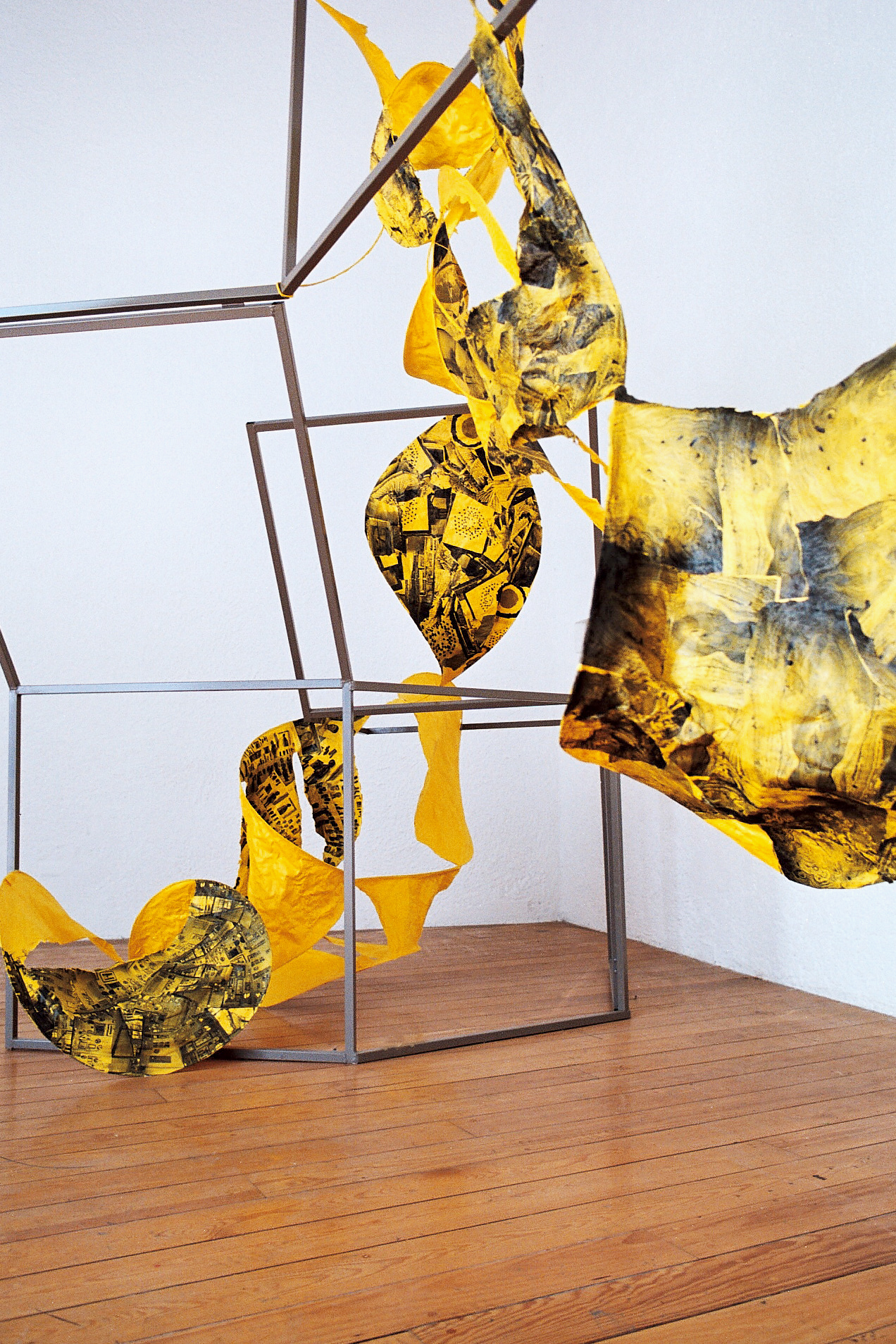
Detail: Este desorden construido, autoriza geológicas sorpresas a la memoria más abandonada, 2011
Metal structure, papier-mâché, laser prints and aluminum wire
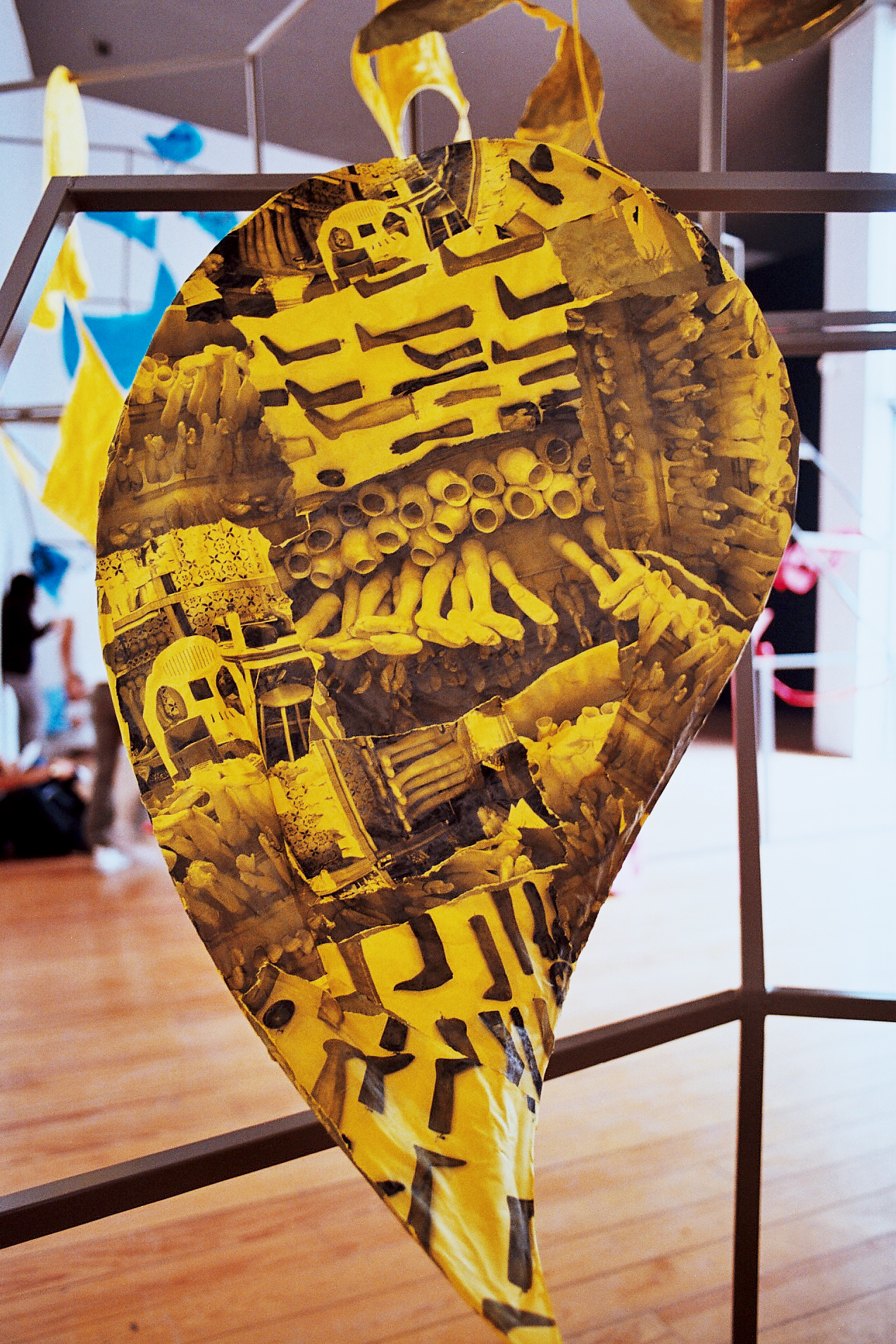
Detail: Este desorden construido, autoriza geológicas sorpresas a la memoria más abandonada, 2011
Metal structure, papier-mâché, laser prints and aluminum wire
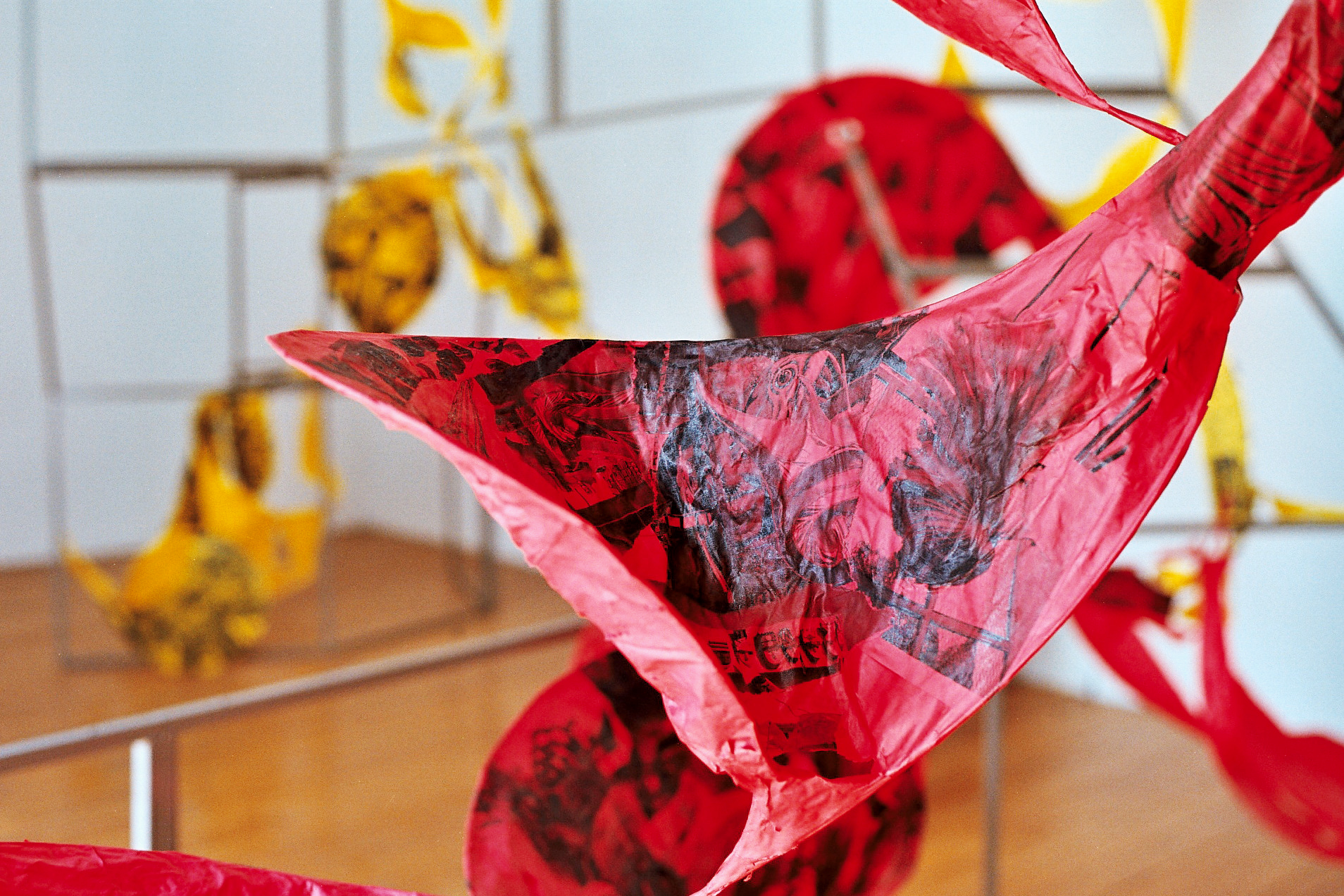
Detail: Este desorden construido, autoriza geológicas sorpresas a la memoria más abandonada, 2011
Metal structure, papier-mâché, laser prints and aluminum wire
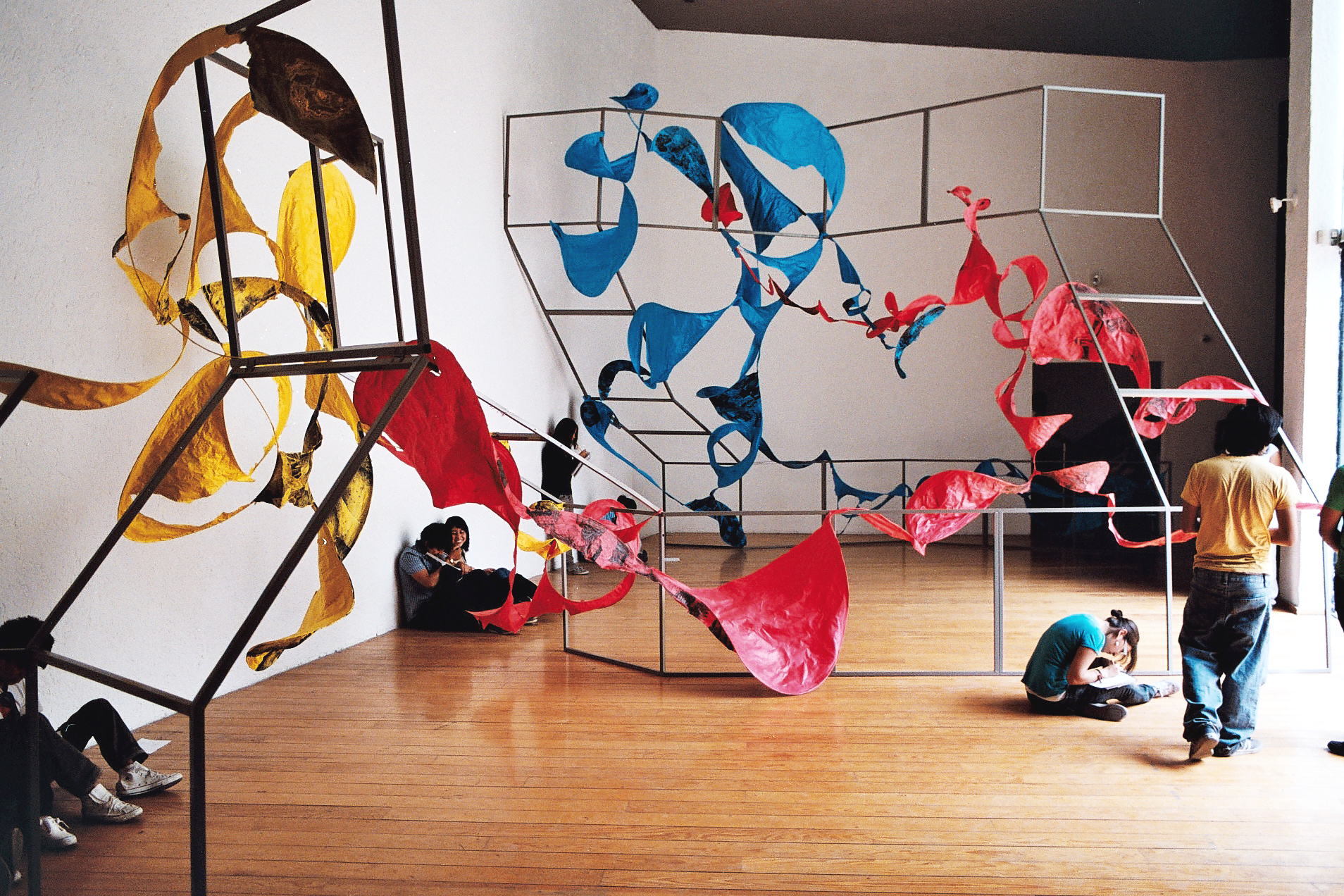
Installation view Este desorden construido, autoriza geológicas sorpresas a la memoria más abandonada, Museo Experimental El Eco, Mexico City, Mexico, 2011.
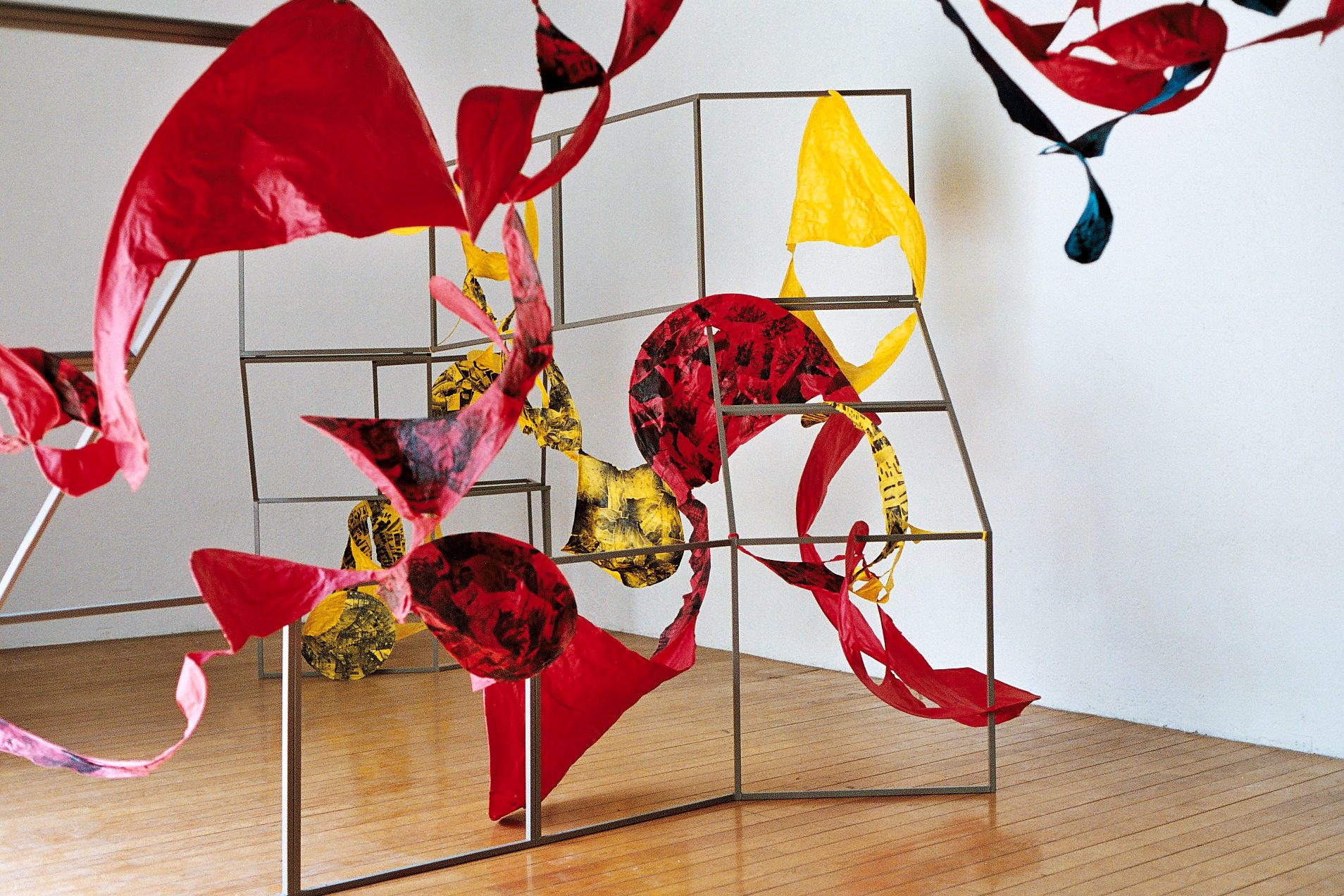
Detail: Este desorden construido, autoriza geológicas sorpresas a la memoria más abandonada, 2011
Metal structure, papier-mâché, laser prints and aluminum wire
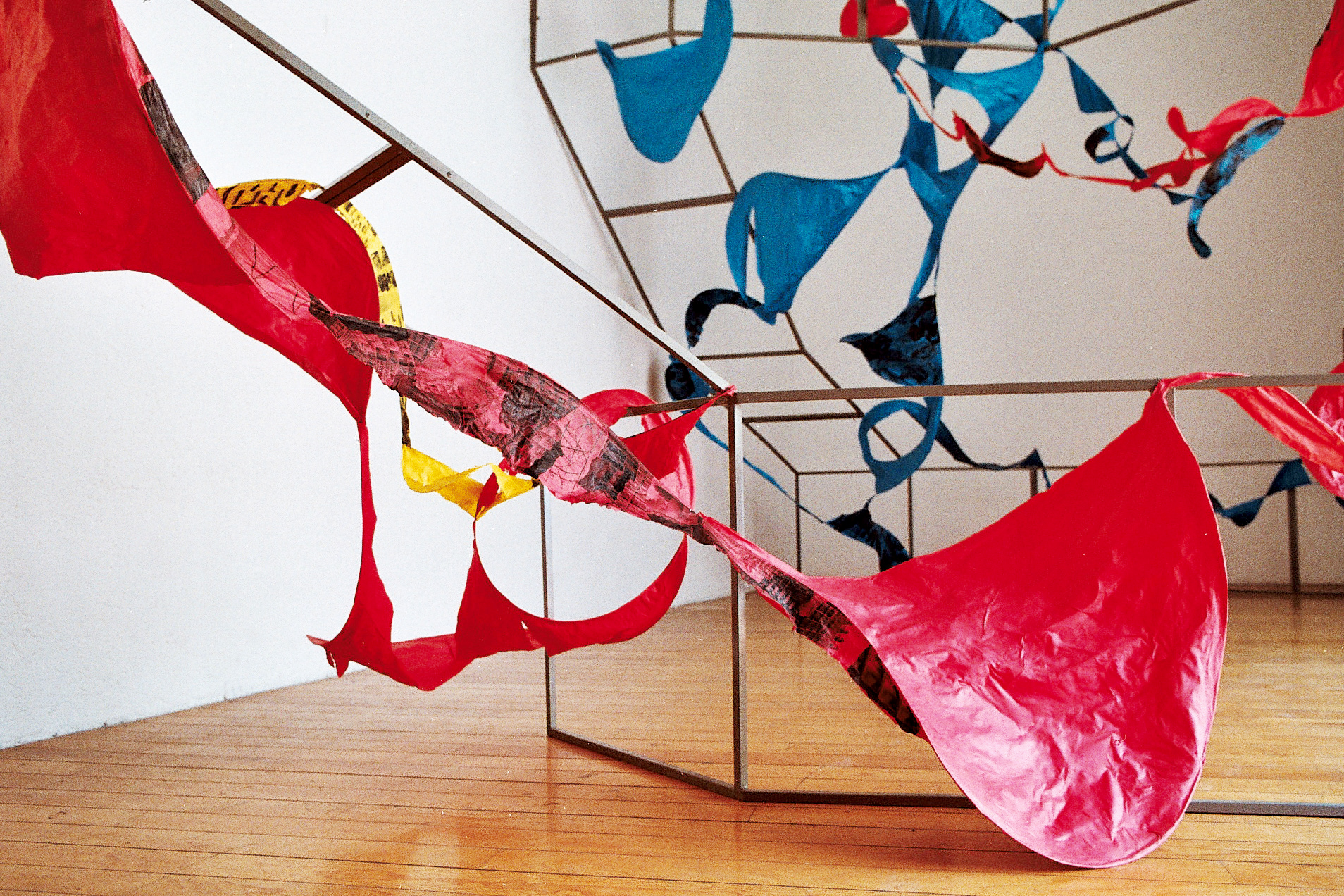
Detail: Este desorden construido, autoriza geológicas sorpresas a la memoria más abandonada, 2011
Metal structure, papier-mâché, laser prints and aluminum wire
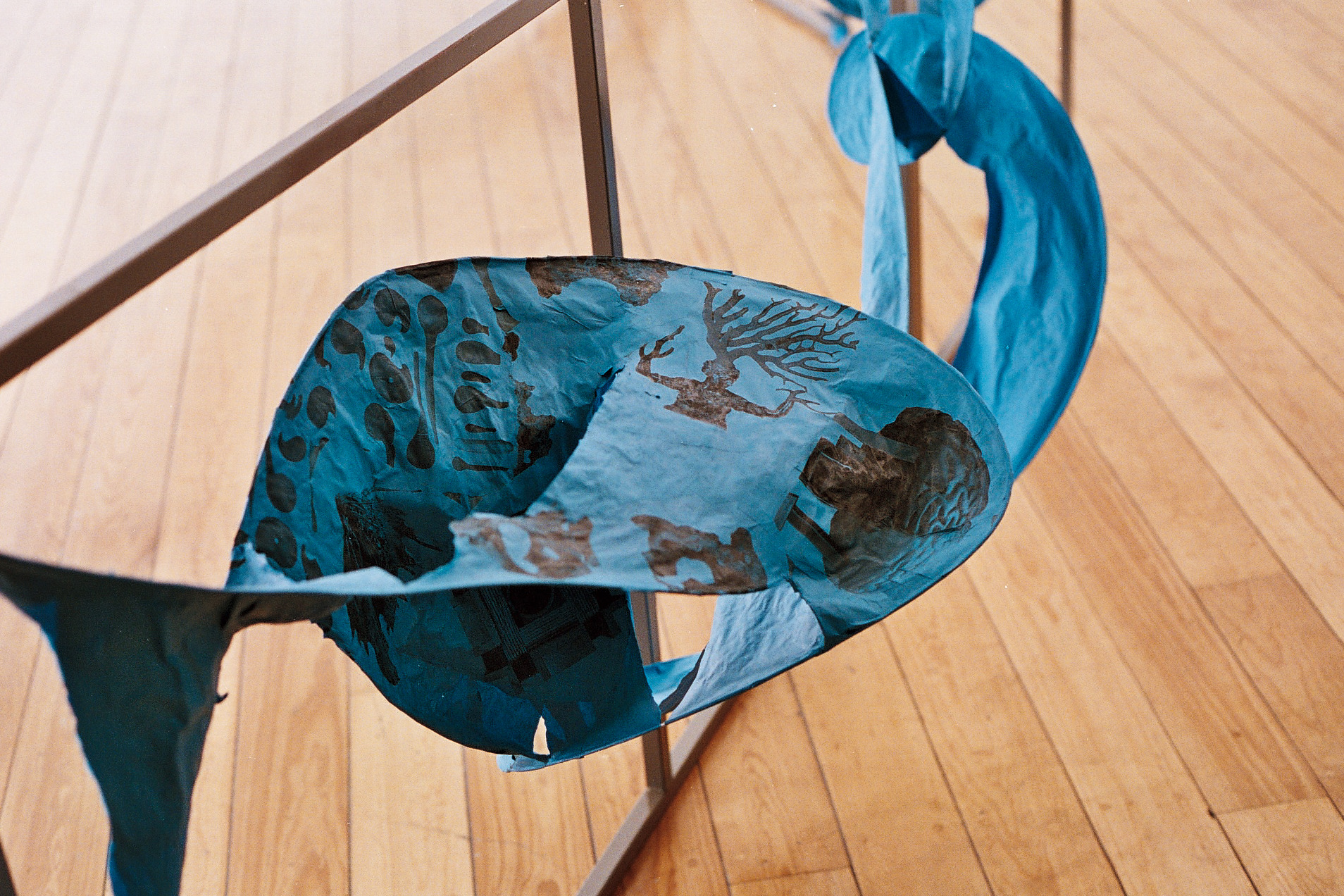
Detail: Este desorden construido, autoriza geológicas sorpresas a la memoria más abandonada, 2011
Metal structure, papier-mâché, laser prints and aluminum wire
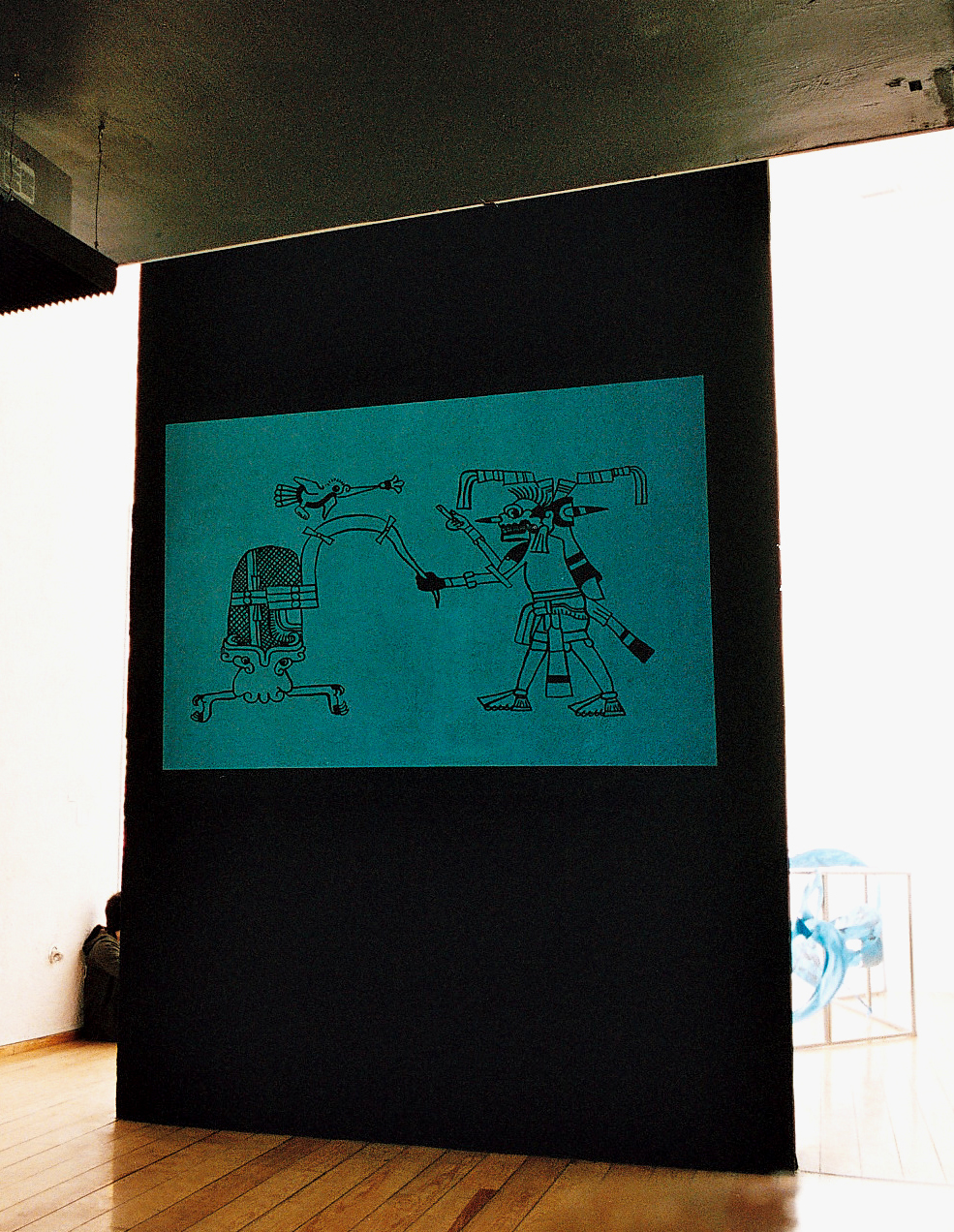
Este desorden construido, autoriza geológicas sorpresas a la memoria más abandonada, Museo Experimental El Eco, Mexico City, Mexico, 2011.
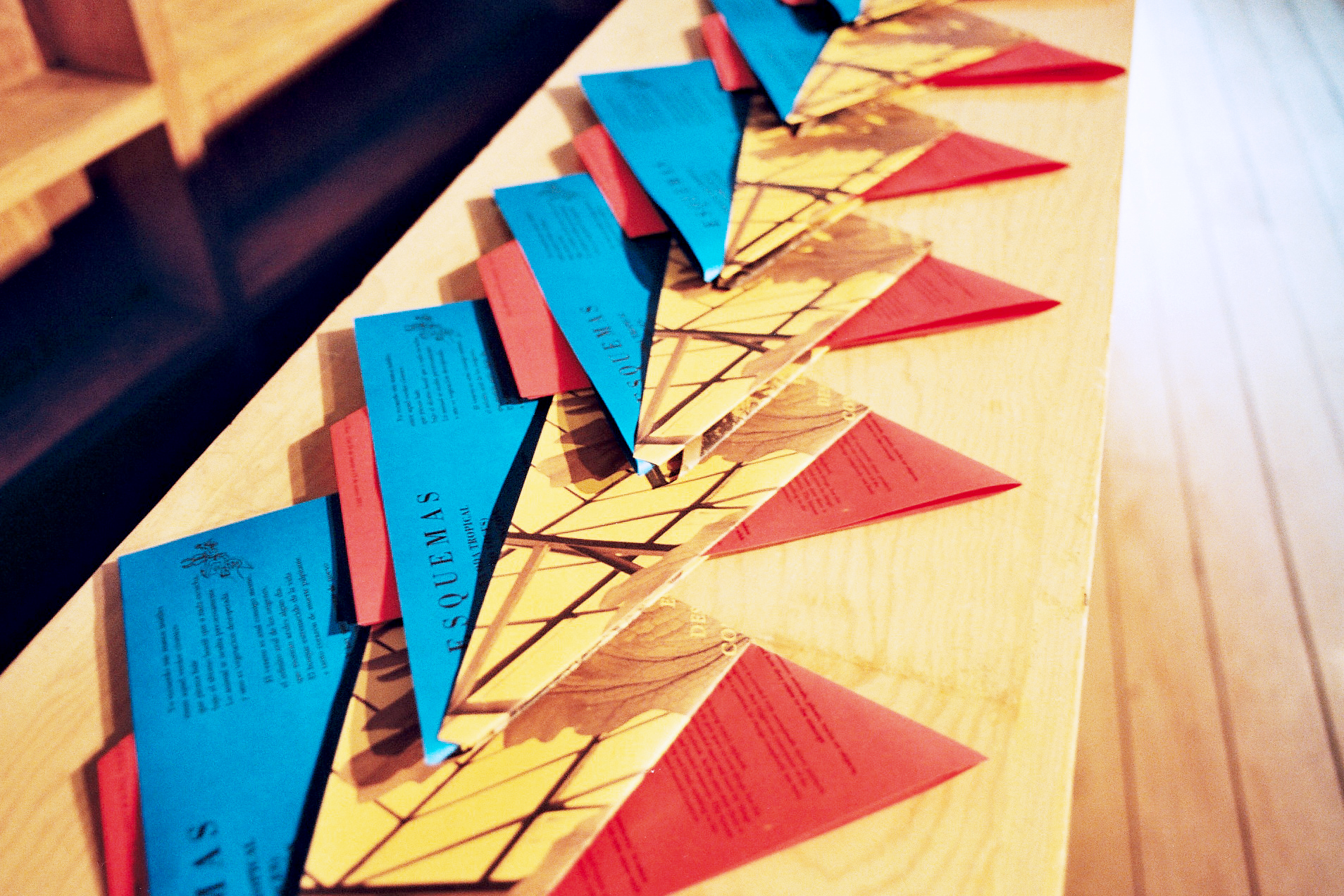
Este desorden construido, autoriza geológicas sorpresas a la memoria más abandonada, Museo Experimental El Eco, Mexico City, Mexico, 2011.
We are silently illiterate
Galerie Barbara Wien, Berlin
September 6 – November 4, 2011
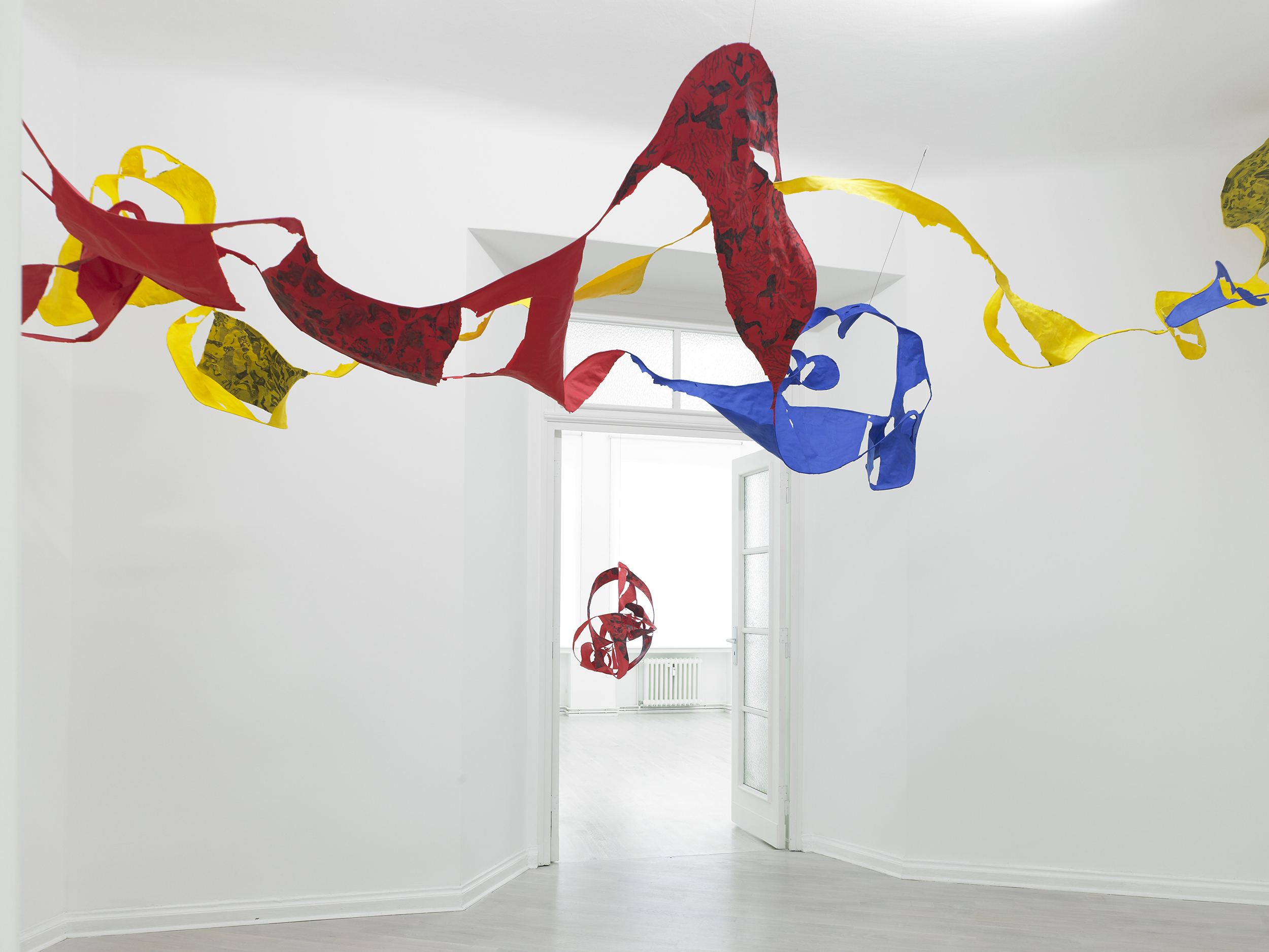
Trópico, ¿para que me diste las manos llenas de color?, 2011
Paper-mâché, aluminium wire, laser prints.
Photo: Nick Ash
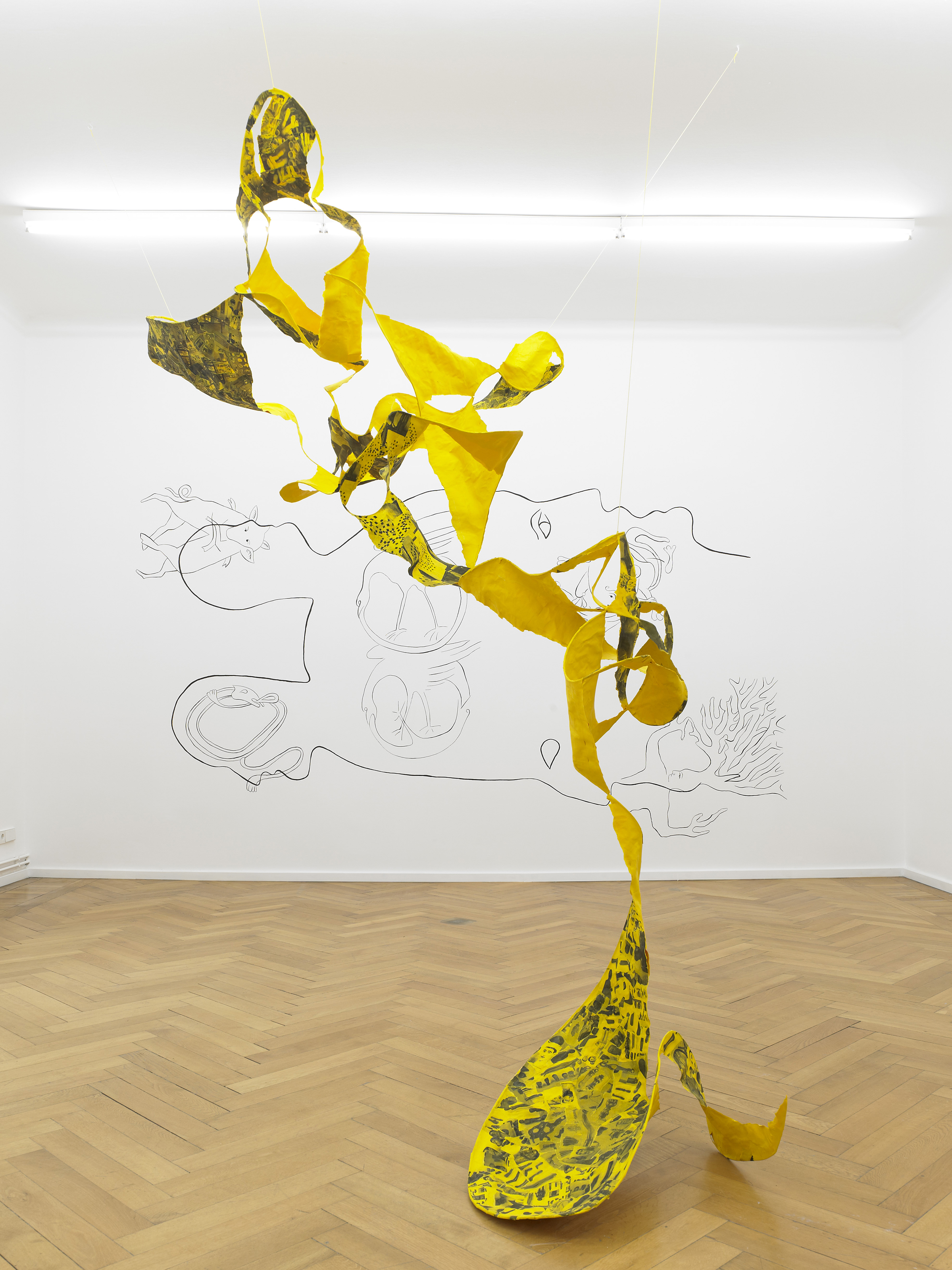
Reflejos de cien espejos tu cuerpo, 2011
Paper-mâché, aluminium wire, laser prints
Installation view We are silently illiterate, Galerie Barbara Wien, Berlin 2011
. Photo: Nick Ash
We are silently illiterate, deals with "Uncomfortable Objects". It is populated with non-humans, that tell their own stories, and of potential images, that can be constructed by the viewer. All of these make clear that perception is a tricky thing. The anthropologist Roy Wagner puts it like this: "The brain is the only organ in the body that is narcissistic enough to actually believe it is thinking."
An example for this concept of "Uncomfortable objects" is the film El Donde estoy va desapareciendo / The where I am is vanishing. The piece is based on the Borgia Codex, one of the few pre-Columbian Mesoamerican codices which survived the book-burning policies of the Spanish conquerors. The film tells, from the point of view of the Borgia Codex, the different adventures and transformations, from how it was brought to Europe and stored unread for many hundred years in a collection of the Vatican in Rome before it was eventually deciphered by a Mexican Jesuit (and Alexander von Humboldt). The book tells its odyssey in the languages of its different owners. The story is accompanied by ink drawings that pass the viewer as a long and calm leporello of images. This 10 meters long leporello is shown besides the film at the Venice Biennale. In our exhibition we present the film vocabulary on separate ink drawings.
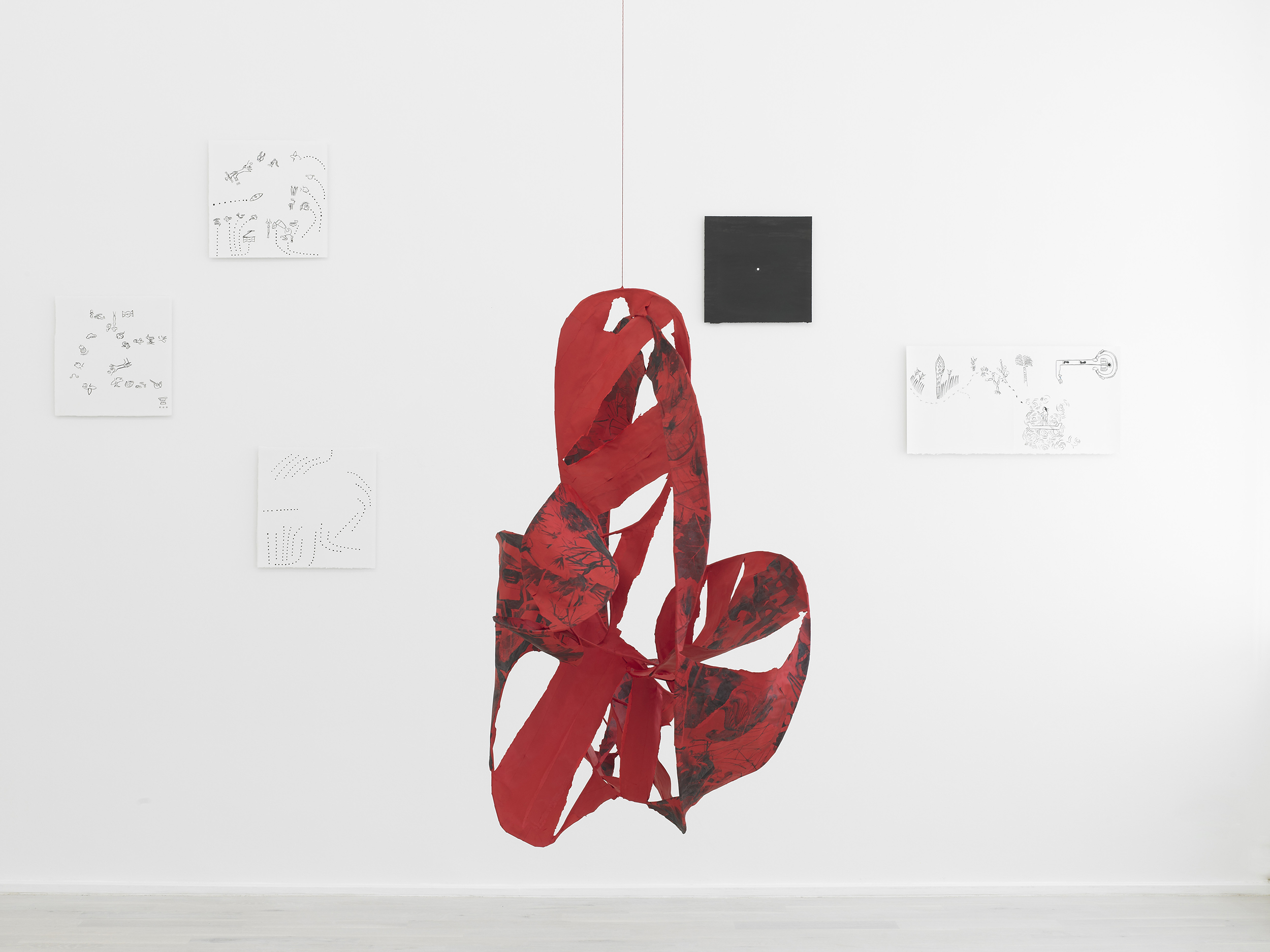
Nadie sabe que hora es, 2011
Paper-mâché, aluminium wire, laser prints. Photo: Nick Ash
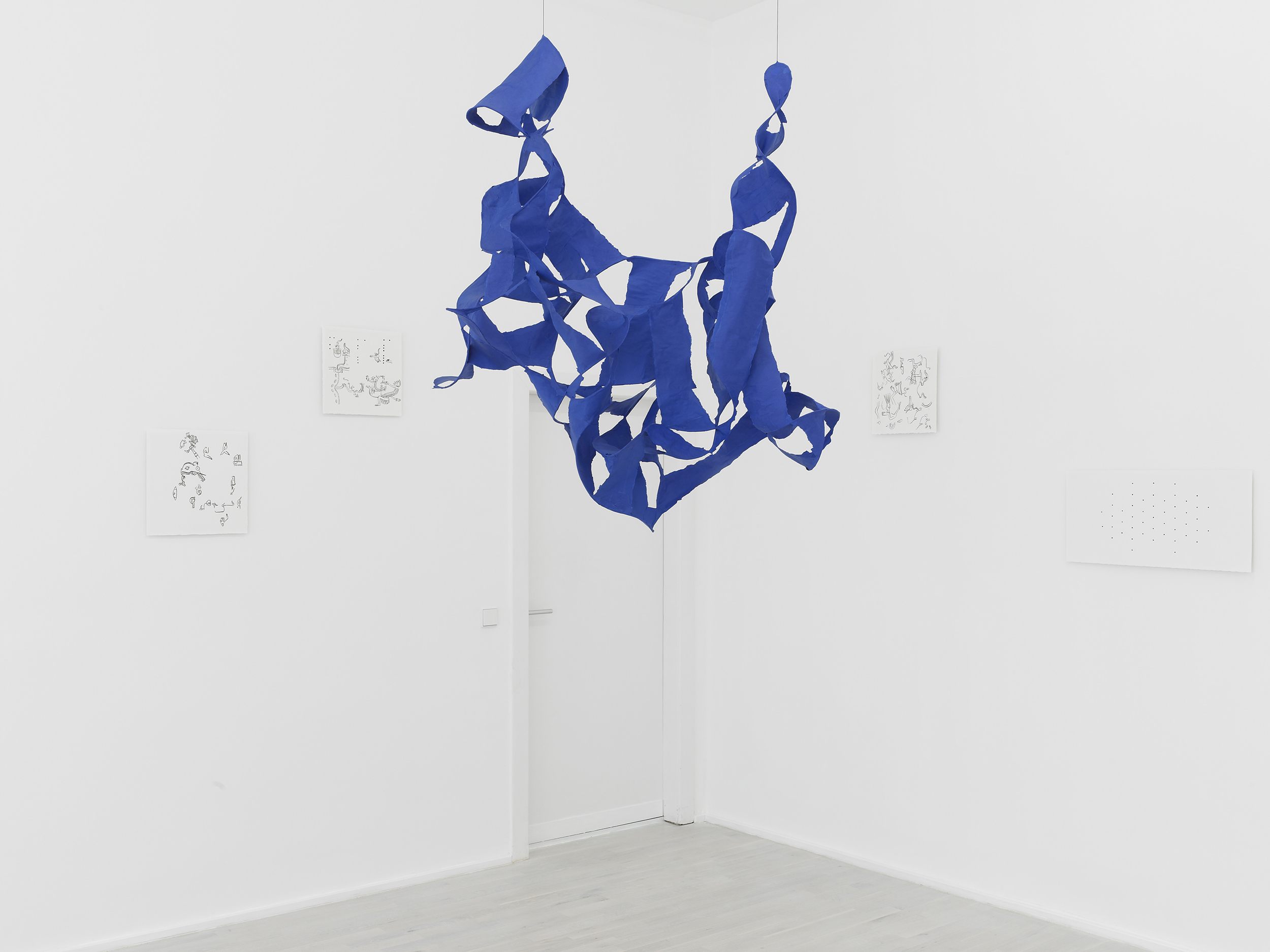
Hay azules que se caen de morados, 2011
Paper-mâché, aluminium wire, laser prints. Photo: Nick Ash
Another part of these "Uncomfortable Objects" are colorful sculptures made out of papier-mâché, a flexible and simple material that is widely used in Mexico. The sculptures behave as epiphytes plants, such as bromeliads or orchids that grow upon another plant or sometimes upon some other object, without a parasite behavior. They are also called air plants.
The sculptures are populated by images based on Deball’s experience in Brazil during the last two years. They include people, places and travels where she followed the inconstancy of the savage soul, discovering its generosity, flexibility and playfulness. The Museum of the images of the unconscious, where she discovered their amazing archive and the paintings of Artur Amora, the National Museum, where she learned about Amerindian perspectivism, the house of Lina Bo Bardi in Sao Paulo, her exhibitions of popular art, the botanical garden in Rio de Janerio, the wastelands of papier-maché sculptures after the carnival, Glauber Rocha, mathematical models of non-linear figures, and many more.
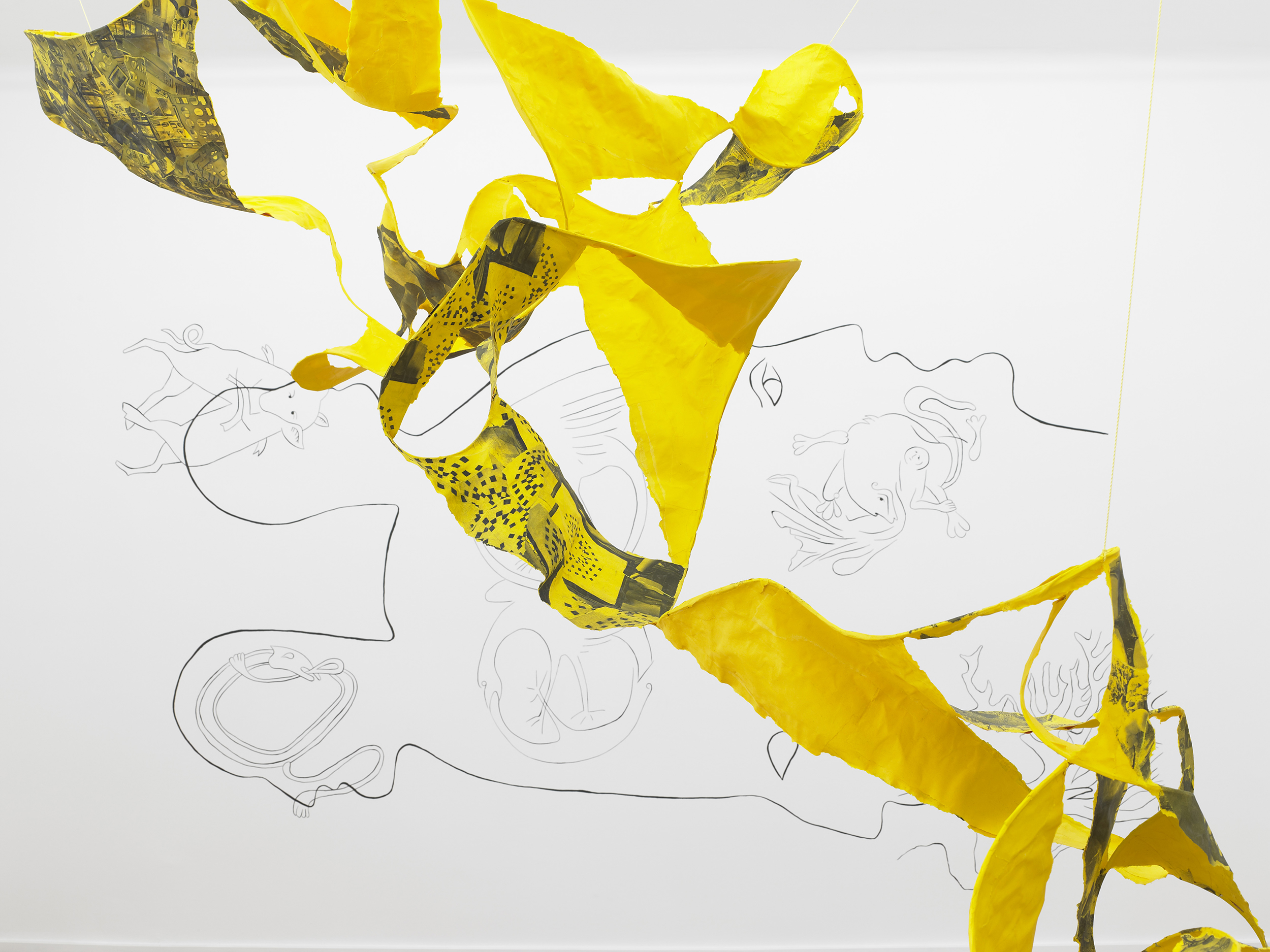
Reflejos de cien espejos tu cuerpo, 2011
Paper-mâché, aluminium wire, laser prints. Photo: Nick Ash
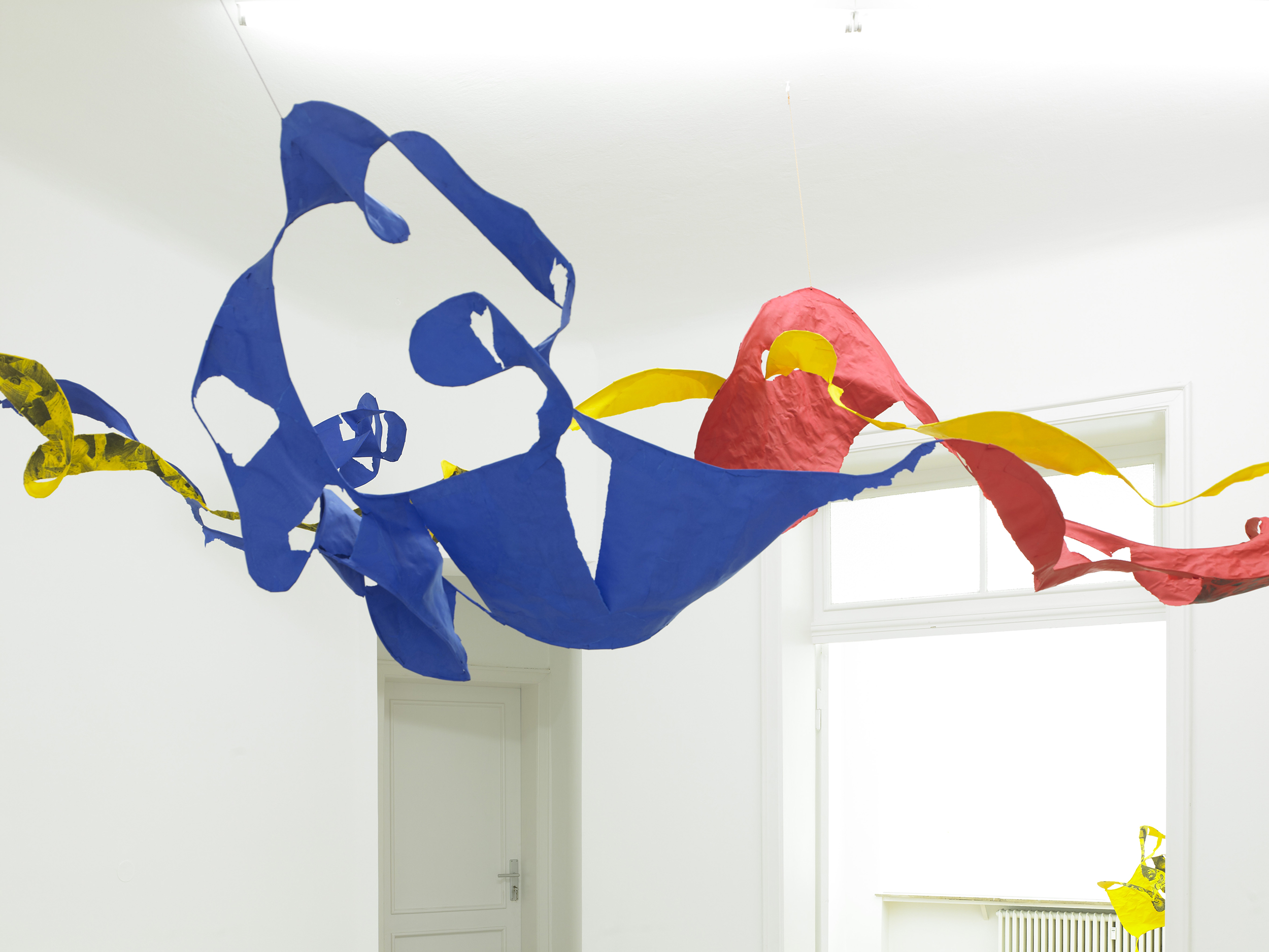
Trópico, ¿para que me diste las manos llenas de color?, 2011
Paper-mâché, aluminium wire, laser prints. Photo: Nick Ash
First Deball collected dialogues and fables among non-humans, such as Aesop‘s fables, Ovid’s metamorphoses, Lewis Carroll’s dialogues, and fables by Augusto Monterroso, Horacio Quiroga, Antonin Artaud, Sor Juana Ines de la Cruz, Mario de Andrade, Franz Kafka, and Montaigne. At the beginning she found these dialogues only in fiction literature, but afterwards she found experiments of that sort among historians of science, philosophers, and anthropologists. She explains the reason for dedicating a whole series of exhibitions and books to these Uncomfortable Objects in an interview with Tobias Ostrander:
"What non-humans have to say about the world we constructed around them, about our definitions, manipulations and usages? What is left of the objects after so much historical maneuvering and what would be the testimony of these objects if they could tell us their story from their perspectives. Our contemporary society is crowded with uncomfortable objects, products of desire, research or imagination; they trigger our conception of the world and compel us to take a position, to change completely our basic understanding of the universe. Uncomfortable objects are constantly being erased, replaced, neutralized and destroyed in order to give space to new things, but this erasure is never complete, we are surrounded more and more by things, quasi-things, fragments, distortions and hybrids (….) …but we don’t know how to deal with this diversity…"
Figures don’t lie but liars can figure
Pinksummer, Genova, Italy
February 26 – 1 April, 2011
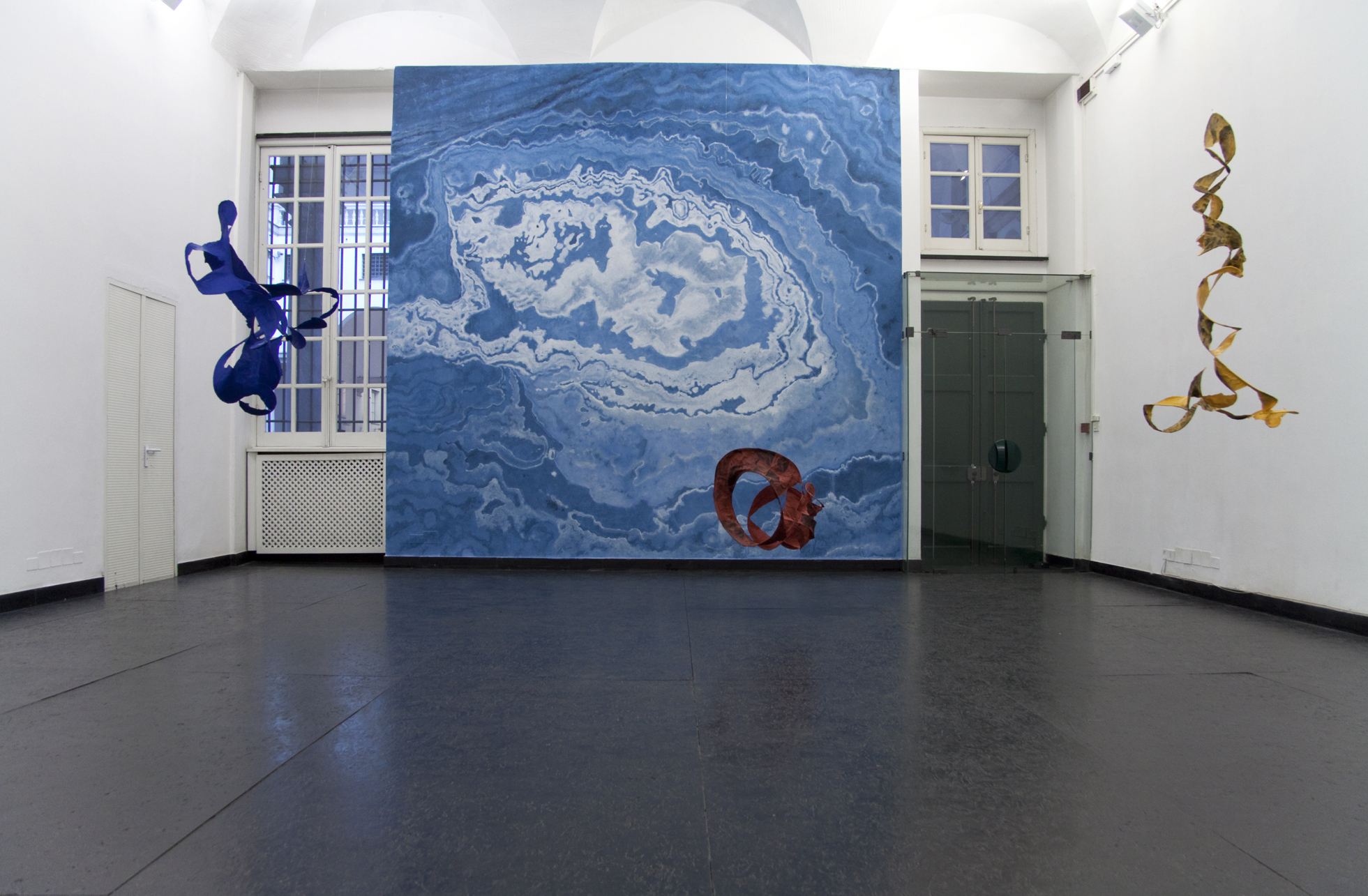
Installation view Figures don’t lie but liars can figure, pink summer, Genova, Italy, 2011
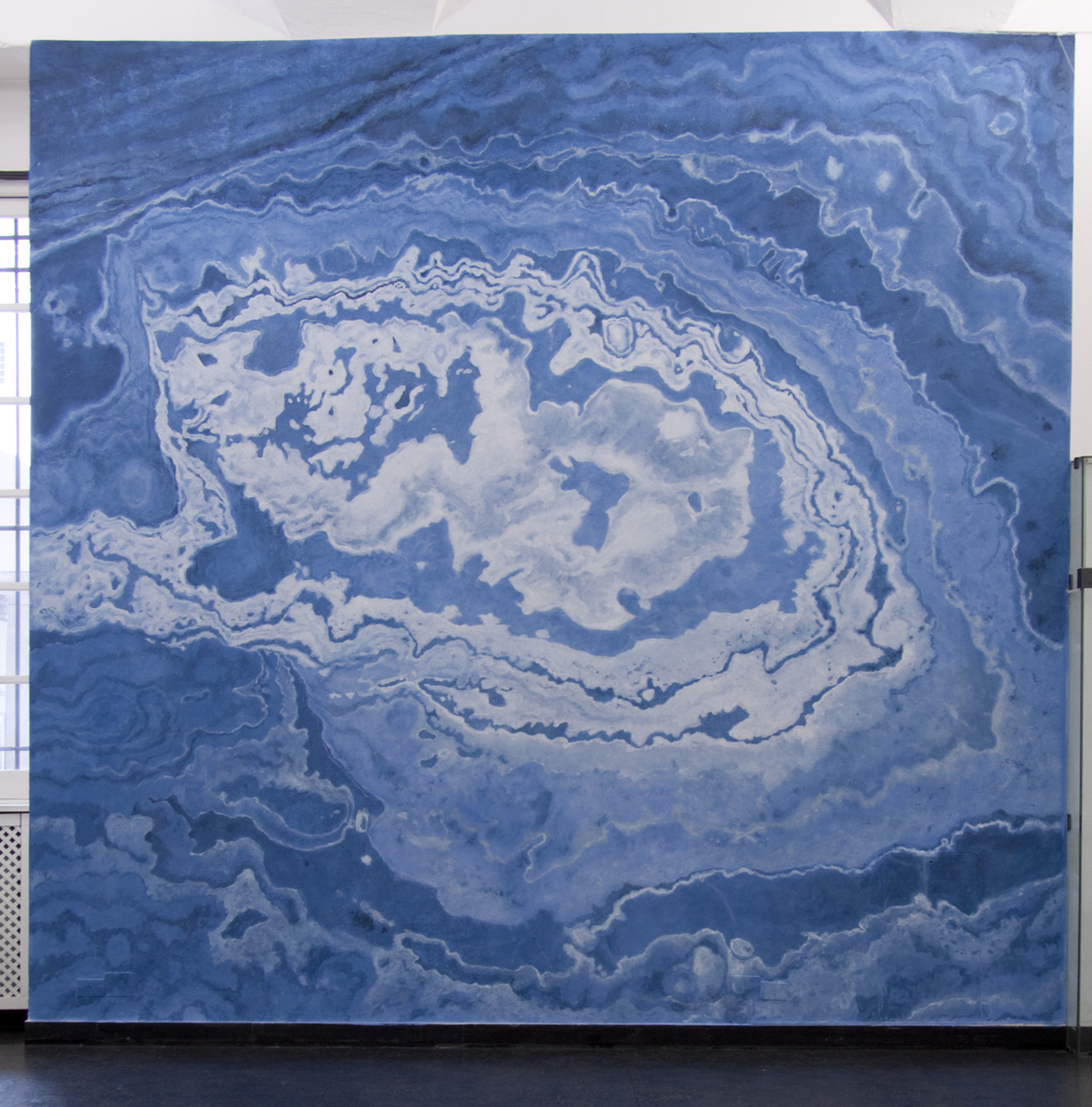
Agua via, 2011
Colored cement, acrylic paint. glaze, microcrystalline wax
Conversation between Antonella Berutti
and Mariana Castillo Deball
AB Let’s start from the proverb, attributed, among the others, to Mark Twain, that you have chosen as title of the show at pinksummer: Figures don’t lie, but liars can figure.
MCD I found the title for the exhibition, Figures don’t lie but liars can figure, in Roy Wagner’s book, Coyote Anthropology; a series of conversations between Wagner and Coyote, spiraling around the question of how meaning is created, a game of hide and seek between perception, representation and reality. According to Coyote, “perception is a very tricky thing”.
Roy: “So why is perception a fake?”
Coyote: “See, Roy, we do not see the world we see, hear the sounds we hear, touch the things we touch, or in any way perceive what we perceive, but that something else comes in-between.”
Coyote: “Sure. As they say: ‘Figures don’t lie, but liars can Figure.’”
Roy: “The sounds and shapes that you have been trained to react to and project (so that by now it has become quite unconscious) form the pattern or content of first-attention reality. The spaces between and around those words, or between the words and the things they stand for, which you notice only in passing, form the backdrop of second-attention reality.”
AB You ascribe two different cognitive attitudes to the myth of Echo and Narcissus, assimilating Echo to a feminine and matriarchal modality, open to the surroundings and able to be transformed by it. Narcissus, while looking for his reflection, transforms the world into a mirror to affirm his individuality. You link Echo to the experience needed to recognize shapes in a mineral concretion of a cave, where to draw out a shape an imaginative power is requested. Narcissus represents the neutrality of common exhibition spaces, museums or galleries, where shapes are immediately identifiable. Now, for your solo show, will pinksummer be a gallery or a cave?
MCD Last summer I made a visit to the Chapada Diamantina, a region in Brazil covered with mountains, caves and other mineral formations. While visiting some of the caves it happened very often that the guide would point out a particular formation and ask to the visitants, what is it? Visitors needed to stare to the abstract walls and guess. The figures ranged from a dolphin, a face, a mermaid, an electric guitar, and a piece of bacon.
I found interesting a space where figures are apparently hidden; almost blend with the environment, a space where there is no difference between figure and background. I started to think how different museums and galleries are from the cave experience, where the spaces are neat and white, where the works are immediately recognizable.
In terms of mythology, I thought of Narcissus as an exhibition space, and Echo as a cave. The practice of finding images in stains on the walls and rock formations is closer to the imaginative nature of Echo, who tries to repeat what Narcissus says, but her voice gets inevitably distorted, becoming something else all the time.
On the opposite way, Narcissus is a repetition device, trying constantly to confirm his image, through his reflection on the water. The consequences of this gesture imply a complete denial of the outside world, in order to confirm the uniqueness of the self.
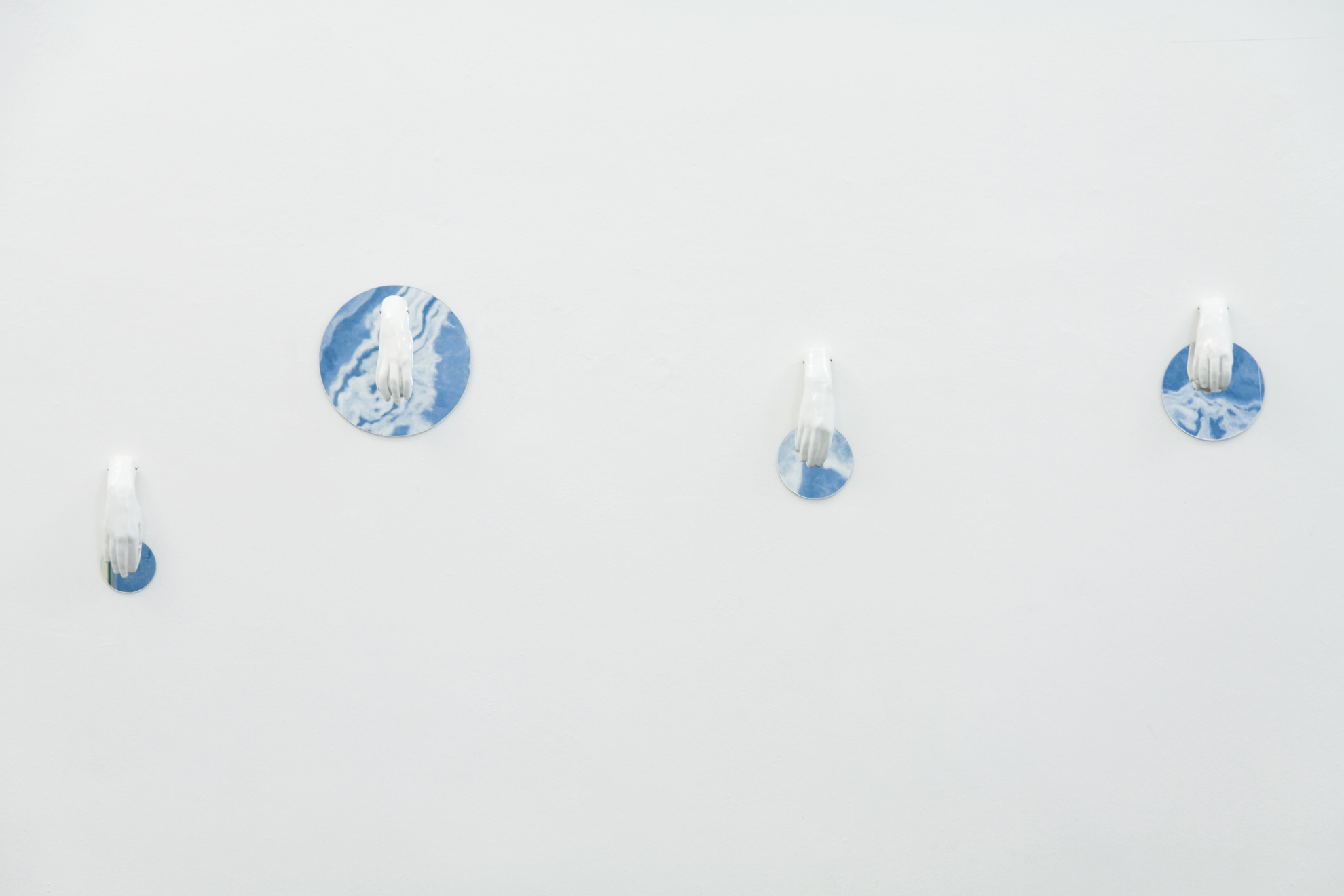
Distanza e menzogna, 2006
Porcelain, mirrors
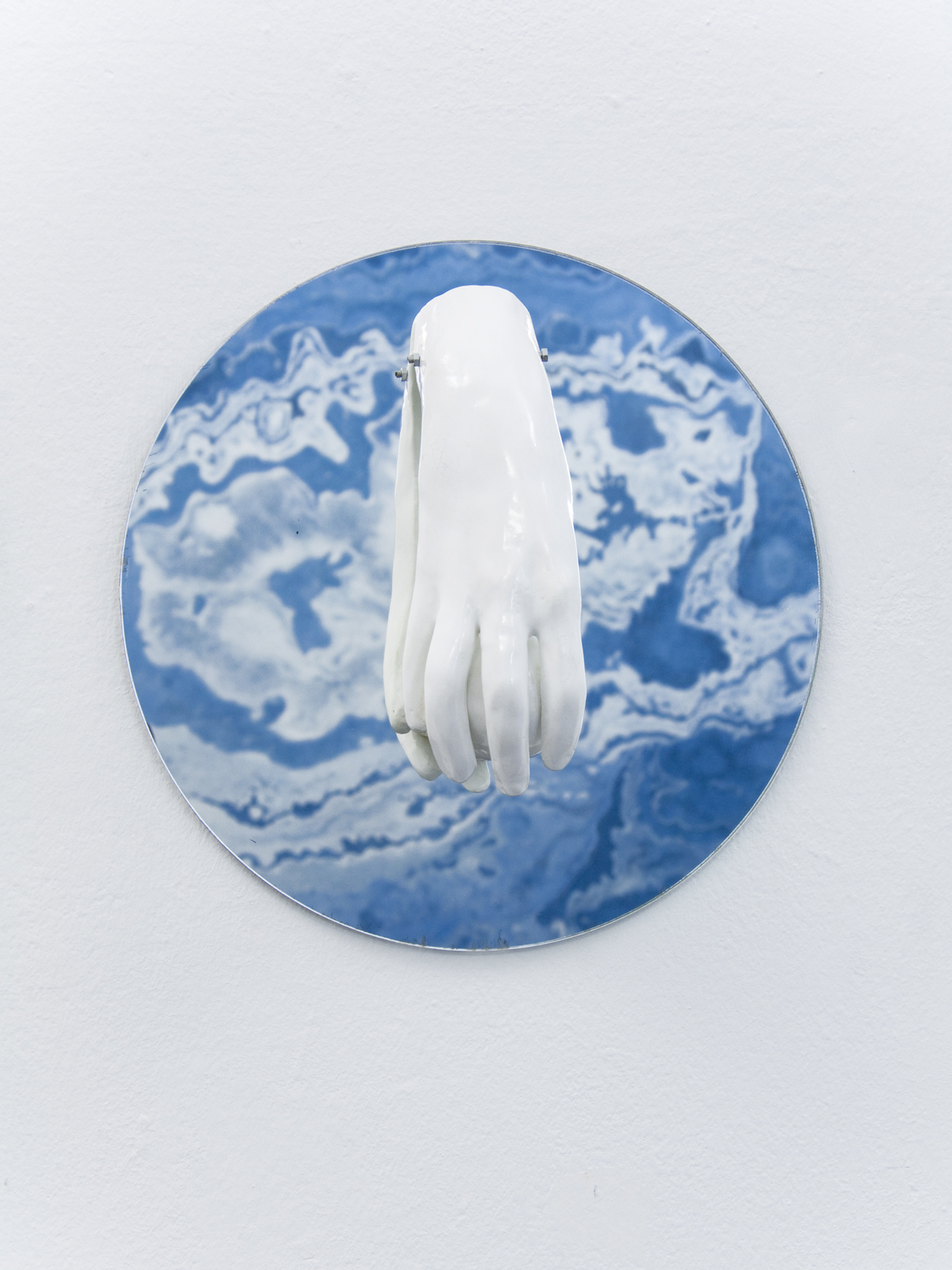
Distanza e menzogna, 2006
Porcelain, mirrors
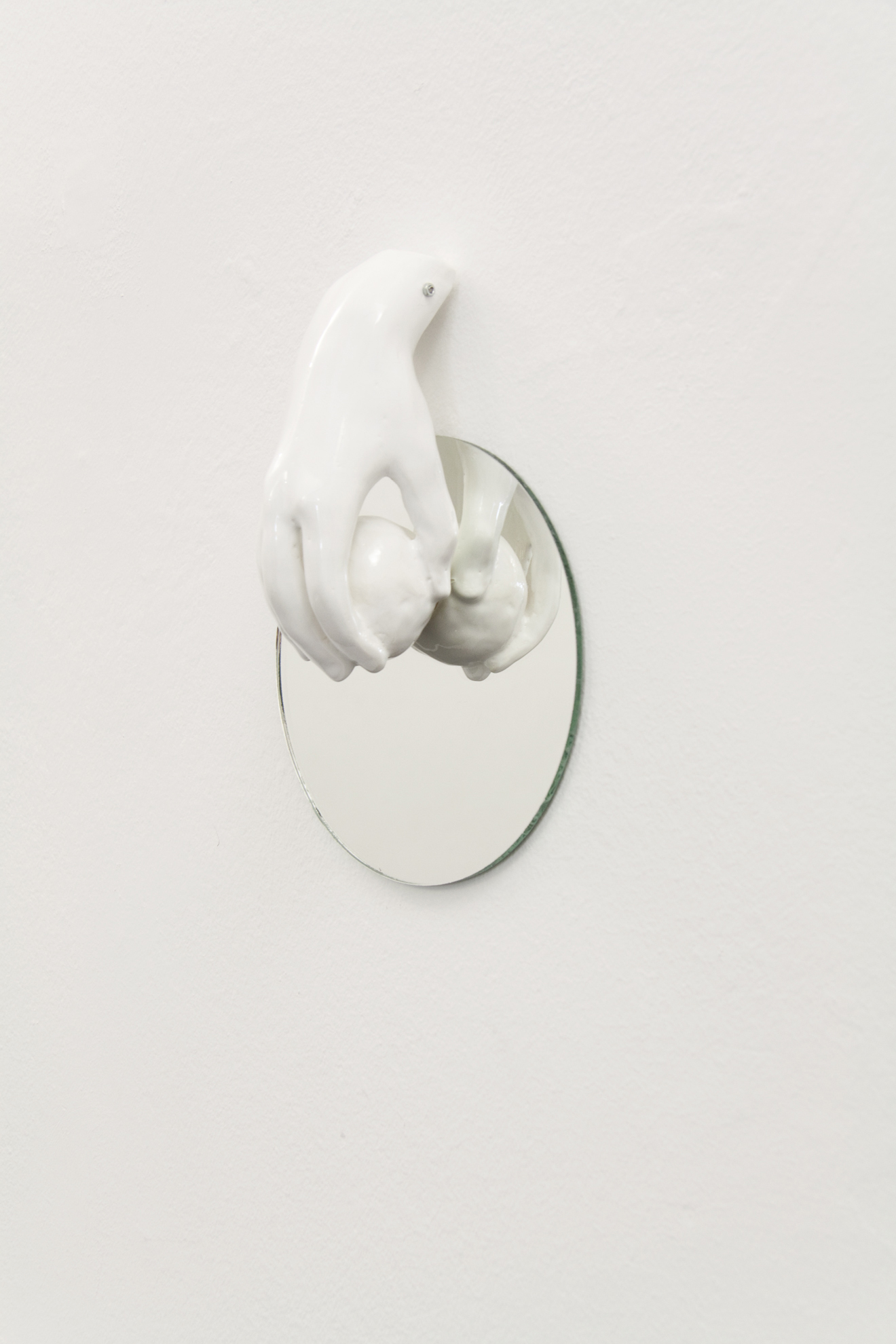
Distanza e menzogna, 2006
Porcelain, mirrors
AB What will you present at pinksummer for your first solo show in Italy?
MCD Figures don’t lie but liars can figure, includes friends and relatives of Echo, characters who are in a constant dialogue with their surroundings, establishing conversations that transform their shape constantly.
The exhibition is the starting point of a new project. This journey will evolve on a series of fables of uncomfortable objects, a portrait of contemporary society through the eyes of non-humans. A compilation of succinct stories featured by animals, mythical creatures, plants, inanimate objects, machines and forces of nature.
The anthropologist James Clifford gives a good example of how an exhibition of uncomfortable beings would look like:
“We need exhibitions that question the boundaries of art and of the art world, an influx of truly indigestible “outside” artifacts. The relations of power whereby one portion of humanity can select, value, and collect the pure products of others need to be criticized and transformed. This is no small task. In the meantime one can at least imagine shows that feature the impure, “inauthentic” productions of past and present life; exhibitions radically heterogeneous in their global mix of styles; exhibitions that locate themselves in specific multicultural junctures; exhibitions where nature remains “unnatural”; exhibitions whose principles of incorporation are openly questionable.”
Uncomfortable objects can just be looked with estrangement. Estrangement thus becomes a tool that is part of the creative process, implying an oscillation between understanding and not understanding. Making us conscious of the way we create narratives, discourses and histories, it alerts us to the opposition between the fragmentary nature of knowledge and its inherent tendency toward completion.
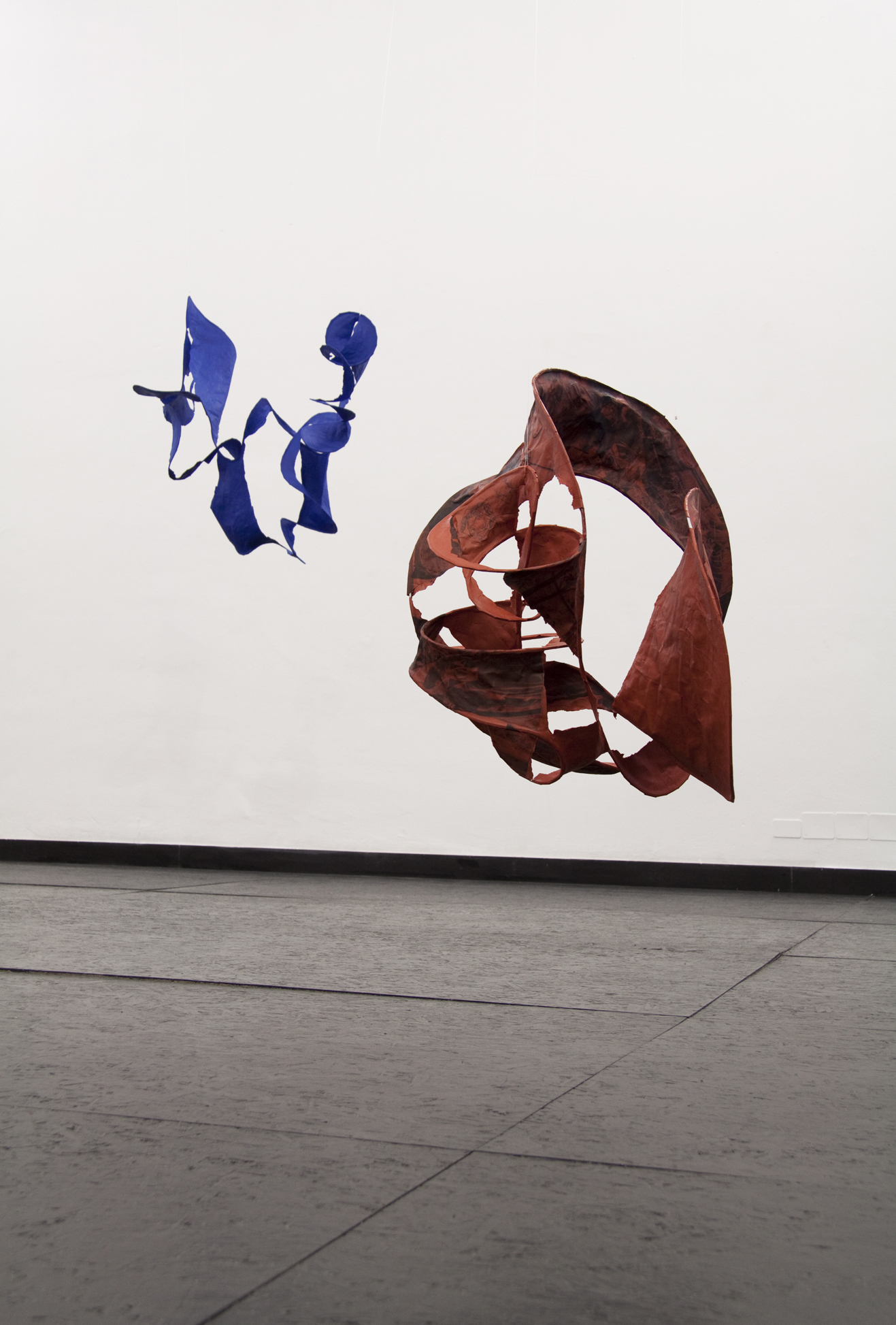
Agua via, 2011
Colored cement, acrylic paint. glaze, microcrystalline wax
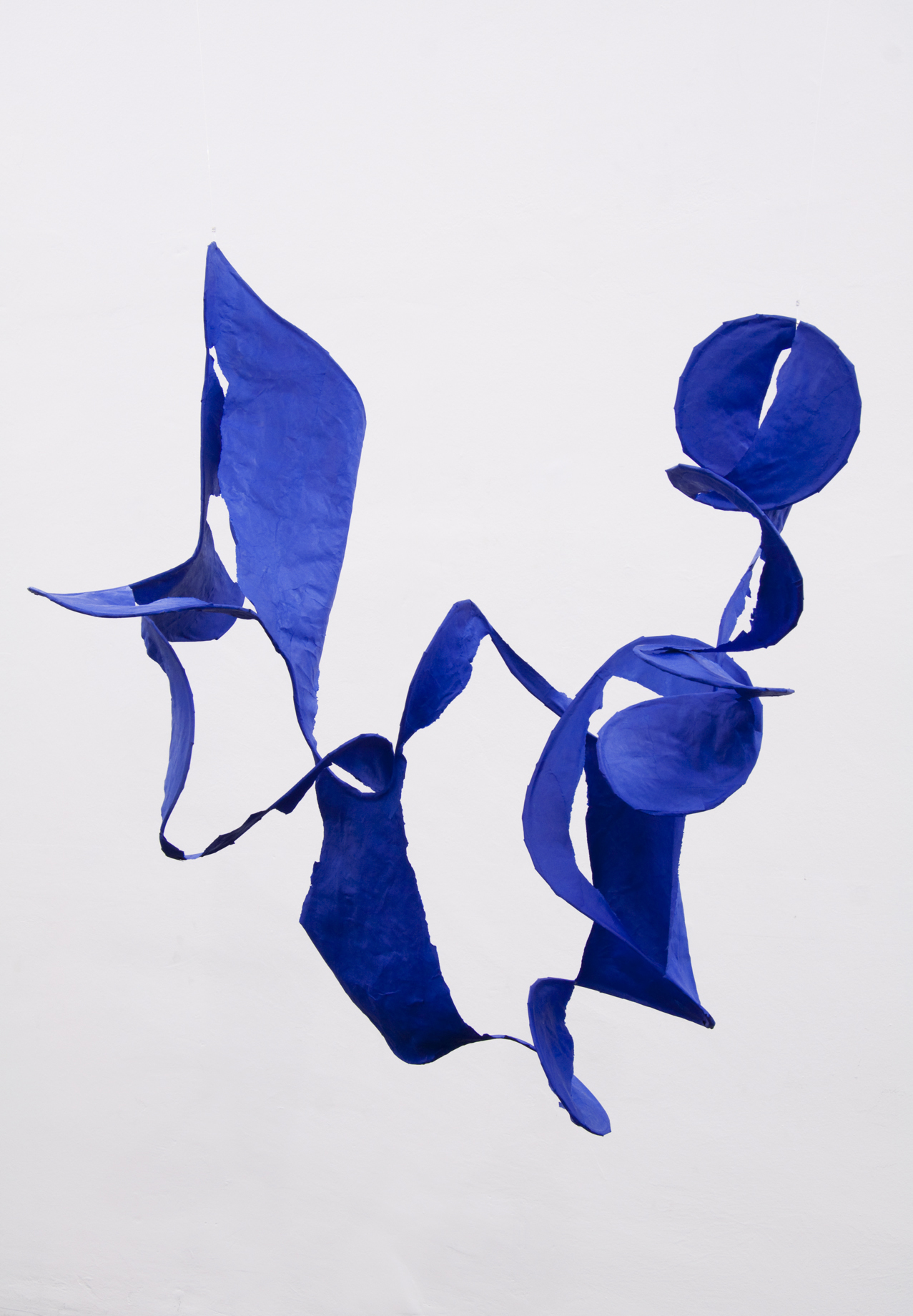
Il filo e le tracce, 2011
Aluminum, ink, papier mâché
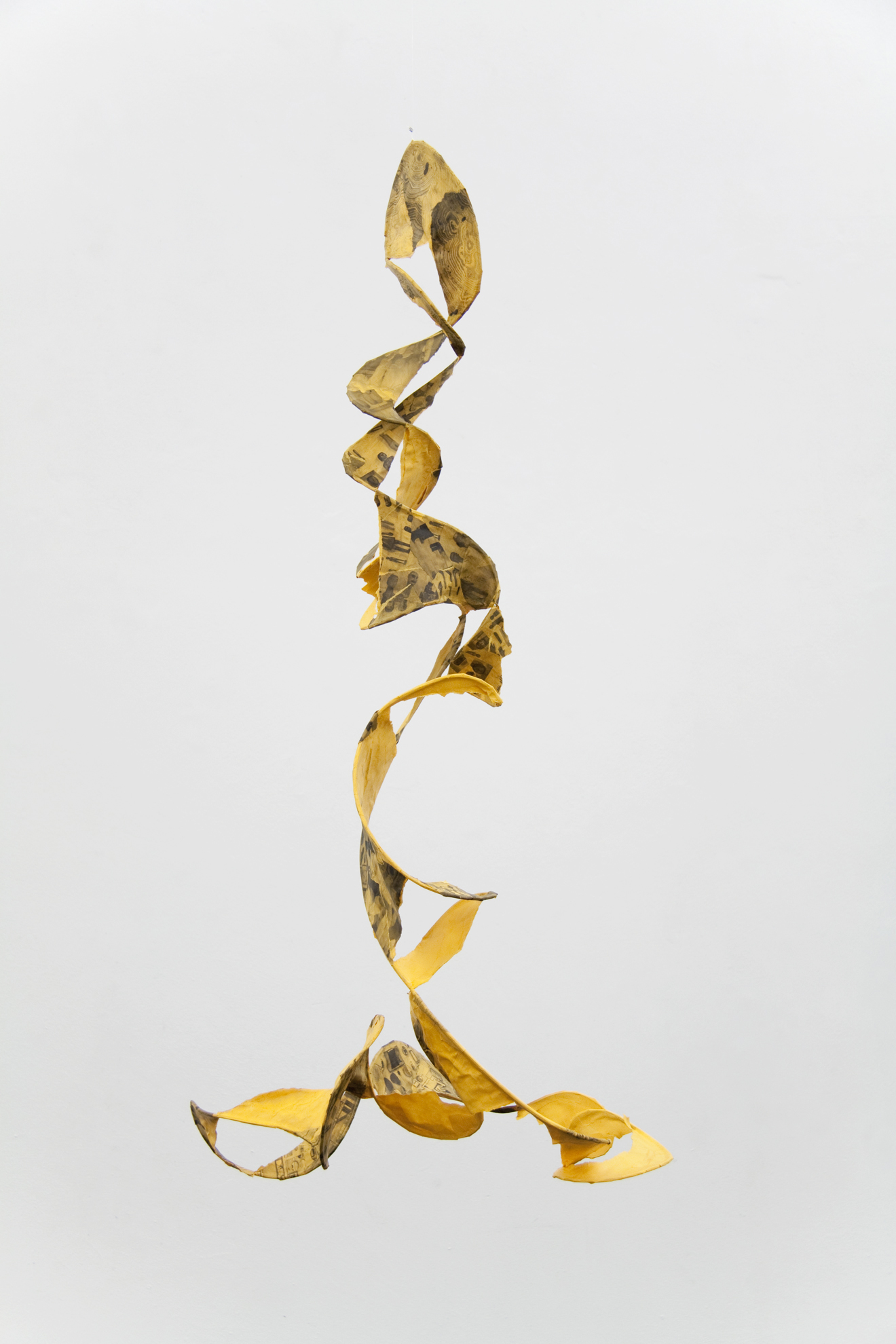
Microhistoria, 2011
Paper-mâché, aluminium wire, laser prints
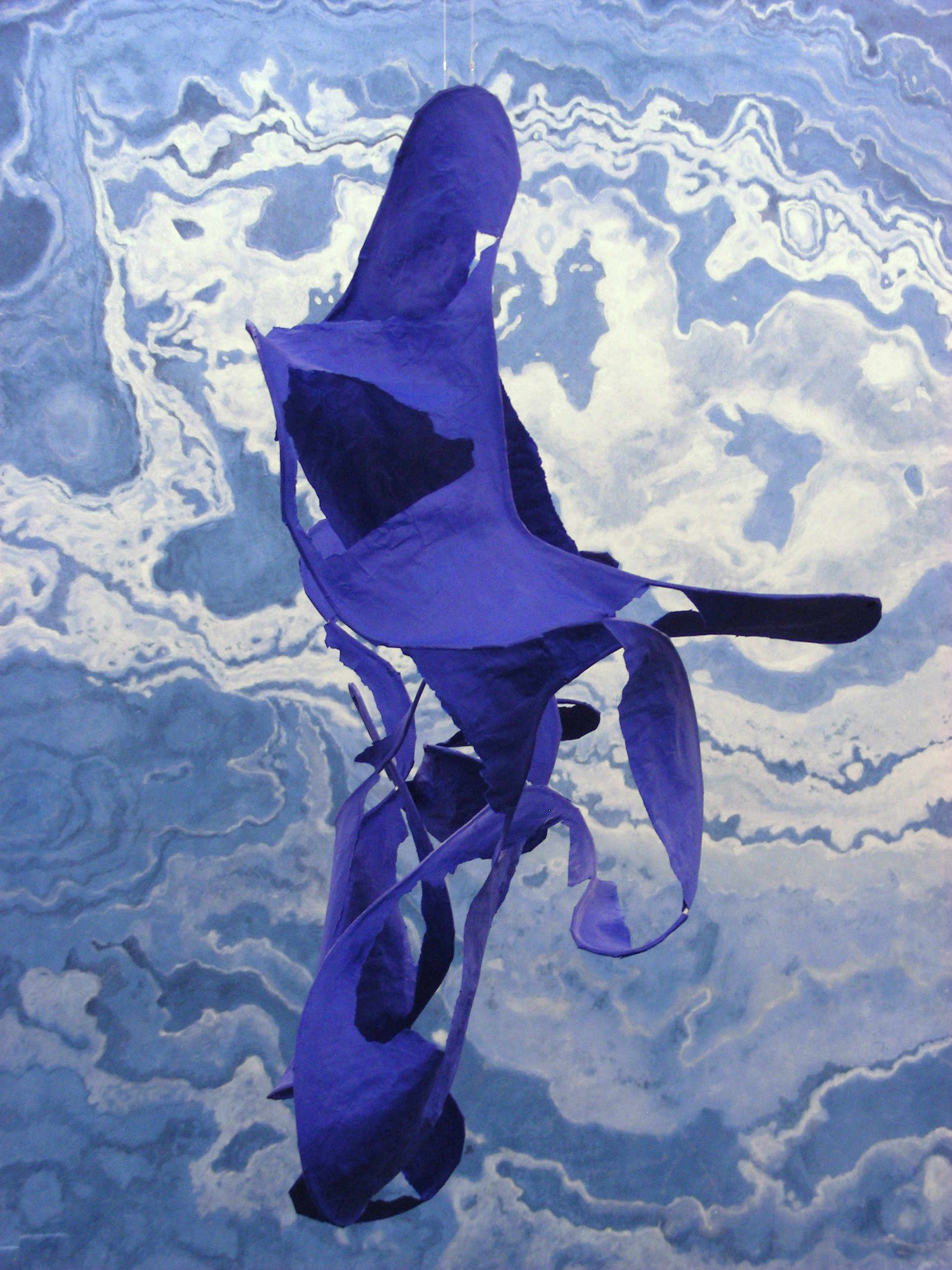
Il filo e le tracce, 2011
Aluminum, ink, papier mâché
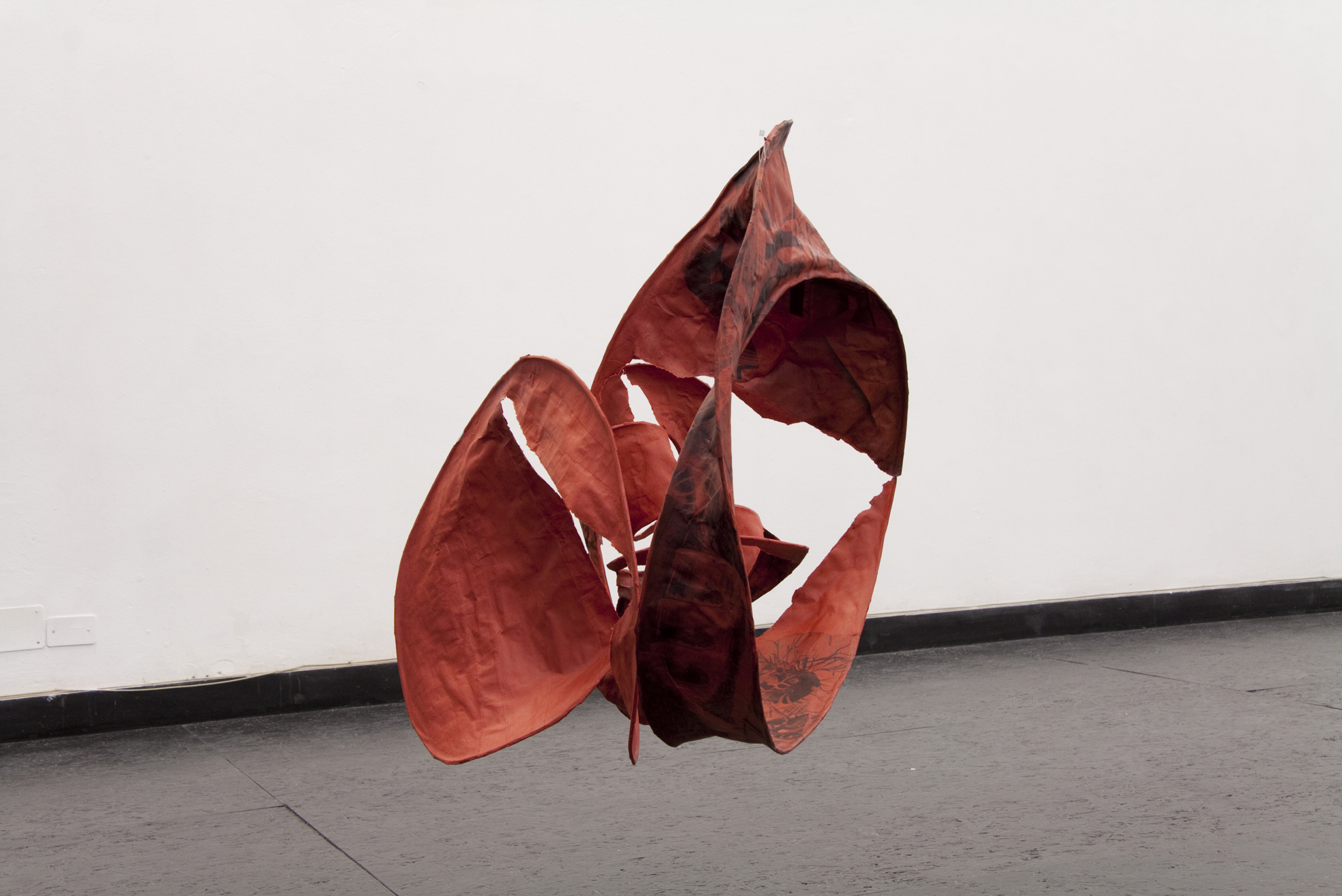
Straniamenti, 2011
Aluminum, ink, papier mâché
Related publications
